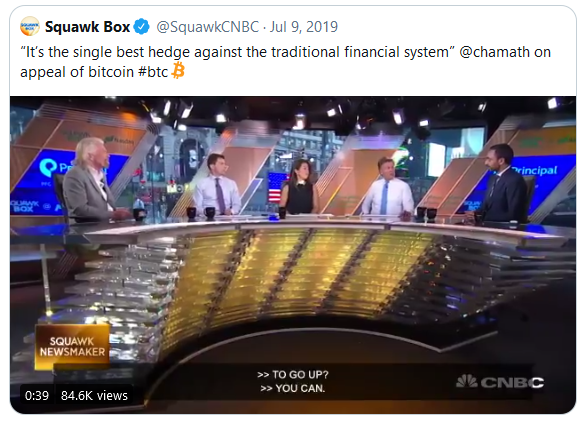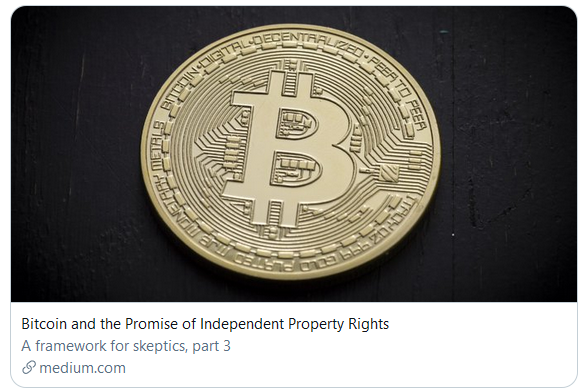 WORDS is a monthly journal of Bitcoin commentary. For the uninitiated, getting up to speed on Bitcoin can seem daunting. Content is scattered across the internet, in some cases behind paywalls, and content has been lost forever. That’s why we made this journal, to preserve and further the understanding of Bitcoin.
WORDS is a monthly journal of Bitcoin commentary. For the uninitiated, getting up to speed on Bitcoin can seem daunting. Content is scattered across the internet, in some cases behind paywalls, and content has been lost forever. That’s why we made this journal, to preserve and further the understanding of Bitcoin.
Donate & Download the November 2020 Journal PDF Donate & Download the November 2020 Journal ePUB

Bitcoin is the Most Sustainable Money The World Has Ever Seen
By Gael Sánchez Smith
Posted September 15, 2020
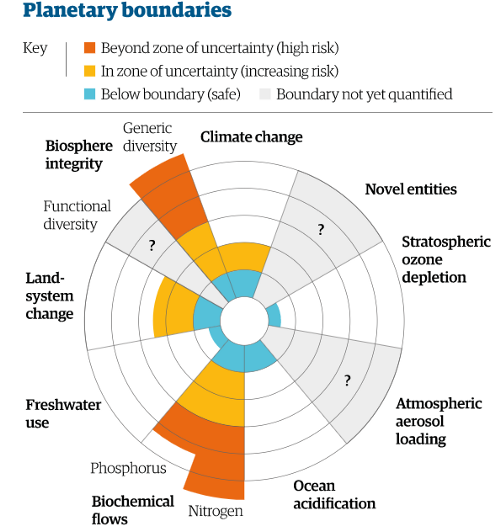 Planetary boundaries: Guiding human development on a changing planet (2015)
Planetary boundaries: Guiding human development on a changing planet (2015)
One of the greatest challenges facing the world is ensuring economic progress is undertaken in a way that doesn’t impose an insurmountable cost to the planet.
Scientists have been warning for decades that the current rate of environmental degradation puts humanity on the brink of disaster and yet the economic machine continues unfettered, eating away at the planet’s life support systems.
In a recent report, researchers point out that four of the nine worldwide processes that underpin life on earth have exceeded the “safe zone”, including anthropogenic climate change, loss of biodiversity, soil and freshwater depletion & ocean acidification.
Many argue that the environmental damage should be tackled through government taxes and regulations, others go as far as calling for the end of capitalism and a return to socialist economic planning. History teaches us that the latter would lead to a disaster that would not only fail in its alleged goal of creating a more sustainable world, it would also impoverish society like every other centrally planned economy of the past.
The radical proposals coming from the extremes of the environmentalist movement make it all the more pressing for lovers of capitalism, free markets and liberty to take ecological challenges seriously and to propose solutions. In this regard, there is one central area of every economy that remains largely unscrutinized but could contain part of the solution, namely the monetary system.
Bitcoin is widely criticized for its high carbon footprint, which, according to the most recent researchers, is estimated around 17 megatonnes of CO2 per year, about the same as the country of Croatia. This increase in carbon emissions couldn’t have come at a worse time, with the world rapidly approaching the 2 degree warming level, which would prove catastrophic for many parts of the world. However, CO2 emissions aren’t an inherent feature of the Bitcoin network and they most certainly won’t be a problem in the long run; let me explain:
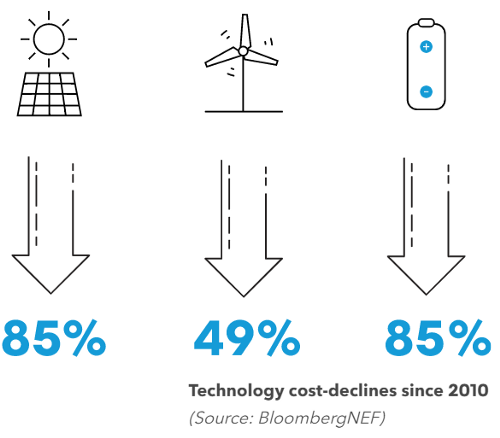 Bloomberg New Energy Finance (2019)
Bloomberg New Energy Finance (2019)
Bitcoin’s carbon footprint is caused by its high electricity consumption, which is needed to secure the decentralization of the network. However, at present more than 35% of the world’s electricity is produced from renewables+nuclear and in the U.S. the figure is even higher, with 38% of electricity being carbon-free. Furthermore, the exponential cost declines of solar and wind over the past 10 years means they are already the cheapest electricity sources across two thirds of the world.
As efficiency improvements continue reducing the cost of generating and storing renewable energy, solar and wind will become the cheapest sources of energy across the globe. Once the availability and intermittency of renewables is solved, fossil fuels will be removed from the world’s energy grid and the Bitcoin network will be 100% carbon-free.
Monetary Policy & Environmentalism
Many of the environmental challenges highlighted at the start of this article can be partially attributed to the fiat monetary system, which has been imposed upon the world:
- The Keynesian obsession with maintaining an ever-expanding rate of aggregate demand, rising government spending to prop up GDP or monetary expansions to punish hoarding, results in high rates of environmental degradation for short-term gains in consumption and investment.
- The overconsumption of natural resources during the malinvestment phase of the business cycle is caused by fractional reserve credit expansion. The relationship between credit expansion and environmental degradation has been pointed out by Jesus Huerta de Soto, who notes how “credit expansion hinders sustainable economic development and needlessly damages the natural environment.”
- Inflationary currency depreciation lowers the incentive to hold cash balances and incentivizes individuals to consume in the present. Consumerism contributes to environmental degradation associated to the manufacturing and distribution of consumer goods.
- Inflationary currency depreciation incentivizes individuals to invest in projects that offer negative real returns, simply to minimize the loss in purchasing power of their savings. These investments are not only destructive of society’s capital stock, many of them also have negative consequences on the environment.
Under a Bitcoin standard, the above-mentioned forms of social engineering would be impossible and consequently, the environment would be given a very much needed breath of fresh air:
- Manipulations of aggregate demand through monetary expansion would be impossible since the monetary supply is capped and stimulus programs would be limited by the government’s fiscal position.
- Business cycles and their resulting malinvestments wouldn’t occur since fractional reserve banking is unfeasible without a central bank. Under a Bitcoin standard, market interest rates would do what they are supposed to do; communicate the time, risk and liquidity preferences of market participants.
- Bitcoin’s fixed money supply introduces incentives for individuals not to spend in the present, since money appreciates over time reflecting gains in productivity. Additionally, only investments that offer a return above the rate of deflation would be undertaken.
A Bitcoin economy would likely be one with more sustainable levels of consumption and investment; in a sense it might resemble the degrowth economy advocated by many environmentalists. The availability of a store of wealth that offers a risk free return would give people the peace of mind and the time required to engage in non-economic activities. Spending less time in the mall and in the factory wouldn’t make society poorer, on the contrary, it would allow individuals to focus on family, friendships, charity, spirituality, religion or whatever they believe will bring them closer to “the good life”.
In his magnum opus, The Bitcoin Standard, Saifedean Ammous explains how the fetishization of growth has been massively destructive of economic progress. In this article, I contend that it has also led us on a path of utter destruction of the environment, putting in danger the very prospect of life on the only home we’ve ever known, a pale blue dot within a boundless, dark night.
 The phrase “Pale Blue Dot” was coined in 1990 by Carl Sagan during his reflections on the importance of preserving life in the universe.
The phrase “Pale Blue Dot” was coined in 1990 by Carl Sagan during his reflections on the importance of preserving life in the universe.
References
- https://about.bnef.com/new-energy-outlook/
- https://www.theguardian.com/environment/2015/jan/15/rate-of-environmental-degradation-puts-life-on-earth-at-risk-say-scientists
- https://www.newscientist.com/article/2224037-bitcoins-climate-change-impact-may-be-much-smaller-than-we-thought/
- https://en.wikipedia.org/wiki/List_of_countries_by_carbon_dioxide_emissions
- https://mises.org/library/some-additional-reflections-economic-crisis-and-theory-cycle
- https://nakamotoinstitute.org/mempool/fractional-reserve-banking-is-obsolete/
Our Most Brilliant Idea
By Robert Breedlove
Posted November 1, 2020
Ideas ambulate humanity across history. A new and useful idea is an innovation, which can benefit everyone for the rest of time. Therefore, it is critical we construct socioeconomic structures conducive to the creation of new ideas: civilization can only advance amid an everlasting flow of fresh knowledge. Free trade is the means by which we maximize ideation and its physical manifestation: wealth creation. Anything that impedes trade—like central banking—is (by definition) a terrible idea. Contrarily, all accelerants to free trade—like money—are among the most brilliant ideas we’ve ever had.

Ideas Drive Economics
“A pile of rocks ceases to be so when somebody contemplates it with the idea of a cathedral in mind.” — Antoine De St-Exupery
Ideas are the origins of everything we say, do, or make. The purpose of any economy is to generate and share useful ideas through free trade (to achieve what economists call the division of labor or knowledge specialization). Civilization emerges not by an aimless concourse of variation, but rather it is molded in the image of our ideas, which we express through action to remake the face of the Earth. Better ideas, or sharper knowledge, equip mankind to more intelligently harness the gifts of the Earth to satisfy his wants to ever-higher degrees in ever-less time. In ideological space, competition is free and fierce: only the most useful ideas survive the test of time. Resultant knowledge encodes the patterns of action we use to etch our imaginations into the world around us. Winning ideas are chosen by the market, only to be widely distributed as material riches, finer manners and morals, and more profound art. Our lives are lived enacting our ideas. As HG Wells said:
“Human history is, in essence, a history of ideas.”
Or as William Durant elaborates:
“History as a laboratory rich in a hundred thousand experiments in economics, religion, literature, science, and government—history as our roots and our illumination, as the road by which we came and the only light that can clarify the present and guide us into the future.”
Pouring forth from our forebears is this civilizing heritage of ideas sharpened through free trade and expressed in the tools, techniques, and cultures we make for ourselves. As we trade, our ideas become better, giving everything we say, do, or make more want-satisfying qualities. Consider how our language has evolved from grunts to enunciations, or how our behaviors have been shaped by culture, or how our transportation technologies have progressed from wagons to airplanes. Substantive ingredients for all modern miracles surrounding us today have always been available, but prior to their invention, we simply lacked the ideas necessary to manifest them. As the living generation responsible for ideation, our aim must be to forge our ideas into finer form for posterity: an aim we accomplish through innovation.

Ideally, our civilization is the manifestation of our most useful ideas.
Innovation is simply a reconfiguration of the “raw materials” of nature by indexing them to our most useful idea structures. Said differently: creativity is taking known elements and reassembling them in accordance with new knowledge. Sharpening knowledge to better satisfy ourselves requires fires from the ideological collisions and frictions innate to trade. Trade, then, is mankind’s “meta-idea” — the generative idea of all our best ideas. Meta (from the Greek μετά, meaning “after” or “beyond”) is a prefix meaning more comprehensive or transcending: trade is an idea about improving ideas. It presupposes that anyone may know something everyone else does not, incentivizes them to teach the rest of us, and lets us all capitalize on any such learning opportunities. Trade indicates to us whether we are ill-informed in the pursuit of a goal, which can save us from harm, or help us achieve it more easily. Wealth generation is inseparable from ideation: the more we know, the more effortlessly we satisfy our (present and potential future) wants through innovation, and the more wealth we gain. Author Matt Ridley captures the spirit of this relationship between free trade and innovation in these words:
“Innovation is the child of freedom and the parent of prosperity.”
Free market capitalism is an idea unequaled in its generation of innovation. It proved itself as the most successful economic model for expanding trade, ideation, and wealth creation in the 20th century ideological contention between American capitalism and Soviet communism. Misguided by utopian promises, Soviet Russia attempted to replace the profit motive intrinsic to American capitalism with appeals to nationalistic faith and devotion, thereby poisoning the wellspring of learning engendered by trade. Under the moralistic camouflage of communism (“from each according to their ability, to each according to their needs” was the Marxist slogan) some of the most gruesome atrocities in history were perpetrated. Soon into the Soviet experiment, productivity collapsed, and millions starved or were slaughtered by the state. When governments play God, civilizations burn in hell. Soviet Russia rediscovered what wise Aristotle had warned centuries earlier:
“When everybody owns everything nobody takes care of anything.”
American capitalism outcompeted Soviet communism. Capitalism is a socioeconomic system premised on the three pillars of private property rights, rule of law, and honest money. Private property rights represent an exclusive relationship between individuals and any portion of nature they invest their time in reshaping; rights they can then exchange with similarly self-sovereign people. Rule of law is a mechanism for nonviolently resolving private property disputes. Honest money is the private property unimpeded market processes naturally select as most tradable. Since capitalism optimizes for trade, it supports this generative source of new ideas by incentivizing economic cooperation and (peaceful) competition. Indeed, the stability of rules is the bedrock of peace: with fixed and simple laws, market participants are forced to play the game well to make an honest living. As Bastiat said:
“When goods don’t cross borders, soldiers will.”
In an elemental sense, trade is the water that sustains innovation, and its steadfast flow a source of peace. Capitalism is the socioeconomic “water well” built to protect this everlasting ideological wellspring of civilization—trade.

Capitalism is a socioeconomic “water well” which protects our wellspring of ideas: trade.
The Idea Supercomputer
“Great minds discuss ideas. Average minds discuss events. Small minds discuss people.”—Eleanor Roosevelt
As the ultimate token of trade, money is an indispensable tool for ideation. In trade, everything is valued at some ratio of everything else. For instance, a car might be worth 132 chairs, or a house worth 11 cars. Money is the medium through which we more easily calculate these exchange ratios: a tool that simplifies trade by standardizing its intermediation. Like all tools, money lets us achieve greater results with less efforts, and the time-savings tools impart is wealth. Specifically, money lets us calculate, negotiate, and execute trades more quickly. Without money, a constant recalculation of countless exchange ratios among different economic goods would be necessary. With money, all exchange ratios are compressed into a single number — the money-expressed market price. In this way, money is an accelerant to trade and (its invisible twin) ideation. Standardization to one money creates economies of scale in trade. Such economization is what drives the market to coalesce around a single money — as we saw with gold and (its former currency abstraction, and now apparition) the US dollar:
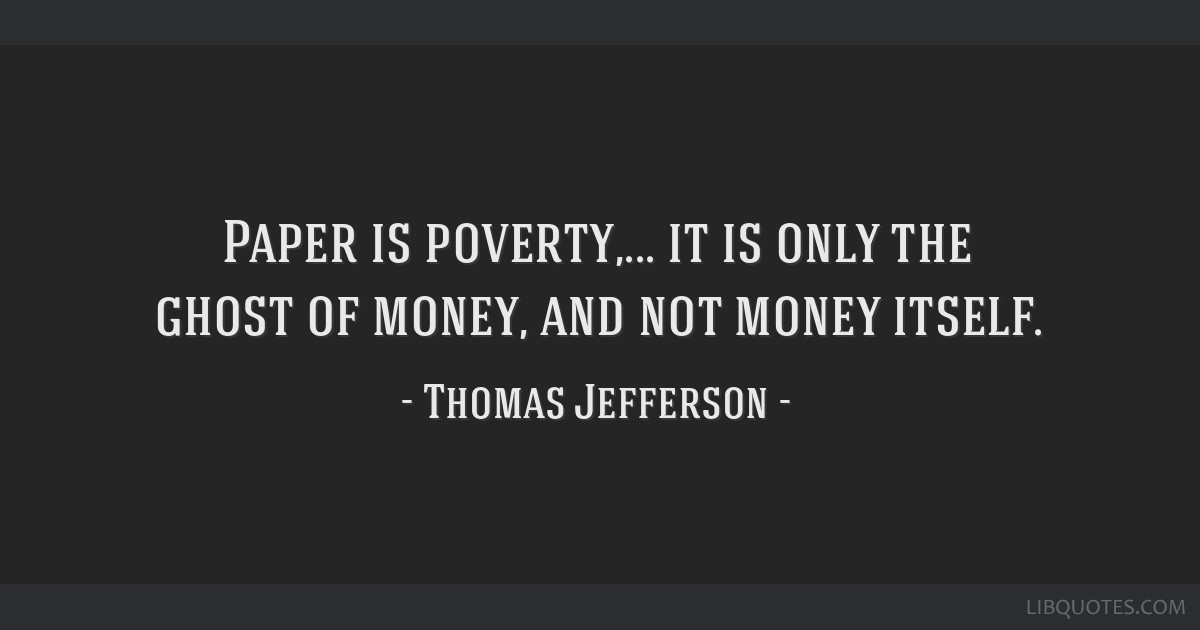
America’s founding fathers knew the dangers of falsifying money.
Money is the medium through which market participants express their ideas, preferences, and values. Pricing systems are economic telecommunication networks endlessly echoing and coordinating market action by dynamically informing everyone of everyone else’s trades. For instance, when you buy a car and sell a house, the economy responds adaptively by producing more cars and less houses. Even when you buy a public equity, you are expressing the idea its expected future cash flows are worth more than its current price, and the marketplace absorbs this thesis when you execute the trade. Price signals perpetually prime incentives to ensure resources are allocated in accordance with the current aggregate composition of market participant preferences. Entrepreneurs engaging in trade give rise to truthful pricing as they strive to buy low, sell high, and profitably serve one another. A true free market is a forum of unhampered and voluntary exchange where ideas compete, combine, and transform. Seen this way, the free market may be considered the ultimate distributed computing system — a nexus of consciousnesses driven by human action and interconnected by prices.
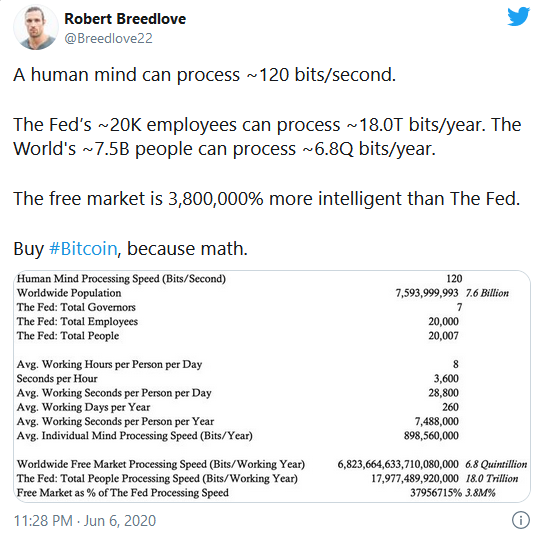 The distributed computing power of the free market is the most intelligent system in the world.
The distributed computing power of the free market is the most intelligent system in the world.
Money improves the extensibility of our minds. Thinking is an expression of rationality: the act of comparing all relevant factors to any course of action. By cognitively generating different aspects and avatars relevant to any given situation, humans create mental staging areas for future action. As with the root word of rationality — ratio — thinking involves contrasting one thing against another. When we extend our thinking into money, we gain insight into the collective mind of other market participants through price signals, which themselves are expressions of rationality: ratios of exchange denominated in monetary terms. By consolidating the rationality of all market actors into the market price, ideation explodes. In this way, free markets are idea-generating supercomputers. This is why American innovation is unrivaled. Mankind makes the world his own by channeling energy across the ideological field lines fashioned in his extended mind—the free market.
Free Markets are Free Thinking
“Man’s mind, once stretched by a new idea, never regains its original dimensions.”—Oliver Wendell Holmes
Contrary to popular misconception, money is not a government creation. Money is emergent—it is simply the most tradable good in any given market. As people seek to satisfy their wants through trade, they steadily seek to trade their goods for more tradable goods to get closer to obtaining the object(s) they desire. As this process unfolds, a certain asset gains the highest liquidity—whether it is salt, cattle, or gold—this most exchangeable good is (by definition) money. Money, then, is an inexorable outcome of free trade.
As global markets converged, they coalesced around precious metals as money due to their superior monetary properties of durability, divisibility, portability, recognizability, and scarcity. Gold—which excelled all other metals in scarcity—became the dominant money of the world precisely because its supply was the least changeable. Central banks eventually coopted gold and built a pyramid scheme on it called fiat currency. When central banks monopolized the market for money, it became unfree. Violating free market capitalism, as Soviet Russia learned the hard way, is a really bad idea—it runs countervailing to the natural human proclivity for trade, ideation, and wealth generation. As Marcus Aurelius poeticizes our capacity for collaboration:
“We were born to work together like feet, hands, and eyes, like the two rows of teeth, upper and lower. To obstruct each other is unnatural.“
Clearly, obstructing the ability of market participants to express their ideas through trade is a breakdown in the “rules” of capitalism. All frictions on free trade are dissipative to both innovation and wealth creation. A true capitalist society necessitates unbreakable rules of trade such as equitable rule of law, inviolable private property rights, and unstoppable honest money. In such a pure capitalistic system, individuals would have no way to create value for themselves other than giving society what it wants (even if its wants are as yet unarticulated). But our over-regulated world today is a far cry from this ideal.
All regulations are limitations on free market forces that constrict ideation and its physical manifestation: wealth creation. The ultimate expression of legal regulation is monopolization, in which all peaceful competition is suppressed through coercion or violence. In the world today, the market for money is not a free market, as it is forcibly dominated by cartels of central banks — legal monopolies that distort prices, reduce trade, and interrupt ideation. Tellingly, central banking was also a key component of Soviet communism—an exclusive state-owned banking monopoly was the 5th measure in Marx’s 1848 Manifesto to the Communist Party. True capitalism has never existed, precisely because the rules of money have always become twisted by interventionists pursuing their own pecuniary gain in every market known to history. Legal impediments erected by governments to insulate central bank monopolies on money from free market capitalism are manifold. Such artifice destroys accountability, ingenuity, and virtue.
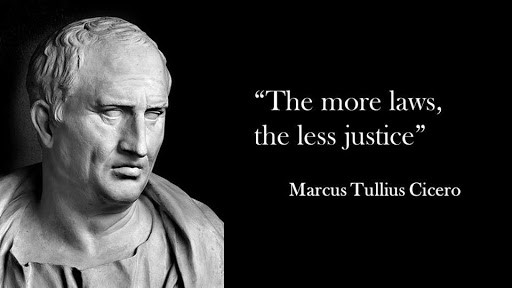
With unbreakable capitalistic rules, the “game” of macroeconomics would impose an organizing principle onto humanity, encouraging us to find better ways of saying, doing, or making things by betting against each other in the marketplace as opposed to lying, stealing, or taxing. When rules cannot break, play is fair, and want-satisfactions escalate. As “players” prove one another wrong in the marketplace—by discovering and selling better means of satisfying wants—the resultant productivity gains diffuse into society through trade. An environment conducive to continuous learning at scale is cultivated through capitalism. Said differently: when ideas compete freely, more wealth is created—most often in the form of better tools, services, or knowledge. Mises describes this inextricable relationship between ideation and market competition in his masterwork Human Action:
“But competition does not mean that anybody can prosper by simply imitating what other people do. It means the opportunity to serve the consumers in a better or cheaper way without being restrained by privileges granted to those whose vested interests the innovation hurts. What a newcomer who wants to defy the vested interest of the old established firms needs most is brains and ideas. If his project is fit to fill the most urgent of the unsatisfied needs of the consumers or to purvey them at a cheaper price than their olde purveyors, he will succeed in spite of the much talked of bigness and power of old firms.”
To use Ray Dalio’s term: free markets are idea meritocracies: unhampered trade networks that incentivize the cultivation and infusion of the best ideas into civilization. Implicit in the meta-idea is the presupposition innovation can only be nurtured, not legislated. Here, the ignorance of MMT advocates clamoring for “the activation of idle capital through inflation” rears its head: proceeds from theft via inflation can mobilize people and capital, but only in an unintelligent way since bureaucrats lack both the accountability and distributed computing power endogenous to the free market, and only until this parasitization of value from the productive economy kills it. In simple economic terms: free markets make mankind more productive; monopolies, or unfree markets, make mankind less productive. Further, the condition of our collective mind closely mirrors the state of our money. We only think in dollars today because they were once redeemable for gold. Central banks have hijacked the monetary extensibility of our minds (the old “bait and switch” tactic), and corrupted our capacity to perceive the world clearly:
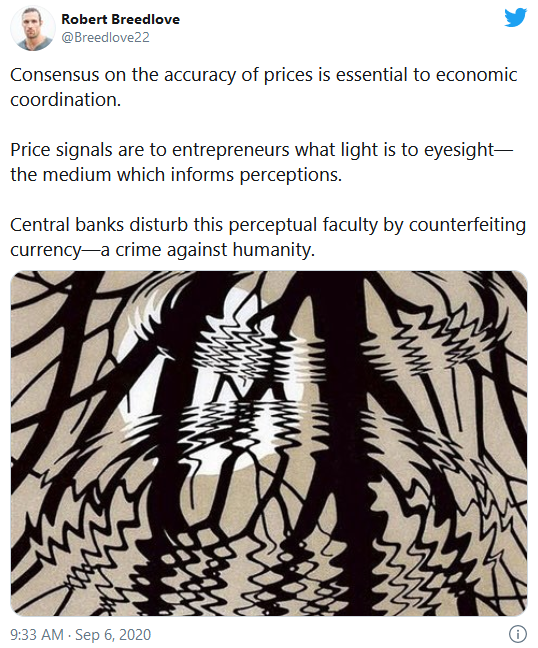
Central banking distorts market pricing by counterfeiting currency.
Free minds need freely selected money. By embracing a free market paradigm in the totality of our actions we become more free thinking, intelligent, and wealthy. Another way to think about the free market is as a system of error detection and correction: through prices, it incentivizes the discovery and resolution of unsatisfied wants (socioeconomic errors). Central bank induced inflation distorts this error correction system, and causes dissatisfactions to swell. This market manipulation is (ostensibly) justified by the self-deceptive intentionality of central bankers to “manage the economy,” as if any human had ever successfully managed any complex system without triggering a cascade of unintended consequences. Conviction in the utility of their necessarily limited knowledge, as opposed to the free market processes which continually revivify knowledge, is the black core of central bank malevolence. As John Milton, author of Paradise Lost, brilliantly observed:
“Evil is the force that believes its knowledge is complete.”
Central banks could repent merely by admitting this gargantuan error in ideology, and letting the free market clear its 100+ years of errors. This would be painful at first, but undoubtedly in the long-term best interests of civilization—like a drug addict finally entering rehabilitation. But hubris and greed will almost certainly prevent such an ideal outcome. To summarize the argument: free market pricing is an error-clearing system, and central banking ameliorates its capacity for error detection and correction; acting as if its knowledge of markets is complete, central banking is evil incarnate—an institution of economic tyranny as misguided as Soviet Russia. In the ideological sphere, freedom is as creative as tyranny is destructive.
The Greatest Idea of History
“An Idea Is Salvation By Imagination.” — Frank Lloyd Wright
Quintessential to the idea of any money is that both present and future market participants will freely accept it in trade. The likelihood of a money to be accepted by the broadest possible set of trading partners is largely based on how reliably it maintains its scarcity across time. To maximize this store of value function, a money must be resistant to misappropriation—whether by inflation, counterfeit, or confiscation (all of which are theft). The money most resistant to involuntary exchange (aka theft) tends to become the most widely adopted voluntary medium of exchange. Put another way: in free market competition the most theft-proof money wins. Those who erroneously choose a less theft-proof money are disfavored by market processes when their wealth is compromised by thieves through inflation, counterfeiting, or confiscation. Another way to say it: market participants adopt the money which minimizes the need to trust one another. Central banks continue to hoard gold because it is trust-minimized money. Bitcoin exhibits even greater trust-minimization qualities, and is therefore disruptive to gold.
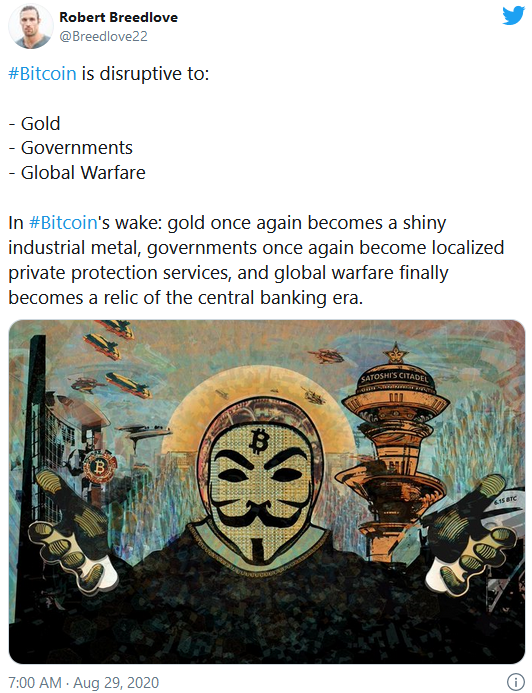
Bitcoin is a renaissance of free market forces.
Money is the best idea we’ve ever had, for without it, all the other marvelous ideas generated by markets would not exist. As the most tradable thing, money is the highest instantiation of our meta-idea, offering us unbridled optionality in market exchange. As a technology, free-market-selected money maximizes both human freedom and cooperation. Historically, gold reduced the incentives to violence, because it was a more securable form of wealth than food, land, and most other assets. In this way, gold greatly constricted the scope of assets worth fighting over, thereby inducing unparalleled social cooperation, trade, and wealth generation. This has profound moral implications too: when money is hard to steal, society becomes hard working; when it is easy to steal, society drifts toward kleptocracy. Let me state the argument in a single sentence: gold was the greatest tool we ever had to incentivize ourselves to civilize ourselves.
If the aim of humanity is to build civilizations, then our most brilliant idea was the use of gold as money.
The global gold standard improved trade (our meta-idea) in a trust-minimized way and standardized the world to a single monetary protocol—thereby maximizing time-savings in trade and its associated wealth creation (two sides of the same coin). Again, wealth creation is absolutely dependent on ideation: using gold as money led the world into an unequaled effulgence of novel ideas and innovations, ushering in an era known colloquially as both The Gilded Age and La Belle Époque:

La Belle Époque—an era of significant innovation and wealth creation—was also considered the “beautiful age” of painting. This epoch of civilization was built on the idea of gold being used as money.
A brilliant idea indeed, but far from perfect: because gold is physical, it is still vulnerable to theft; and because gold is heavy, economies of scale related to its use as money led to the centralization of its custody in bank vaults (since it is cheaper to transact in paper abstractions of gold than physical gold). An anticapitalist institution—the central bank—festered around these centralized gold hoards. These deceptive and evil institutions operate with flagrant disregard for the tenets of capitalism: central banks are above the law, practice perpetual private property confiscation via inflation, and peddle the most dishonest money in history. All central bank business models are critically dependent on the divisibility, portability, and recognizability shortcomings of gold:
- If gold were perfectly divisible, there would be no reason to abstract it into paper currency
- If gold were perfectly portable, it would be encoded as information and there would be no need to place trust in banking custodians as final settlement could be conducted at the speed of light
- If gold were perfectly recognizable, there would be no economic gain from the “public stamp” of national currencies as anyone could verify the veracity of money themselves instantaneously
Indeed, these technological failings of gold formed the attack surface repeatedly exploited by central banks. Fortunately for citizens of the 21st century, free trade—which has been exponentially enhanced by the internet and digital technologies—has generated an even more brilliant idea that promises a permanent ending to the thieving schemes of central banks.
The Greatest Idea of Modernity
“There Is One Thing Stronger Than All The Armies In The World, And That Is An Idea Whose Time Has Come.”– Victor Hugo
America was founded on the three pillars of free market capitalism: private property rights, rule of law, and honest money. The American Constitution authorized states to issue gold or silver currency, outlawed income tax, and prohibited national central banking. Unfortunately, upon successful implementation of the American central bank (after two failed attempts), the private property rights foundational to free market capitalism became vulnerable to limitless violation via inflation. An example of this failure came with the “Great Gold Robbery of 1933” (aka Executive Order 6102): an unconstitutional decree and blatant violation of private property rights. All government decrees by fiat are lies (including fiat currency), for truth need never be forced. Free market forces always zero-in on truth.
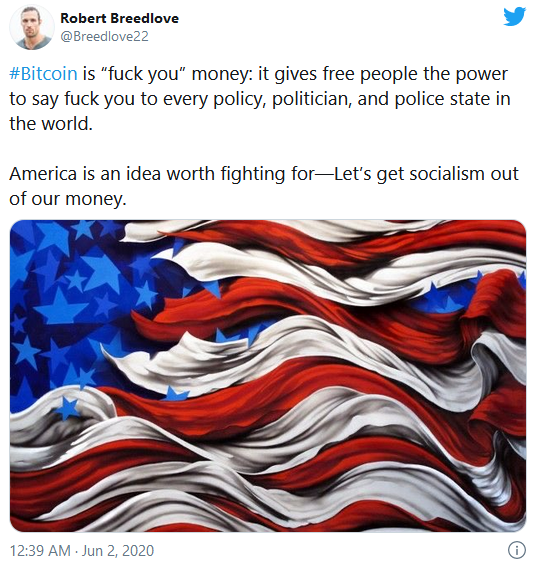
Bitcoin perfectly exemplifies the ideas America was founded upon—it is American AF.
Bitcoin is the ideological synthesis of gold and the internet; it perfectly exemplifies the three pillars of free market capitalism undergirding the idea of America in a form that cannot be perverted by fiat decree. As its money supply cannot be changed, its holders are immune to confiscation via inflation, thus perfecting their private property rights (Pillar 1). Disputes within the Bitcoin network are settled consensually, and it is impractical to employ violence in an attempt to sway this process, thus perfecting the process of nonviolent dispute resolution embodied by the rule of law (Pillar 2). By perfecting these first two pillars of free market capitalism, Bitcoin is a self-fulfilling prophecy predestined to perfect its final pillar by becoming the final evolution in free-market-selected honest money (Pillar 3). As the only sacrosanct money in existence, Bitcoin is purified capitalism: a permanent implementation of the soundest socioeconomic “water well” in history:
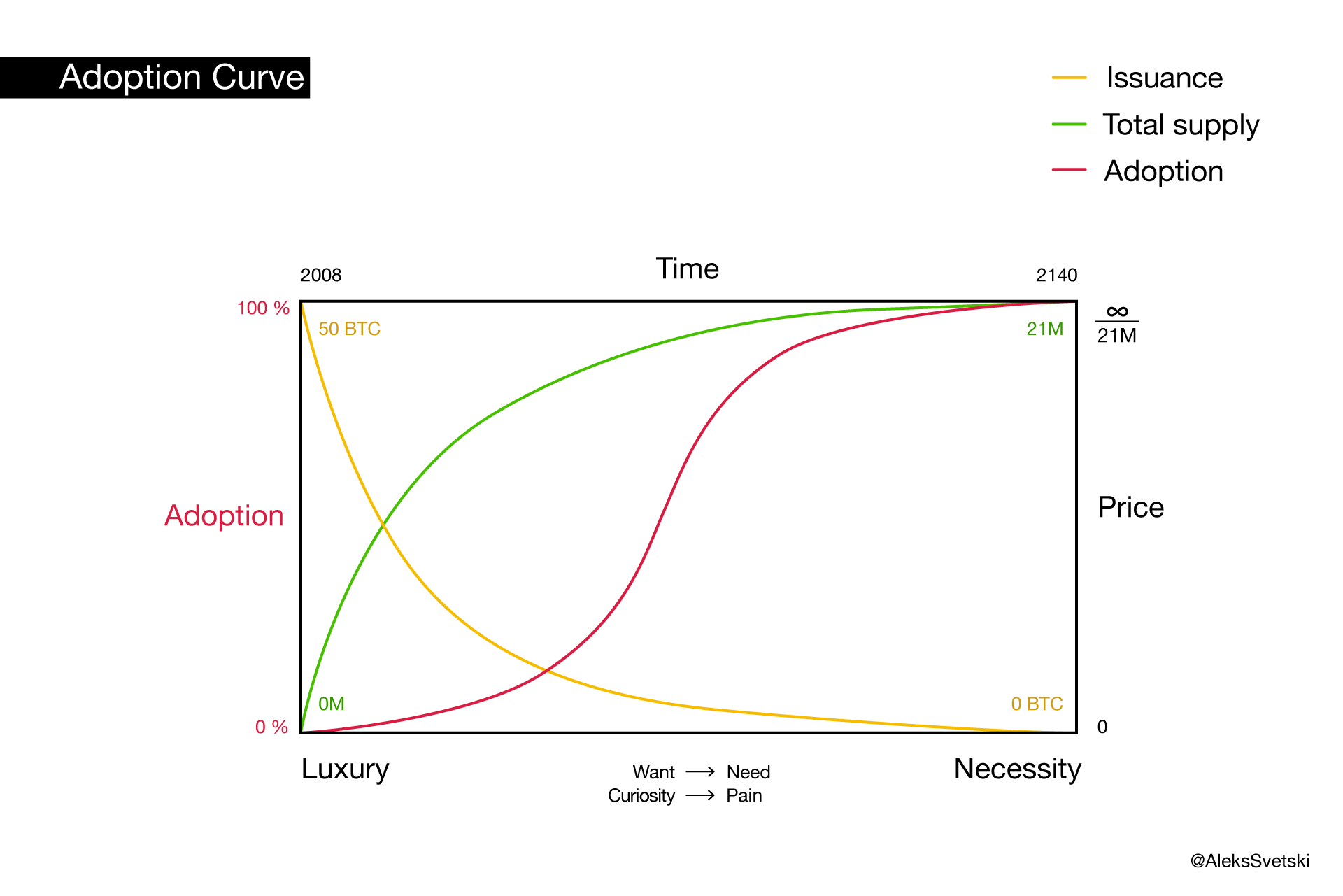
Bitcoin is purified capitalism: an elegant mathematical solution to the past problems of money.
Competition and collaboration are the trades of life. Conservatism of energy is truth—organizations, methods, and tools that accomplish the greatest results with the least effort tend toward dominance as they are willingly embraced by market participants whose “skin is in the game.” Strict adherence to thermodynamic principles is the way all natural systems grow (there is no other way). Monies, moralities, and strategies which best amplify productivity outcompete on the free market for ideas—submission to this truth is freedom. Bitcoin is a system that minimizes competitive asymmetries by maximizing accountability, and thereby incentivizes fair play and error-clearing in the market. Modeled on the unbreakable rules of the universe—thermodynamics—Bitcoin is best known for its meteoric growth pattern:
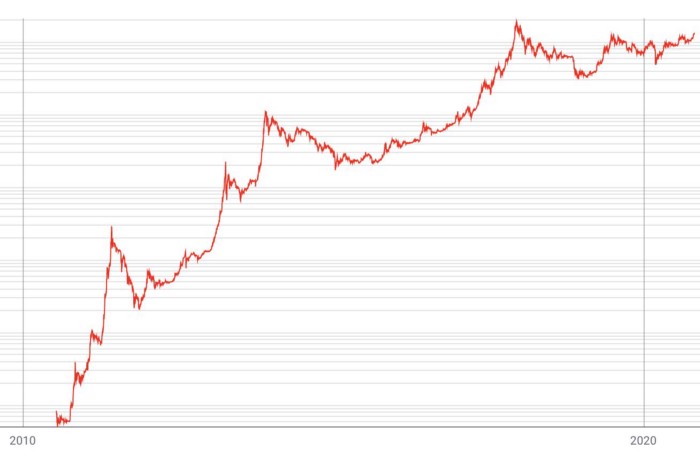
Adherence to thermodynamic principles has made Bitcoin the most explosive money in history.
We are what we build, and we build what we are. Ideation and wealth creation are mere expressions of life’s central impulse: growth. Without adequate levels of exchange, growth of organisms and economies deteriorate. On this point, nature is ruthlessly clear: when you’re finished changing, you’re finished. As we age, we experience a slowing of blood flow, which presages a breakdown of body and mind. Physical exercise can provide some protection by increasing our metabolic exchange of oxygen, water, and nutrients thereby keeping us smarter, healthier, and more energetic as we grow old. As William Durant eloquently describes this decline into senescence:
“It is a physiological and psychological involution. It is a hardening of the arteries and categories, an arresting of thought and blood; a man is as old as his arteries, and as young as his ideas.”
What is true for the individual market participant microcosm is true for the global market macrocosm: impeding free trade constricts ideological “blood flow” and makes the “socioeconomic superorganism” (aka humanity) more vulnerable to disease and death. Close-minded constituents conjure a build up of misfitness to reality for the collective. Creating blockages to trade via regulation and confiscation—the implicit purpose of central banking—is cancerous to the free market paradigm that invigorates our economic vitality, social morality, and the advancement of civilization.
All individuals seek to attain freedom, goods, and power for themselves. Governments are simply a multiplication of ourselves and our desires, without external governance, and armed with weapons of mass destruction. No amount of tears can wash away the blood war sheds, only practicality, properly implemented, can prevail. Absent a battle to fight — whether moral or physical — people become weaker. Arraying armies against an enemy gives people cause for unity. Perhaps Bitcoin will serve as a moral alternative to war — a peaceful yet disciplinary force on humanity. American Pragmatist William James believed a “moral equivalent” of war was necessary to end its horrors:
“So far war has been the only force that can discipline a whole community, and until an equivalent discipline is organized, I believe that war must have its way.”
If this proves true, Bitcoin would become a new organizing mode for civilization: like a religion born from economic and computer science; a wisdom tradition that defunds and destroys central bank war machines and ideologies. Warfare is Darwinism writ geopolitical, and its atrocities will be endless until all nations agree, or are forced, to yield their self-arrogated sovereignty to a higher authority — a “superstate” hodling individual sovereignty as its axiomatic mantra. Bitcoin — a public utility that facilitates trade flows of private property — is the bridge between communistic utopianism and capitalistic pragmatism, and could grow to become the superstate to which all nations bend the knee. Perhaps this ultimate usurpation of the nation began with the Genesis Block on day one, or perhaps it is still yet to transpire one day. For now, we can only say: Bitcoin is money.
Money is the ultimate token of trade, and trade is mankind’s meta-idea. Whatever wins as money on the free market is a brilliantly formulated, civilizing idea. Capitalism is the socioeconomic system which optimizes for the expansion of trade’s scope by respecting free market principles, foremost of which is individual sovereignty. Bitcoin—an honest money offering its holders inviolable private property rights and perfected rule of law—is the capstone innovation of capitalism. It is as if all trade throughout history led us to the emergence of this idea: an unstoppable, incorruptible, and highly accessible money. Like ideas, Bitcoin exhibits non-corporeality, virality, and antifragility—it can be moved at the speed of light and stored in the mind. By virtue of its resistance to theft and rootedness in the thermodynamics of work, Bitcoin portals us into a world of untold liberty, elevated morality, and enhanced productivity. Bitcoin gives us the freedom to: trade without central bank interference, store our wealth in a place resistant to seizure, and to embrace truth in a world drowning in deception.
Considered in combination, these ideas make Bitcoin mankind’s most brilliant idea yet—a salvific foundation on which we can build a future civilization characterized by more ingenuity, morality, and prosperity.
“Salvation: to see each thing for what it is — its nature and its purpose. To do only what is right, say only what is true, without holding back. What else could it be but to live life fully — to pay out goodness like the rings of a chain, without the slightest gap.” — Marcus Aurelius
Thank you for reading Our Most Brilliant Idea.
- Subscribe to my YouTube Channel: bit.ly/321Lzm0
- Follow me on Twitter: https://twitter.com/Breedlove22
- Stack sats with me, get $10 in free Bitcoin through this link: https://www.swanbitcoin.com/breedlove
- Journey with me as I write my first book: https://bit.ly/3aWITZ5
- If you enjoyed this, please send sats: https://tippin.me/@Breedlove22
- Or, send sats via Lightning Network with Strike: https://strike.me/breedlove22
- Or, send sats via PayNymID: +tightking693
- Or, send dirty fiat dollars via PayPal: https://www.paypal.com/paypalme/RBreedlove
- Or, send dirty fiat dollars via Venmo: https://venmo.com/code?user_id=1784359925317632528

Bitcoin accepted here: 3CiBznmvP2jXVSPR9bUWZwSNtbe9ubp36M
Translations:
Thank you for feedback during the writing process: Jimmy Song Brandon Quittem @Greg Z Zach_of_Earth
My sincerest gratitude to these amazing minds:
@real_vijay, Saifedean Ammous, Brandon Quittem, Dan Held, Naval Ravikant, @NickSzabo4, Nic Carter, @MartyBent, Pierre Rochard, Anthony Pompliano, Chris Burniske, @MarkYusko, @CaitlinLong_, Nik Bhatia, Nassim Nicholas Taleb, Stephan Livera, Peter McCormack, Gigi, Hasu, @MustStopMurad, Misir Mahmudov, Mises Institute, John Vallis, @FriarHass, Conner Brown, Ben Prentice, Aleksandar Svetski, Cryptoconomy, Citizen Bitcoin, Keyvan Davani, @RaoulGMI, @DTAPCAP, Parker Lewis, @Rhythmtrader, Russell Okung, @sthenc, Nathaniel Whittemore, @ck_SNARKs, Trevor Noren, Cory Klippsten, Knut Svanholm @relevantpeterschiff, Preston Pysh, @bezantdenier
And anyone else I forgot :)
Sources:
a. https://www.grunge.com/91938/ideas-changed-course-humanity/
b. Rational Optimist by Matt Ridley
c. Meditations by Marcus Aurelius
d. Fallen Leaves: Last Words on Life, Love, War, and God by Will Durant
e. Manifesto to the Communist Party by Karl Marx
f. https://oll.libertyfund.org/pages/did-bastiat-say-when-goods-don-t-cross-borders-soldiers-will
Thanks to Brandon Quittem, Jimmy Song, and Zach_of_Earth.
The Costs that Haunt Your Dreams of Hyperbitcoinization
By Emil Sandstedt
Posted September 3, 2020
Capitalism, Division of Labor and Money
Capitalism incentivizes profit seeking, meaning profit margins are eyed vigilantly. Any sector or niche is vulnerable to attracting entrepreneurs that set to work on making themselves richer, unintentionally shrinking said margins in the process. This profit seeking is conducted by utilizing money, as money leaves the entrepreneur through costs and reaches the entrepreneur through revenues. The entrepreneur, as a way to maximize profits, has chosen to specialize and is thus part of the massive, decentralized collaboration we call Division of Labor. As a participant, he must make use of money — the fragile glue that binds the whole construction together. Therefore, with ever increasing profit seeking and specialization in the world, and therefore ever increasing trade between participants, the transaction costs of money see a continuous increase in economic importance. It follows that transaction costs is an important factor in determining the money of a highly specialized future.
In Mises’s Evenly Rotating Economy abstraction, every day is the same; yesterday is no different from today, and today is no different from tomorrow. In such an economy, all the factors of production are employed in such a way that they provide the highest valued service possible. There are no more entrepreneurs as all profit margins have already been fully exploited. Since every day is the same, there is also no more uncertainty, and so instead of holding money that for instance would put the holder first in line to react to future economic surprises, individuals have simply exchanged their money for debt or equity. The lending- and investment periods in the thought experiment are of course fully flexible, meaning any period could be stipulated in contracts. Since everyone knows the future, they have lent out or invested their money, and the value of money has fallen to zero. Phrased perhaps more coherently, due to no more surprises ever occurring in the economy, producers have set up perpetual barter contracts defined in the final prices of goods and services, and no actual money is used. In this way, the same trade outcomes are iterated day after day without incurring unnecessary transaction costs through the use of an intermediary good. The main takeaway from all this is that, only if the future is uncertain will individuals demand to hold money. Money is for uncertainty.
Money then, to summarize, must facilitate profit seeking or entrepreneurs will use a money better suited for the purpose. It must also facilitate a possibility to respond to unexpected changes such as stock market crashes or unexpected new production (both for which sellers ask for money in return);money is for the proverbial rainy day — an idiom from a time when the weather could not be well predicted. From these prerequisites — two sides of the same coin — it follows that money can only stay money and stay valuable as money if transaction costs are low. If such costs get too high, trade and division of labor are simultaneously eroded until a better money is adopted. The higher the transaction costs, the closer the world economy resembles one-man Robinson Crusoe economies, where holding money obviously is as worthless as in the Evenly Rotating Economy; in this hypothetical case there is certainty not about the future, but that there is no-one to profitably trade with.
Costs of Bitcoin
A severely limited block space, though prudently defending against fraud, monetary over issuance and fatal tinkering by leaving users in control of both economic rules and validation, also means on-chain fees rise astronomically should hyperbitcoinization proceed. Bitcoin is monetarily rather unique in this regard, that it becomes more expensive to use the more people that are using it — a point previously made by Deryk Makgill among others, and I have to say, an obvious hurdle standing between genesis and hyperbitcoinization. When gold was money, certain gold transactions were crowded out in not the same but a similar fashion, as the physical amount of gold for small-value transactions became too impracticable and costly for the buyer and seller to handle — hence the use of silver and copper as money. But in any case, no Bitcoin profit seeking can be expected to take place on-chain, but rather on higher, more complicated layers on top of Bitcoin, such as through Lightning channels and various centralized database solutions offered by third-parties. Only if total costs through such scaling attempts decrease enough to make Bitcoin the generally cheapest medium of exchange can it attempt to monetize fully and become money. By viewing potential Bitcoin hyperbitcoinization through the lens of its ability to be used in universal profit seeking or in reaction to general economic uncertainty, we are simply reiterating a more pragmatic version of the now rather well understood Mengerean theory of money and saleableness. In this theory of money, the winner-takes-it-all effect leaves little room for insufficiencies. This is why Bitcoin transaction costs become incredibly important when speculating about hyperbitcoinization. Somewhere around here, in this mess we call money and economics, is where some people get confused.
Managing Lightning channels are, and likely will be, both tricky and expensive in the foreseeable future. Inescapable costs are for example channel settlement, larger attack surfaces with regards to theft, and larger incident surfaces with regards to simply losing control of Bitcoins due to software bugs or interface deficiencies. Although less tricky and less expensive in some regards, using centralized Bitcoin schemes supplied by trusted third-parties of course introduces other costs. While escaping direct on-chain transaction costs, including costs of settling channels, as well as costs related to bugs in the scaling software, new costs related to custody make themselves felt; legal looting by governments, conventional theft by the custodians themselves, and fraud. So, in an attempt to make up for the sub-optimal prospects of a subset of Bitcoin’s congestion related costs, it is tempting to point to the solution of hodling. To be clear, holding on to a good is of course prudent if expecting monetization to continue. Only a fool would want to get rid of a good he expects to increase in value, as he can just spend bad, inflationary fiat money instead. No, the confusion is not about the rational (non)act of holding on to a medium of exchange currently surfing a Mengerean monetization feedback loop, but about why a specific medium of exchange would qualify for such a loop in the first place; by hodling Bitcoins, and because producing new Bitcoins is a task that seldom becomes any easier, enough costs are thought to be escaped to have total costs stand in competition with established monies. In other words, through hodling, it is said, the saleableness of Bitcoin is high enough to have it start dethrone less saleable monies and impose itself on a shocked world economy through blitzkrieging hyperbitcoinization. There is just one problem: the superior saleableness (which by the way decreases with hodling) may be artificial and therefore shatter in real economic situations.
At a glance, the logic behind lowering costs through hodling seems to check out. By not spending Bitcoins, saleableness-eating transaction costs of course do not accumulate. Saleableness-eating supply dilution costs have already been conquered with the supply cap and the difficulty adjustment algorithm. But anyone decreasing costs by hodling his Bitcoins over a longer period of time is put in the awkward situation where his Bitcoins are now in competition with conventional debt and equity rather than with conventional monies. The reason a person can’t escape monetary costs by making his money artificially illiquid is because the opportunity cost of not lending and not investing then would make itself felt. Another opportunity cost — the inability to act during future economic uncertainty — will take its toll as well for those finding themselves hodling Bitcoins for the sole purpose of lowering costs. To be first in line to spend during a sudden crisis is only an opportunity if the money is not already artificially promised not to be spent. In other words, there are costs for prohibiting your money from being used as money. It is binding yourself to the mast of a ship when you may have to steer it later to escape the storms.
In short, certain costs that people are trying to escape, are very, very hard to run away from because they haunt the attempted money in various forms. There is no running away from what money is meant to be. This means that hodl, by the very nature of how money is successfully used, can’t help make Bitcoin money in and of itself. Only functional scaling can, and that road is full of uncertainty and danger. Hyperbitcoinization then stands or falls with, among other things, the attempted technical solutions’ ability to drastically lower total costs, and not with any collective hodl incantations. The cost situation is serious enough as to having prompted some intelligent Bitcoiners to capitulate with regards to off-chain scaling. They now embrace low on-chain transaction fees and, in my opinion, therefore may stumble into other scary and hidden costs related to the inability of choosing economic rules and validating transactions. For some of these people, it seems to simply be a disagreement about the promises of off-chain scaling as they are seen wandering the foggy transaction- and validation cost trade-off frontier in war-afflicted Bitcoin land.
On a slightly different, albeit more ridiculous note, some Bitcoiners have pursued hodling as part of their sacrifice to the collective. Such self-inflicted economic flagellation is not the same cost as the ones described above, but it goes without saying that if the Bitcoin you own is so bad that it demands sacrifices from you, it is not going to survive very long.
Money or not — how much does it matter?
Whether Bitcoin can become money or not is a question time will answer; the factors involved are complicated enough to throw certainty aside. Still, it is worth thinking about what Bitcoin is if it fails in becoming money. Although what individuals choose to use as money arguably is a manner of subjectivity, Austrian monetary theory has, as earlier indicated, a more objective view of this and states that only the most liquid good is money. In other words, according to this viewpoint, Bitcoin is not money unless it is globally used as a highly liquid medium of exchange. The exclusivity born out of this definition takes us to an interesting focal point. A focal point is something that facilitates an above average probability that the same decision may be made by various parties, absent communication. Absent communication, but knowing the exact day they are supposed to attack, most Byzantine generals likely unsheathe their swords at noon.
Being money then, in a digital world where code bases can be copied and blockchains forked without costs, is thus a focal point worth thinking about. Unlike gold, as an example, Bitcoin can be copied and forked to oblivion over the coming decades, but the position as being money cannot, under Austrian definition. It is because of this that Bitcoiners such as Daniel Krawisz argue that becoming money is the moat Bitcoin needs if it wants to succeed in the long run. A Bitcoin which fails to become money (for example by not facilitating profit seeking), according to Krawisz, would find itself worthless in the end precisely because the neccesary focal point is lacking. I am much more optimistic.
Gold is not used as money today, yet is worth an incredible amount. The reason some refuse to extrapolate that fact and apply it to a Bitcoin not used as money is what has already been touched upon, that Bitcoin is digital whereas gold is not, and so in the long run lacks the focal point needed for it to be distinguishable from digital copies. But there are other focal points involved. Admittedly, becoming global money would be an excellent additional focal point for Bitcoin, given the adversarial nature of no-cost copying. But it might be the case that Bitcoin can’t be money, and so there won’t be any such hyperbitcoinization. This scenario is, it seems to me, not unlikely. Instead, being, and having been for over a decade, the first, most valuable and most liquid cryptocurrency, is a sound focal point as well, with a similar exclusivity extracted out of its definition. It is likely that, given that decentralization, a non-changing code base, and other prerequisites don’t break down in the future, this focal point is enough to build the moat against future digital contenders, despite lacking the focal point discussed earlier. To summarize, a Bitcoin failing to become money is likely to still have a good chance of becoming and staying highly valuable for the same reasons gold stayed valuable after demonetization.
Gold, although not used as money anymore, is still a hedge against coercion and violence of various sorts; escaping inflation may be attempted with equity and other assets, but escaping violence in a similar fashion can be hard as many of the assets are immovable and thus confiscatable or destructible. Owning factories or conventional real estate will do you no good if the Enemy’s war apparatus set to work, or if your fellow countrymen suddenly deem you of an inferior race, or of a heretical religion, or of an exploitative class. When fleeing a country, or fleeing certain government edicts within a country, the shape and form of owned assets decide the success of how much wealth survives. Gold has facilitated good enough resistance against such forms of violence, why it has kept its high valuation beyond the fate sadly bestowed upon it in the previous century. For similar reasons can a non-monetary Bitcoin attain a very high valuation if it facilitates even better resistance against coercion and violence, which, arguably, it does. The confiscation resistance is one of its biggest strengths and it is easy to imagine future scenarios where families escape wealth destruction by simply holding Bitcoins private keys. If Bitcoin fails as money, in other words, it still would likely facilitate more prosperity and more justice through keeping intact property rights when nothing else could.
Special thanks to Daniel Krawisz and Deryk Makgill from whom I silently borrowed ideas about how money works.
Lies, Deception And Unnatural Money
By Nik Hoffman
Posted October 13, 2020 on Bitcoin Magazine
“It is well enough that people of the nation do not understand our banking and monetary system, for if they did, I believe there would be a revolution before tomorrow morning”
– Henry Ford
The continued functioning of the financial system you have lived under for your entire life is dependent on the average person not understanding exactly how it works, and there are many reasons for this. As you read deeper and deeper into this article, I hope that you will realize how deceiving our money really is. Governments and banks lie to you and take advantage of you every single day, most people just don’t realize it. The money you use to save your value or purchase goods and services is unnatural; it is the equivalent of manmade garbage that you’d throw away in a second if you understood it better and had a viable alternative to opt into instead.
I was always told growing up that the financial system was broken and that it doesn’t work properly, but that there were no good solutions to its problems. While most agree that the system is unfair, I wanted to find out what about it is broken exactly, and I did. But I also found that because the entire financial system is broken for the vast majority of people, that means it’s working just as intended.
What Makes Money Valuable?
Money is a fundamental aspect of our daily lives that touches almost everything that we do, but the vast majority of people aren’t taught everything they should know about the history of money and how it works.
So, what are people generally taught about money? At most, they are usually taught some basic Keynesian economic principles, which emphasize governments and central banks while deemphasizing the sovereignty of their constituents. Keynesian economics are macroeconomic philosophies that developed in the wake of the Great Depression, but have resulted in an unfair system that most people don’t understand, even if they live under it. But here is some truth about what really makes money valuable.
Good money typically has six main characteristics: durability, portability, divisibility, uniformity, scarcity (limited supply) and acceptability. Each one of these characteristics plays a key role in the value that a certain form of money can provide, with all different forms of traditional money having tradeoffs.
All effective monetary media throughout history have possessed some combination of these qualities, but not all. Historical forms of money include gold, silver, stones, seashells, glass beads and more. These tools were used as money because they fulfilled a certain role in a given society typically in either storing value or facilitating exchange.
Money is a universal tool used by everyone to exchange value for goods and/or services; it’s an asset that requires certain characteristics to be functional in exchange. If someone is using money without most of these characteristics, then it is bad money.
The U.S. dollar, for instance, is not durable, it has an unlimited supply, it’s not very divisible and doesn’t have solid uniformity. You can use just about anything people deem as having any value as money, but there are long-term, harsh consequences to using bad money. Such as wealth evaporation.
Good money comes and goes and has always served a particular role in its given society. But over time, historically good money has often become bad money, as a society shifted to a better form of money. Money has evolved over time, adapting to its surroundings and technology. With enough time having passed, we’ve seen good money turn to bad money and ultimately fail, time and time again.
So, you may be asking yourself: “If these characteristics are what make good money, then how can good money turn to bad money and fail?”
Money Printing Is Inevitable
“The root problem with conventional currency is all the trust that’s required to make it work. The central banks must be trusted not to debase the currency, but the history of fiat currencies is full of breaches of that trust.”
History has proven that if humans are able to print money, they will. Everyone wants a shortcut and nobody can be trusted with this power, as history has demonstrated.
It’s been estimated that during the time of the Civil War, about one-third of all of the money in circulation was counterfeit. And today, counterfeiting is still rampant. Zero Hedge reported earlier this year that a Chinese gold processor was behind a scandal involving 83 tons of fake gold bars, which would account for 4.2 percent of the country’s total gold reserves in 2019.
There have been many different examples of money printing throughout time, resulting from cycles of human greed that lead to lies, deception and unnatural money. Whether it be counterfeiting banknotes, gold bars or even glass beads, people will always try to get an unfair edge over others.
If you were to print money for little to no cost, quickly or over long periods of time, you end up devaluing everyone else’s hard-earned money. But since it costs you little to nothing to produce, you’re not losing any wealth, you’re just stealing it from everyone else. This same reasoning applies to “legitimate” money printing — not just counterfeiting, but governmental money production — and then becomes a function that is dependent on the people not realizing that their wealth is deteriorating.
Inflation stems from money printing, the same process that is known as “counterfeiting.” It’s unnatural, man-made intervention that screws up everything in an otherwise natural, free market.
Money Printing Is Unnatural
Now that we know what makes good money and that money printing is inevitable and inflationary, let’s take a look at the root cause of the failure of all previous forms of good money. If we look at the characteristics that make good money, there is one that stands out among the rest. I’m talking, of course, about scarcity, or the enforcement of a limited supply, which is critical in making good money and simultaneously something that is constantly being undermined by greedy people who find a way to exploit the system.
“Deception is an act or statement which misleads, hides the truth, or promotes a belief, concept, or idea that is not true,” according to Wikipedia. “It is often done for personal gain or advantage.”
As noted above, money printing only “works” if the majority of people don’t even realize that it is steadily devaluing their earnings and savings. People must be deceived into believing a false ideology about this practice, but that can only work for so long; as we’ve seen throughout history, bad money doesn’t last forever. The people who were deceived also pay for the consequences that bad money causes.
One of the most impactful stories of how money printing ruined a society involves the Rai Stones on the Island of Yap. These giant limestones were used as money there and stored families’ value for generations. These stones were very difficult to produce so, the bigger the stone, the more value it had, with some stones larger than a fully-grown human.
As Saifedean Ammous described in “The Bitcoin Standard,” the Island of Yap thrived until Irishman David O’Keefe immigrated there and saw the immense opportunity to mass produce these stones using iron tools. The key here was that O’Keefe was able to make these stones at a quicker rate and to make them smaller, making them more transportable. Over time, the Rai Stone market was so flooded that the stones became worthless, and the value held by the islanders was wiped out.
Effects Of Government Money Printing
One of the most recent examples of the devastating effects of money printing happened in 2019 when the Venezualan bolívar experienced hyperinflation of some 2,000,000 percent, destroying the wealth of the country. Venezuela was once South America’s richest country, until it started going down a slippery slope via corrupt leaders with deceiving, flawed and socialist ideologies. The country’s death knell was put into motion when President Nicolás Maduro was voted into office.
Maduro appealed to many voters because of his socialist policies, knowingly deceiving his target audience. Once Maduro was elected, the money printing press ran hot while deficit spending rose astronomically. The wealth of the country vanished as the once-richest country in Latin America became the poorest. The public was taken advantage of for Maduro’s ideological gain, and was ultimately punished, with many no longer being able to afford to eat.
The destruction of Venezuela’s national currency transformed the country into a totally failed state. Since the government has full control over the bolívar, they are able to force people to get paid at the official exchange rate, which is significantly less than it is on the unmanipulated black market, stopping the citizens from having any hope of saving their wealth or getting ahead, while benefiting the government by keeping hold over its citizens.
This horrible aftermath of money printing is not unique to this specific case. As you study the after effects of other hyperinflated currencies, it becomes apparent that the results are always the same.
You’re Being Blatantly Lied To
“The CPI is deliberately designed to understate and mask the inflation that the Federal Reserve is creating”
Inflation silently steals our wealth from right under us and yet, governments and central banks can’t even be truthful to us about that. But how do we calculate and know what the inflation rate is? We find out through something called the Consumer Price Index (CPI). According to the U.S. Bureau of Labor Statistics, CPI is a measure of the average change over time in the price paid by urban consumers for a market basket of consumer goods and services (food, housing, clothes, transport, medical care, recreation and education).
This bureau implies that CPI is calculated simply, but it’s actually extremely complicated. On the bureau’s website, you can download a PDF file with its methods of calculation. The only problem is that it’s a whopping 107 pages long! And to think it calculates just one simple and fundamental problem: the degree to which the money that you have today will be devalued by tomorrow. The main goal for the Bureau of Labor Statistics seems not to be solving this problem, but to be jumping through loopholes and twisting and turning things until it gets a low enough number to report to the public.
Even as real inflation goes up due to money printing, the government may say that there was 0 percent inflation for that year, because the government calculates inflation via CPI, which allows it to jump through loopholes to get a certain number most appealing to the public. A huge consequence of actual inflation means that your dollar is purchasing less and less every year while you end up getting taxed more because of CPI. Then, the government bumps you up into a new tax bracket in which you are now taxed at a higher percentage of your income and end up taking home less value than before.
It lies about the inflation rate for political gain and it saves the government money while stealing from the citizens.
Bitcoin Fixes This
Humanity cannot advance forward unless we solve the problem of money printing, and Bitcoin actually fixes this.
Bitcoin has all of the qualities of money as mentioned in “What Makes Money Valuable?” above, unlike all previous forms of money before, which have either lacked these qualities or failed to retain them.
Durability isn’t a problem for bitcoin, as it’s completely digital money that can’t be destroyed or withered like paper money or gold. Bitcoin is extremely portable and can be stored or transferred anywhere in the world with ease, as it is not bound to border restrictions — you can send money to anyone in the world no matter where you are, with it arriving safely and quickly.
Bitcoin is the most divisible form of money humanity has ever experienced. Whereas the U.S. dollar is divisible into 100 pennies at most, 1 bitcoin is divisible into 100 million units called satoshis (or “sats” for short). Bitcoin has strong uniformity as each unit is essentially the same as all others.
BTC is accepted by more and more people all over the world every day. We’ve seen a large increase in people, small businesses and large institutions that have come to accept bitcoin as money since it was introduced.
Lastly, the bitcoin supply is capped at 21 million, as mentioned above, and, as a result, it has a finitely limited supply. Historically, money printing was inevitable, but not anymore. Everyone abides by the rules of the network enforced by the nodes and miners, which keep everyone else honest and prevent anyone from ever increasing the supply cap, ever.
You can look at historical forms of good money as having a set of “rules” that the system is based on, until someone comes in and “cheats” the system for selfish gain. That money created by the cheater is unnatural and ruins the “game.” Bitcoin fixes this, because everyone and anyone is capable of running a full node to maintain their own exact copy of the Bitcoin ledger, which keeps everyone honest and prevents bad actors — especially when the nodes and miners are financially incentivized to do so!
Bitcoin is superior money compared to hyper-inflatable currency. It doesn’t bear the same problems that have come with forms of money in the past, and it prevents the issues mentioned above from happening again. History has shown that humanity has thrived when society had hard money, and the impacts of a currency that can never be hyperinflated look very promising. It has the potential to usher in a new Renaissance or Industrial Revolution.
And, last but not least, the Bitcoin network will never lie to you. It is open-source, meaning you can look at the code yourself, for free, right down to every last detail. BTC has an open ledger that lets you become your own bank, and the master of your money. With Bitcoin, you take back the power from the corrupted people you were blindly trusting.
Tweet Thread - The Four Valuation Frameworks for Bitcoin
By Vijay Boyapati
Posted November 9, 2020
There are four main valuation frameworks for Bitcoin and I wanted to summarize them with a target valuation that one would assign if one subscribed to that framework.
Thread 👇
1) Bitcoin’s rise is equivalent to the Tulip Mania. It has no real comparative advantage to any existing monetary good or to the current fiat monetary system and is a bubble that will eventually pop.
Long term target price: $0.
2) Bitcoin is a new monetary technology whose appeal is largely limited to technologically savvy and libertarian minded people who can tolerate its volatility, which will be a permanent feature of its existence going forward.
Long term target price: $10,000 - $100,000
3) Bitcoin is a new monetary good that will primarily disrupt its closest monetary cousin, gold. It is significantly superior to gold along all the attributes that make gold a good store of value.
Long term target: $300,000 - $1,000,000
4) Bitcoin will ultimately become the world’s reserve currency. It is superior as a collateral asset to anything ever created and will eventually drain store of value premiums out of government bonds, real-estate, precious metals and rare art.
Long term target: $10,000,000+
After existing for a decade the first valuation framework, which was dominant in the early years, is now only subscribed to by ideologues and luddites (e.g., @PeterSchiff, @paulkrugman and @nouriel). No intelligent thinker who understands Bitcoin subscribes to this framework.
The primary valuation frameworks that investors subscribe to today are 2) and 3) with the market slowly transitioning from 2) to 3). Once framework 3 is widely accepted by the market, it will lay a foundation for framework 4 to be viewed as possible and even inevitable.
Exploring Bitcoin’s core values and why we defend them
By Hasu
Posted November 10, 2020 on Deribit Insights

In his essay “Bitcoin’s Existential Crisis”, Nic Carter describes the identity problem that is inherent to Bitcoin. Because no one has the authority to give decentralized systems an identity, they rely on intersubjective consensus around a set of practical core values.
You can think of these core values as the lowest common denominator between all people in Bitcoin, and I tried to formalize them in Unpacking Bitcoin’s Social Contract – with the caveat that any such attempt is necessarily both highly subjective and chasing a moving target.
When people disagree about what Bitcoin is or should be, that can impact the real world in two different ways. For one, there is an unspoken rule that the protocol won’t be updated unless virtually all important stakeholders are satisfied with the proposal. When people disagree over basic principles, no major proposal can ever get the buy-in of all necessary parties. We call this “protocol ossification” and most people seem fine with it today because (1) Bitcoin doesn’t really need to change much from here, and (2) that resistance to change is seen as a valuable property that sets it apart from centralized systems of the past.
But there’s also the risk that some external event occurs that requires Bitcoin to change, whether in response to an attack or bug or more generally due to a lack of success in the market. In that case, the same governance gridlock can quickly become an existential issue as the community fractures into opposing sides.
Mutually exclusive narratives can coexist with each other for some time, but eventually they reach their boiling point. That was the case in Bitcoin with the collision of “Bitcoin is for cheap payments” vs. “store of value” and in Ethereum with “code is law” vs “social consensus is law”. Both sides had just as much a credible claim to being right, because there is no central party to „tie-break“ their disagreement. The only way these conflicts resolve is via messy social consensus formation, market signals, and in some cases, permanent community splits.
The biggest questions today are probably how to address possible incentive problems due to the declining block subsidy, and how private Bitcoin should be in the wake of increasing blockchain surveillance. Nic and I tried to account for these and other possible narrative collisions back in our article Visions of Bitcoin.
As Nic puts it, „systems with more internal consistency and more universally agreed upon value sets are better equipped to last.“ That suggest the optimal social contract
(1) has a very small number of rules (to include as many people as possible)
(2) that users are highly committed to if something ever goes wrong with the software.
In today’s article, I want to build on this existing body of work by exploring where real bitcoiners actually draw the line in terms of their core values, where their logic might reveal potential narrative collisions, and what all this means for Bitcoin’s future.
Introducing the questionnaire
In order to explore this topic, I employed a basic questionnaire to ask my Twitter followers what they see the core values of Bitcoin. The way I framed the questions was to ask for the negative – what changes or events would make Bitcoin no longer Bitcoin to them? The implication here is that users would be bothered enough to sell their coins and leave the project.
All questions can be grouped into these five high level topics:
- Censorship-resistance;
- Intermediation;
- Monetary inflation;
- Settlement guarantees; and
- Means vs. ends (more on that later.)
Censorship-resistance

The first topic I asked about was censorship resistance, which has always been one of the core tenants of the Bitcoin social contract. And indeed the results came in like expected: People really value censorship resistance, both for themselves and others, to the degree where it can seem irrational to bystanders. After all, people don‘t stop using Paypal because it has deplatformed legal arms dealers or political dissidents, or leave Twitter after it has censored many a conservative media organization or politician.
This only goes to show that Bitcoin actually *has* a social contract, and people feel disproportionately more violated if censorship happens in Bitcoin than in other systems where they might have come to expect it, even when they are not personally affected.
Indeed, Bitcoin’s design makes censorship very unattractive because if one miner doesn’t include your transaction, the next miner might, and as a result they will make more money in the long run. This holds true unless one miner (or coalition) controls over half of the hashpower and can safely ignore any non-compliant blocks from other miners. It also works with less than half of hashpower if the attacker can credibly scare other miners out of including transactions or addresses that are on a public blacklist (see “feather forking”).
The fact that users aggressively signal that they won’t accept others being censored actually matters to that, if the counter-threat can make it unprofitable for miners to follow the feather-forker. It is also a counter-argument to the popular thesis that only transaction fees and not the block subsidy protect Bitcoin from censorship, as the attacker stands to lose business from uncensored parties as well.
Intermediation
If people are censored from using Bitcoin, this could only really happen in two ways: 1) on the consensus layer by miners, or 2) on the application layer by trusted intermediaries.
Bitcoin is often said to eliminate said trusted third parties, but that applies only when users interact with Bitcoin directly. If most activity happens through trusted third parties, we could see the same encapsulation of a trustless base asset in a trusted wrapper by that eventually led to the failure of the gold standard. For a thought experiment of why intermediation is a big risk to bitcoin, see Why Bitcoin might not survive a Bitcoin Standard.

Given the aptness of bitcoiners for pointing out gold‘s weaknesses, I expected tolerance for a fully intermediated Bitcoin to be very low. But alas, I was surprised by how many people would be a-okay with it. Maybe they are simply pragmatic because Bitcoin indeed can only support so many base layer and LN transactions before fees would price out most smaller users and transactions, and most people might not think of themselves as “rich enough”.
That said, there are good reasons why the worries about an intermediated Bitcoin could be overblown and Bitcoin could fare better than gold has, due to its unique advantages. Because Bitcoin is a digital bearer asset, anyone from anywhere in the world can create a new Bitcoin bank that doesn‘t necessarily have to comply with local regulations. And why intermediaries would still be trusted, there would be more competition between them, putting the customers in a better position than if regulation protected incumbents from disruption. Because Bitcoin can be transferred so easily, this would also make it easier for customers to switch between different intermediaries, further lowering the exit cost.
In spite of being generally skeptical of other non-Bitcoin blockchains, it also seems that Bitcoin users appreciate the benefits a blockchain provides in terms of transparency and validity over the black box that is traditional banking.

I think that this trend is likely to continue, as we‘ll see different trust models, from fully trustless (TBTC) to secured by majority of hashpower (Drivechain) to secured by a consortium (Liquid) to secured by single custodian (BitGo) for users to choose from.
Monetary inflation
The easiest way to trigger my fellow Bitcoin friends on twitter is to entertain – even with many caveats – the idea of adding some kind of monetary inflation. Hence I thought that this dislike of inflation would be reflected in the responses, but came out quite surprised.
I went ahead and first asked about “accidental inflation”…

…followed by the kind of deliberate inflation that is often proposed as a solution to paying miners if L1 fee revenue turns out to be insufficient.

It seems that many people are willing to accept inflation if it is accidental – even if it is substantial (+1m total supply!) – but are far less tolerant for deliberate inflation.
This requires some discussion, as it could seem irrational at first. At 0.1% monetary inflation, it takes 48 years to create the same 1m BTC and yet more people would rather reject a version of Bitcoin with a tiny bit of tail inflation than one that has the same 1m BTC immediately. Even though the tail inflation makes Bitcoin more secure, while the accidental inflation would not!
We know there are many people in Bitcoin who value scarcity and Bitcoin’s 21m cap a lot, but it seems they are also pragmatic about it. If a bug has inflated the supply, then the damage is already done, and – assuming the bug is fixed – that does not necessarily make another inflation bug any more likely. Whereas if we deliberately agreed to inflation, it might feel more like a betrayal to the core values rather than a mistake at implementing them.
One thing that often annoys me is people’s fixation on monetary inflation over price inflation. The first is the increase of Bitcoin’s supply, the second is a decline of bitcoin’s purchasing power. The reason it seems so short-sighted is because supply inflation ignores half the market – the demand side for Bitcoin!
To give a very simple thought experiment, if supply inflation was the only thing to optimize, we could change the protocol to stop issuing more coins starting tomorrow. But the purpose of Satoshi’s distribution schedule was not simply to limit supply inflation but 1) to give more people the chance to buy or mine Bitcoin, and 2) to pay for miner security until the blockspace market has come of age.
A bitcoin without the block subsidy would not be secure today and its price would likely falter as a result of this insecurity. This alone proves that supply inflation can be positive for the price and hence the purchasing power of holders. It simply depends how much the market values sustainability and long-term predictability.
As a counterargument to my own thesis, I would like to once again offer Nic’s thesis that a social contract should be as simple and consistent as possible. “We should optimize Bitcoin’s price” is how most people actually behave, but it’s much more abstract and subjective than “We should keep Bitcoin free of supply inflation”. So maybe in practice, the best thing is to converge on the less accurate and useful more objective and verifiable choice of limiting supply inflation, not price inflation.
Settlement guarantees
Moving on to Bitcoin’s settlement guarantees, I was quite interested in the responses we would get. Both because I’ve locked horns significantly with the Bitcoin community over this topic but also also because unlike inflation or censorship, the settlement guarantees are something that is experienced very directly by everyone who transacts with Bitcoin.

More than half of respondents find a Bitcoin that takes days to settle no longer useful. I do see that as a blow to the popular argument that miner rewards can never be too low in the future as users will simply wait many blocks for settlement (advanced by Nick Szabo and others). This argument ignores that Bitcoin competes with other solutions in a competitive market place for money, and while it can afford to have worse efficiency in return for better scarcity and censorship resistance, there is a limit to how much worse it can be.
That said, more people than in any other question chose “show result”, indicating a high degree of uncertainty.
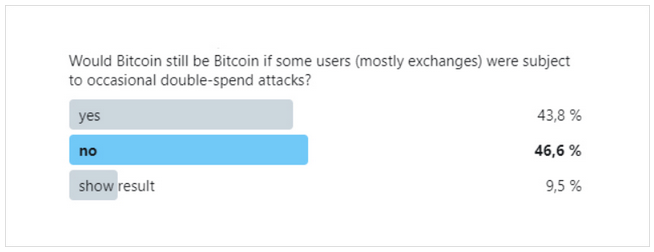
Around half of respondents draw the line at double-spends, which makes sense in a system that values property rights above else. But if we think about this, double-spending is basically like bouncing a check or reversing a credit card transaction. Does the fact that some people bounce their credit card transactions make it useless as a system, especially considering that users themselves would basically never be victims of this, only exchanges and large merchants?
Maybe the same logic applies here that we discussed in the context of censorship resistance, where – unlike a credit card – Bitcoin transactions are intended to be “eventually final”, and hence any violation feels more like an attack on the system as a whole.
That said, the other half of respondents would keep using Bitcoin even when there are occasional double-spends, and I think that is a much healthier attitude. if Bitcoin users wanted absolute safety from this attack, then it would mean that
- they would have to spend more on security than a Bitcoin where occasional double-spends are accepted. Depending on the development of the blockspace market, this view could eventually collide with the “no inflation” view, in which case one of them would have to lose and there might be a community split. If we want to prevent that, loosening your standards in favor of a “lesser evil” can sometimes go a long way.
- Users would have to be prepared to reject more reorgs with social coordination. Doing that in an efficient way requires procedures and hierarchies (think: leaders) to be put in place that make the system less socially scalable.
In summary, I think that users‘ preference for fast and reliable settlement and their preference for no monetary inflation are the most likely (but still not likely in absolute terms) to collide.
Means vs. ends
To conclude the questionnaire, I wanted to ask about a few deliberately random aspects of Bitcoin that are *not* tied to its core values. The goal here was to see if people can identify the difference between the ends – our goals for Bitcoin as a system – and the mechanisms (means) that implement them.
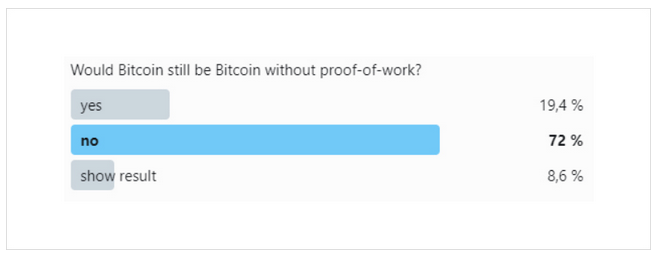
As maybe the biggest surprise of the entire questionnaire, almost more people draw the line at “Bitcoin has proof-of-work” than “Bitcoin has a fixed supply”. As I’ve argued many times before, I see Bitcoin as a set of goals and shared rules, a social contract, and that we build software to automate this social contract. In 2008, Satoshi identified proof-of-work as a key part of solving this puzzle. But it doesn’t mean that PoW is itself one of these goals or core values of Bitcoin.
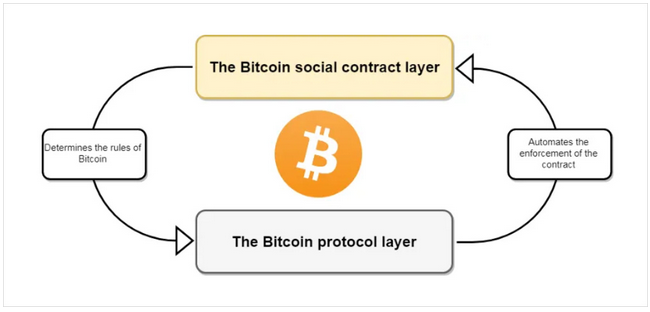
Source: Unpacking Bitcoin’s Social Contract
Instead, proof-of-work is a mechanism to implement two specific goals:
- The trustless distributed time-stamping of transaction – a decentralized clock
- Distributing coins initially in a fair and trustless manner
If any other mechanism ever succeeds at implementing these goals better, and is as battle-hardened as PoW, or if a major vulnerability is detected in PoW, then I would not be opposed to replacing it. But maybe it’s not surprising that the community takes a much stronger stand on the mechanism of PoW than any other, as – with more and more proof-of-stake networks coming online – people “want to give no ground to the enemy here”.
To clarify, I do not think that Bitcoin has anything to fear from PoS coins on a purely fundamental basis, but the arguments given in the favor of PoS (more green, no risk from China, attackers can be identified and slashed) have powerful narrative-value, and I think most bitcoiners are at least subconsciously concerned about that.
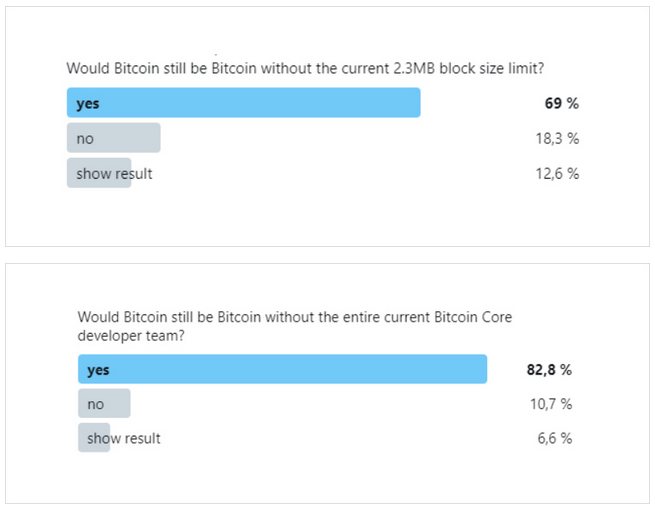
As for the other two questions, the answers are much more in line with what I expected, with people identifying that the current block size limit or the current core development team are not “means” in itself but “ends” to the “means” of implementing Bitcoin’s core values into a technical protocol.
For example, the block size limit is needed to ensure that Bitcoin remains affordable to use for full nodes, who have to validate the entire history of the blockchain and then stay in sync with all incoming blocks as well. It is also important to ensure the scarcity of block space as the block subsidy expires, so transactional demand from users leads to sufficient fee revenue for miners.
Bitcoin’s veto-based governance
Something I really want to point out is how every question had many people “draw the line” and say “this is not Bitcoin for me”. One the one hand, this confirms that we indeed correctly identified Bitcoin’s core values. On the other, it nicely explains why
- there is so little progress in Bitcoin’s protocol development (it’s so hard to get consensus on anything)
- it’s very hard to introduce potentially dangerous changes into Bitcoin. The latter makes Bitcoin very reliable for businesses and developers to build on.
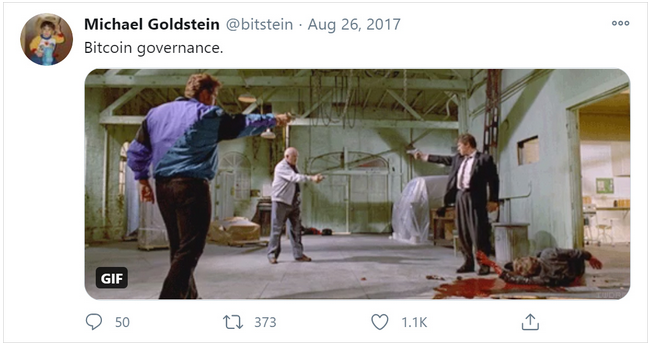
Source: Twitter
Of course the answers here are not necessarily indicative of how someone would vote with their wallet at the end of the day and I suspect that – more than everything else – bitcoiners who stuck with BTC during the scaling wars care about being in consensus with as many other people as possible to protect Bitcoin‘s network effect.
If you’re like me, you might think that we should protect Bitcoin’s long-term sustainability by discussing such options as a security tax or supply inflation today – of course without activating them before it provably becomes a problem. But even though this isn’t communicated anywhere, I think most people’s initial reaction to such discussions is that they see them as slippery slopes.
The idea of a slippery slope is that a chain of itself innocuous events could lead to some eventually very bad change, such as the slow erosion of Bitcoin’s anti-inflation values. In order to prevent a slippery slope from happening, bitcoiners create Schelling fences – a concept which actually explains quite well what we are seeing today.
On schelling fences and social signaling
A Schelling fence (first introduced by Scott Alexander) is a Schelling point that people make a credible precommitments to defend – almost like a binding contract with themselves. Maybe the best example most of us would be familiar with is to never even smoke the first cigarette, because you don‘t know what it will do to you.
To return with to the example of inflation, the slippery slope argument would be that if we normalized the idea of 0.01% tail inflation today, we might also eventually accept the idea of 0.02% tail inflation, and so on, until Bitcoin has become indistinguishable from fiat money. Because we can’t trust our future selves, we commit to never even entertaining the idea of inflation, even if that means going down with the ship.
Creating these precommitments serves as the first line of defense to negative changes to Bitcoin, but it also serves more functions beyond that:
- Users constantly signal their precommitment to other bitcoiners, both to verify that they are still on the right track as well as to strengthen the shared commitment with the rest of the tribe.
- During attacks or other bad events, it’s important that everyone already “knows the drill” because they have a precommitment to the values they want to defend and how.
- There is tremendous value in making that intangible precommitment tangible to newcomers. The more people who are less familiar with Bitcoin’s lore and history can rely that the existing community is hell-bent on defending Bitcoin‘s core protocol values, the more safely they can hold and use and build on Bitcoin at the end of the day.
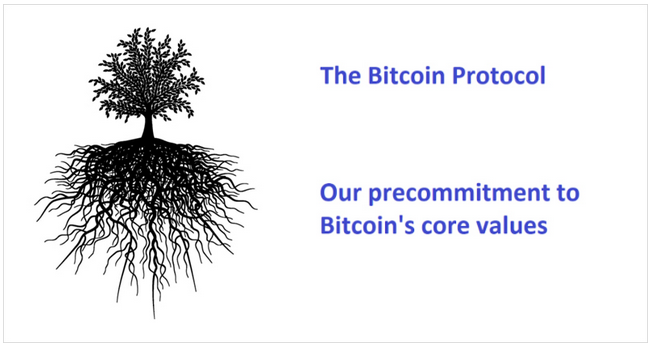
Caveats to this analysis
I’d be remiss if I didn’t mention several caveats that are inherent to any such “social science” experiment.
- An analysis like the one I did today is incredibly subjective and shouldn’t be seen as something that represents the diverse views of the Bitcoin community, most of whom are not my Twitter followers.
- The problem with polling current holders is that they’re a minority of future users if usage actually picks up, who might hold very different views of what Bitcoin should do and where the Schelling fences should be put. This is akin to the argument that all strongly libertarian leaning people in the world are already in Bitcoin, so the marginal person who joins Bitcoin tomorrow is bound to be increasingly less ideological about its values and more focused on its every-day use value.
- While people can be allergic to intentionalism, Satoshi left us a lot of “originalist” literature of what he intended Bitcoin’s social contract to be. Whether bitcoiners stick by what Satoshi had planned is a different matter, but the intentions of its creator are at least a strong natural Schelling point.
- Bitcoin is not a democracy, and most peoples’ votes don’t matter. At the end of the day, most of us are here because we believe that the free market can produce a better money than governments can. Most of us are not smarter than the market, and ultimately listen to what the markets want. So if we do end up getting a clash between two mutually exclusive core values in Bitcoin, I could imagine that most people will continue to ride with what the market sees as most valuable (e.g. in the form of fork futures or prediction markets) and use that to inform their own views.
(1) The logic is that a censor always earns the block subsidy, but only the fees of uncensored transactions. I want to link to Eric’s Voskuil’s post on the matter, but Libbitcoin.org seems to be down right now
How Bitcoin’s Power Consumption Is Good for the Planet
By Jason Deane for Cryptowriter in association with Voice
Posted November 11, 2020
A controversial proposition that might just hold water
In early 2018, an analyst called Alex De Vries at Pricewaterhouse Coopers (PwC for short, thank goodness) produced a report entitled “Bitcoin’s Growing Energy Problem” which seemed to provide a plausible calculation of the power consumption of the Bitcoin network.
It seemed viable, was generally well supported and, rightly on wrongly, went on to become the basis on which many lasting assumptions about Bitcoin’s power consumption were made. It was timely enough that I even included a detailed reference to it in one of the chapters of the book I was writing at the time called “How to Explain Bitcoin to Your Mum”.
The chapter was called “Why Bitcoin WON’T work” which was a counterpoint to the preceding chapter entitled, surprisingly enough, “Why Bitcoin WILL work”.
Some, however, questioned the validity of the underlying assumptions about the type of equipment used a reference point to calculate power consumption and some considered whether renewable energy had been given enough consideration overall.
While both points are far from resolved, the latter was revisited by the same analyst a year later when he produced another report entitled “Renewable Energy Will Not Solve Bitcoin’s Sustainability Problem”, the main conclusion of which is probably self explanatory.
The size of the problem
De Vries had done the best he could with the data available, as had many others when trying to answer the question of just how much power Bitcoin consumes, but the actual number varies considerably depending on who you ask and at what point in Bitcoin’s history you need an answer for — and with good reason.
The Bitcoin Energy Consumption Index has long since estimated total power consumption and, as of today, estimates a figure of 74 TWh (Terrawatt Hour), which is roughly equivalent to the entire power consumption of Venezuela, at least according to their latest official estimate which, oddly, was way back in 2015.
Even getting accurate energy consumption data by country is surprisingly hard and often the range of official estimates varies according to which source you refer to. No single source, in fact, appears to have a consistently up to date list of energy consumption levels, a point I find interesting in itself but is beyond the scope of this article.
Nevertheless, it is certainly possible that Bitcoin’s current power consumption is more than Denmark, Hungary, Hong Kong, Portugal, Singapore, Bangladesh, Israel, Greece, Kuwait, Switzerland, Chile and Austria to mention just a few.
In fact, assuming this data is correct and Bitcoin was classed a country it would be ranked 39th in the world according to the official list of countries by power consumption provided, interestingly, by the CIA. Yes, that CIA. (Note: there are other lists, but they are not dissimilar)
Just the mere possibility of that is astonishing, but the reality is that it could be even higher. Recently, a note appeared on the official Bitcoin Energy Consumption Index that simply read:
Study reveals Bitcoin’s electricity consumption is underestimated … (August 2020).
Following the link provided leads to a new report that concludes that, as of the end of 2019, the conservative estimate was actually 87.1 TWh of power, not 42 TWh as shown on the chart. By that reasoning and using the same formula, does it mean consumption is actually closer to 150 TWh today?
If so, that puts the Bitcoin network as the fourth biggest consumer of power on the planet. Bitcoin would therefore consume more power than every other country except the entire European Union combined, the United States and, of course, China.
Could this really be the case, and if so, what does it mean for sustainability and Bitcoin’s future?
Whoa, there
Before we get all carried way with this revelation, it should already be clear that there is significant doubt over just how accurate this data is.
After all, if countries themselves are unable to provide good, solid data for their own consumption figures, how can we possibly say with any accuracy what the true consumption of a disparate bunch of machines spread across the planet really is, especially when we don’t really know quantities or specifications?
However, even as a proponent of the ideology and practicality of Bitcoin, I will absolutely concede that it is a) “a lot” and b) set to consume more power as time goes on — at least for now, a point we will revisit shortly. We need to examine what happens next, but since we have no universally agreed data as a starting point it is perhaps more useful to look at trends and take a broader view.
In fact, it may be the only way.
There’s power … and there’s power
When breaking down the “a lot” figure, there are a few caveats that we need to mention, specifically different types of energy classed as renewable, stranded or unsold energy.
While it’s usually claimed that “most” Bitcoin mining is carried out via renewable energy (hydro, wind, solar etc), the University of Cambridge’s September 2020 report challenges this — at least partially.
It certainly agrees that some 76% of miners use renewable energy as “part of their energy mix” but states that, overall, only 39% of total energy is genuinely from renewables, most commonly hydroelectric power.
This is to do with the allocation of hash power — while the Asia-Pacific (APAC) region still produces most of it, their percentage of renewable energy is only 29%, whereas it’s as high as 70% and 66% in Europe and North America respectively where hash output is lower.
However, since the world is, generally, moving towards renewable energy at an ever increasing rate, it is clear that this percentage will increase over time, but it’s hard to say what timescale is needed to make the difference.
In addition, there are some circumstances where there are some directly positive outcomes of Bitcoin mining.
“Stranded” energy, for example, refers to energy that would otherwise be wasted or unused, most commonly gas that has to be deliberately flared due to lack of pipeline capacity or is simply located where it is not cost efficient to transport.
In those cases, such as the mining farms created in Texas and North Dakota for exactly that reason, there is an unquantifiable benefit of avoiding that action.
Finally, there are areas in the world where too much power is produced and there’s no efficient way of transporting it anywhere or to reduce the power output in a way that makes economic sense. This is common, for example, around hydroelectric dams.
Here, power is sold very cheaply to mining operations on condition they locate themselves in these areas. This creates a win-win for the provider, consumer AND environmentalists since no extra power is technically produced. Mining farms are one of the few industries that can operate pretty much anywhere as long as an internet connection is available.
However, in truth there is currently no way of quantifying the beneficial aspects against the obvious negative ones of coal or oil fired power generation, but we can safely assume that the former is much smaller than the latter and the net effective is still a negative one.
The bigger question would have to be this: if ALL Bitcoin mining was done on a renewable energy basis, would that ultimately be considered a satisfactory outcome for all concerned? For some, yes, but for others, no.
Even without the power issue, there are still environmental concerns. ASICs (the machines used by Bitcoin miners) can only do one task and when they reach of life, they are not easy to recycle, if at all. Almost certainly, hundreds of thousands of these machines have found their way into landfill with the promise of more to come.
Not only that, but mining rigs produce a lot of heat and either need more power to cool them (this is, in fact, a significant part of the quoted power consumption figures) OR they need to be located where it is cold.
In the latter case, could there be a long term environmental issue caused by dumping a giant heater in a cold place? Logic would dictate that there certainly could be.
It seems the problems for Bitcoin keep mounting up.
But, of course, we’ve been here before.
Deja Vu
Any “gold rush” for new tech leaves a path of destruction behind it. It has always been the case and probably always will be.
Whilst trying to think of a solid analogy, I decided (after rejecting many other possibilities) the most appropriate one was probably the PC itself.
After all, the explosive growth in PC use is still within living memory, the global tech development race was similar and these items were all designed to be used as tools to support and use the main non-sovereign, non-physical product that was initially hard for people to get their heads around — i.e. the internet.
According to historical data collated by Gartner and presented on Wikipedia, between 1996 and 2003 some 922 million PC units were sold globally. I chose these dates because this was the era of proper ‘first gen’ home computing, where connectivity to the net, such as it was, was possible, but difficult. After 2004, ADSL lines and other solutions started to become widely available and the tech began to change accordingly.
That’s a huge amount of boxes, but how many of those do we still use today? The answer, almost certainly, is none. Well, apart from the one my mum keeps in her spare room to play solitaire on occasionally.
Almost a billion units have been thrown away and, since these were the days before recycling, they also probably made it to the landfills too. And what about the billion or so modems we produced in the days before ADSL? Now all gone too. It was expensive both in terms of environment and dollars, but things have settled down considerably since then.
Last year just 261 million units were shipped compared to the peak in 2011 of 353 million, a drop of 102 million units in a trend that is still falling. We use other devices these days instead of just computers and we tend to upgrade far less frequently anyway as the gap between hardware and software capability has narrowed.
The PCs we do still use are far more energy efficient than their ancestors, especially in terms of monitors, so as the amount of connections to the internet have increased over the years, it’s likely that power consumption hasn’t increased proportionately.
My view is that, over time, we will see the same with Bitcoin.
Right now, we’re in an arms race where even a slightly better machine is sought after at almost any price in the same way a 66Mhz processor was favored over a 33Mhz processor in the early, frantic days of computing.
But like PCs, over time this will settle down and many of the issues will be resolved, something I may seem overly confident about.
Here’s why:
The Future and Context of Proof of Work
Although I am a self-confessed optimist on, well, pretty much everything really, I am also quite cynical about certain aspects of human nature. The bottom line is that, collectively, we just won’t care enough about things like the environment unless a) it affects us directly and b) it makes us money.
The trick, therefore, is to align global needs with selfish needs, or, to put it another way, to ensure that making money happens to coincide with things that are beneficial to the planet.
And although Bitcoin seems to be the opposite at first, from a long term perspective there’s a natural alliance that could actually turn out to be very beneficial for all parties concerned.
Making money as a Bitcoin miner is all about efficiency and, as time goes on for technical reasons, this becomes more and more important.
Right now, we’re using the mining equivalent of the huge, extremely inefficient engines that were prevalent in American cars in the 70’s and got 8–10 miles to the gallon. After all why not? Fuel was cheap, plentiful and the environment (whatever that was) was fine with it, right?
But you’d never buy a new car like that now, partly due to a change in social awareness, but also because it would be too expensive to run. As soon as it becomes more about money, we pay attention.
Right now, new, sleeker tech is being developed. Each generation will produce more hash power for less energy and as these lines converge — as they always do — it simply won’t be cost effective to run older, hotter, juicier equipment that needs to be frequently upgraded.
As time goes by, and even as Bitcoin’s hashrate and influence increases, I bet you any money (in bitcoin please, not dollars) that its carbon footprint doesn’t increase in proportion to that growth.
This will be partly because of the equipment itself, but also due to the fact that earlier this year a whole swathe of reports, such as this one, came out confirming that solar and wind are now the cheapest forms of energy production on the planet. Renewables, like Bitcoin, are here to stay and will now grow faster than any other sector as a result.
About time too.
A net reduction?
I further bet you based on what we’ve seen historically, applications of Moore’s Law (the concept rather than the technical absolute) and the fact that we humans, collectively, are predictable when it comes to money, that this power consumption will plateau and even fall eventually.
It’s a bold statement and it’s definitely not something that will happen next year — although certainly could within the next decade — and I’m happy to go on record with that forecast.
There’s always a counter position of course, and the most relevant one in this case is the LED light argument, covered in this article. The crux of this report is that overall power consumption in lighting has increased, even though much less power is now required to produce the same amount of light.
I’m sure that’s true as population and applications have grown on a global level, but when I switched all my lights at home to the latest-gen LED lighting, I noticed an immediate and significant reduction in both power consumption and energy bills as well as a far superior light. I have also never had to replace any bulbs as yet, something I definitely would have done several times over by now using the old, hot, inefficient tech.
I think we can safely assume Bitcoin miners, on an individual level, will consistently seek to do the same. After all, their livelihoods depend on it.
And there’s also one more consideration worth noting.
It’s easy to overlook that the traditional banking and global payment processing sectors also require enormous amounts of power to run, although it’s even harder to calculate what these numbers might actually be. There’s no single network to base assumptions on and there’s literally thousands of independent companies and organizations who are often not exactly forthcoming about their carbon footprints.
However, we can safely assume that this power consumption, globally, must be at least what Bitcoin’s requirement is.
Bitcoin, in my view, will never replace that existing banking system, nor should it, but there is at least the possibility of reducing it in the long term. For example, every transaction that takes places over the Bitcoin network is, mathematically speaking, a transaction that does not take place on the traditional network.
It’s a very simplified view, but on a big enough and prolonged enough scale, this could make a difference, especially when it comes to decisions about power hungry physical premises and data centers by incumbent financial institutions.
The size of that impact may ultimately be tiny or it may be significant, and my guess is that it will be somewhere between the two. On a global scale, this is therefore a redirect of power resource rather than a requirement for more, and that can be considered a benefit of the Bitcoin network.
The bottom line
I think Alex De Vries work is actually very good as he embarked on a difficult task with little hard information. It has limitations, but these are clearly explained through caveats.
However, I disagree entirely with his prognosis as it assumes that what is happening right now will be the same going forward. I propose that this will not be the case because the parameters will change, the tech will change and as for the rule book — well, we haven’t even got round to writing that yet.
Although I have no doubt that De Vries work is right in the short term while we power through this crazy growth-spurt-cum-gold-rush phase of Bitcoin’s lifecycle, the adoption and management phases will see a different, more measured approach where power efficiency will become ever more important.
This means there will be an even more absolute and direct link between the power consumption of the miners and their standard of living. You can bet, therefore, they will continually seek out the lowest cost energy sources (already proven to be renewables), and the most efficient, lowest heat producing machines that have the best longevity. Y’know, a bit like my LED lights.
They will also do this with a level of motivation that would outweigh anything in the traditional banking sector because they would be directly incentivized to do so.
And when individual needs align with things that are good for the planet, you know they will get done, even if it’s not for the reasons we’d prefer.
Still, we’ll take it.
And so will Mother Nature.
This post is published for Cryptowriter in association with Voice.
Disclosure: The author of this opinion piece has been heavily involved with bitcoin for several years and holds a substantial cryptocurrency portfolio, including bitcoin. He also has a mining operation running the SHA-256 algorithm based in Siberia and is a published author on the subject of promoting the understanding of cryptocurrency.
Jason is an analyst at Quantum Economics, specializing in Bitcoin and macro economics.
Disclaimer: Investing in any asset class is risky. The above should not be taken as financial advice, nor construed as so. Always do your own research before investing or consult with a professional financial planner.
Banks, QE, and Money-Printing
By Lyn Alden
Posted November 22, 2020
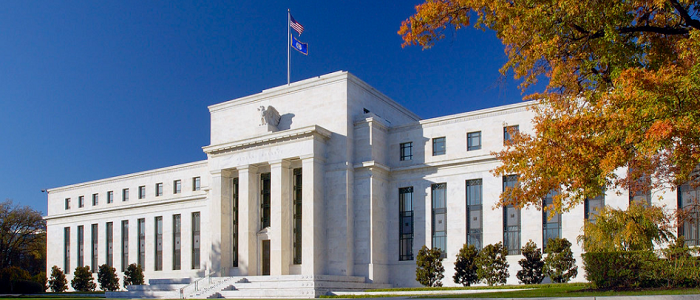
Lately, it has become fashionable to debate what is, or is not, “money-printing” by central banks.
This debate is natural, due to the extreme policy nature of 2020, with massive fiscal expenditures, huge increases in central bank balance sheets, and changes in central bank inflation targets. It’s important to know what is inflationary, and what isn’t, and to what extent.
Because people have very different understandings of how central bank policy and fiscal policy work, there have been analyst calls this year ranging from hyperinflation to deep deflation, and everything in between.
The outcome has of course been somewhere in the middle as measured by CPI or PCE, with inflation that rebounded from March lows in response to policy, but neither much of an overshoot or undershoot, and still generally below long-term central bank inflation targets.
Many inflation categories for the most essential and non-outsourced goods and services, however, have risen faster than the overall basket this year, and in recent years.
The crux of this article is that quantitative easing on its own, and quantitative easing combined with massive fiscal deficits, are two very different situations to consider when it comes to analyzing the possibilities between inflation and deflation, and what constitutes “money printing”.
The Deflationary Backdrop
Before diving into the mechanisms of money-printing, it helps to set the stage. Context is key.
Historically speaking, we’re coming down from the apex of, and currently within the lengthy resolution process of, a long-term debt cycle, which refers to a multi-decade peak in public and private debts relative to the size of the economy and money supply. This occurs in the aftermath of when interest rates hit zero.
We’ve been in this resolution process for the past 12 years, and the previous time before that was the two-decade period of the 1930’s and 1940’s where we hit the previous apex of a long-term debt cycle.
Here is total debt as a % of GDP in the United States over the past century in blue on the left axis (all debts, public and private), along with short-term interest rates in orange on the right axis:
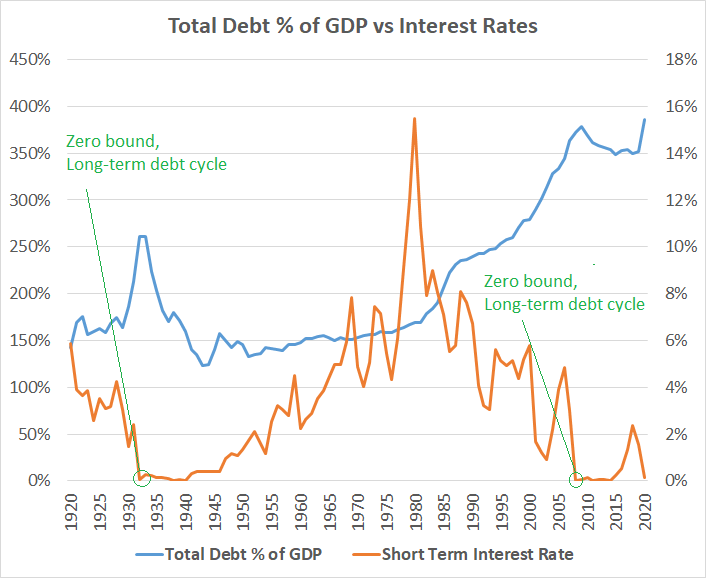
Data Sources: U.S. Treasury Department, U.S. Federal Reserve
And here is total debt as a % of the broad money supply, which shows the structural peaks of each cycle even more clearly (since policymakers have more influence over broad money supply than GDP, due to shifting monetary velocity):
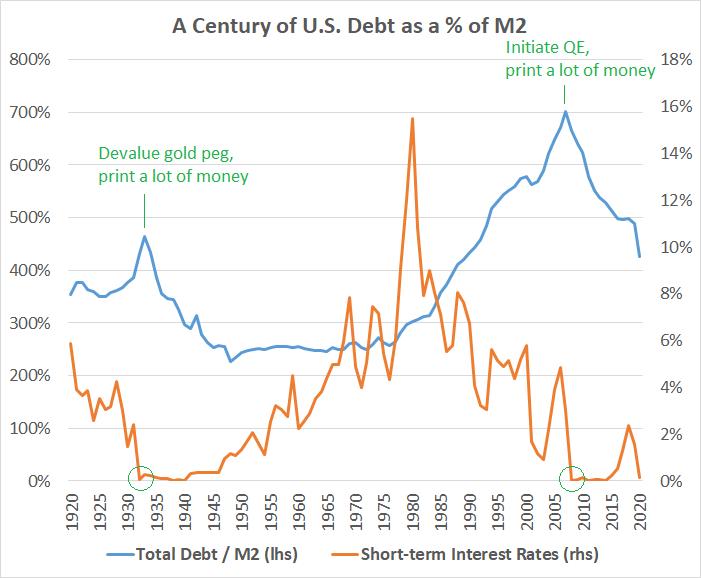
Data Sources: U.S. Treasury Department, U.S. Federal Reserve
If we break out federal debt from non-federal debt (households, businesses, states, financial leverage, etc), we see two distinct peaks in each long-term cycle. Non-federal debt (orange line) peaks first in a commercial banking crisis (early 1930’s and late 2000’s), and then federal debt (blue line) peaks many years later in a sovereign debt crisis (mid-1940’s and ???-2020’s):
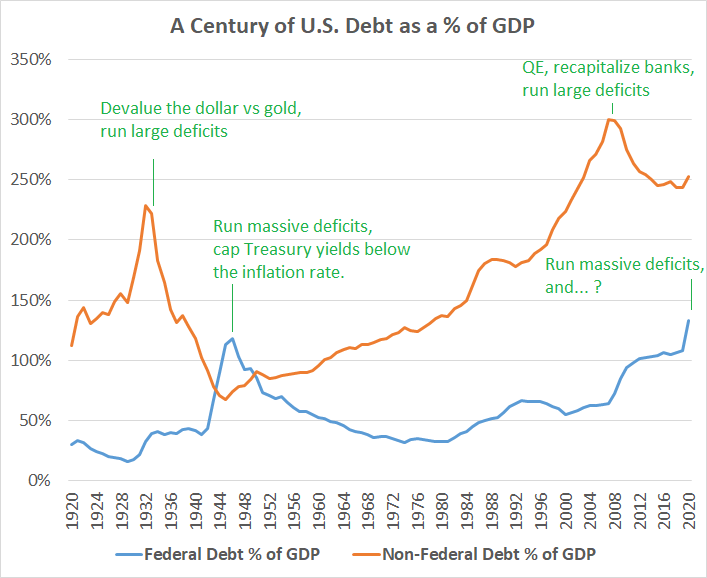
Data Sources: U.S. Treasury Department, U.S. Federal Reserve
There are a lot of deflationary forces on consumer prices in the economy:
- High private debt levels are deflationary, since it makes consumers and businesses financially restrained and risk-adverse.
- Slowing population growth and aging demographics are deflationary, since resource demand slows.
- Technology is deflationary, since it makes some things cheaper and better.
- Wealth concentration into fewer hands is deflationary, since money coalesces rather than circulates.
- Commodity oversupply is deflationary, since it cheapens the building blocks we use for everything else.
- Outsourcing is deflationary, since it lowers labor costs of goods and puts downward pressure on domestic wages.
In a low-debt system, structural deflation for some of the positive reasons, such as technological improvement, would be a good thing. It means your money’s purchasing power grows over time, as higher productivity from technological enhancements lowers the cost of goods or improves their quality, so you get more value for your dollar.
However, in an extraordinarily high-debt system (which requires a lot of central policy intervention in the first place to be able to get up that high), deflation breaks things and results in widespread defaults, because the cost of servicing debts goes up relative to cash flows.
So, fiscal and monetary policymakers deliberately push back on deflationary forces with inflationary policy, especially when it gets to those extremes. And there are a few definitions or types of inflation that we can identify.
Monetary inflation refers to the growth of the broad money supply, which can be calculated in a few ways but is pretty straightforward.
Asset price inflation refers to bubble-like increases in the prices of financial assets, like stocks, bonds, gold, private equity, fine art, and so forth. This is a bit more subjective because valuations on assets can vary, but there are various ratios to keep track of it in a broad sense.
Consumer price inflation refers to a broad rise in the prices of everyday goods and services, and people debate about how it should be measured. The government uses CPI and PCE calculations on a basket of goods, but those use various substitutions. There are alternative calculations that don’t use substitutes, which generally lead to higher figures.
Each household has their own unique basket of consumer goods and services that they buy. For research purposes, I calculated that my personal household consumer price inflation rate averaged about 3% per year over the past two years, taking into account our total purchases of non-investment goods and services.
QE Alone = Bank Recapitalization
Going into the 2008 crisis, U.S. banks were extremely leveraged, with very low bank reserves.
Large bank cash levels equaled just 3% of their assets (blue line below; cash as a percentage of total assets), and large bank holdings of Treasuries as a percentage of assets were pretty low historically as well (red line; treasury securities as a percentage of total assets):
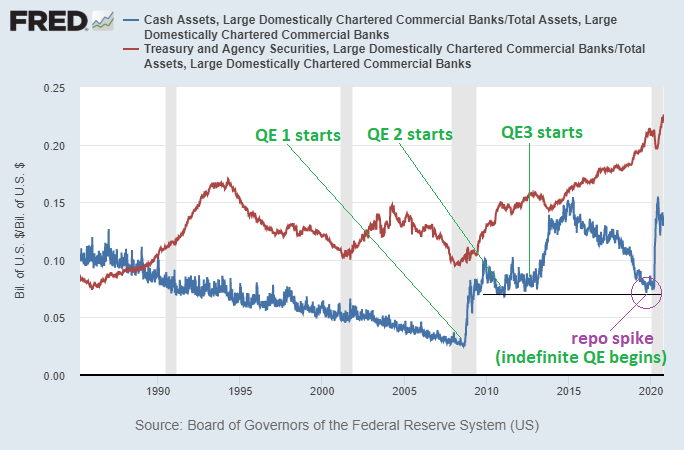
Chart Source: St. Louis Fed
So, leading into the financial crisis, only about 13% of their assets consisted of cash (3%) and Treasury securities (10%). The rest of their assets were invested in loans and riskier securities. This was also at a time when household debt to GDP reached a record high, as consumers were caught up in the housing bubble.
That over-leveraged bank situation hit a climax into the 2008/2009 crisis, coinciding with record high debt-to-GDP among households, and was the apex of the long-term private (non-federal) debt cycle. When banks are that leveraged with very little cash reserves, even a 3% loss in assets results in insolvency. And that’s what happened; the banking system as a whole hit a peak total loan charge-off rate of over 3%, and it resulted in a widespread banking crisis.
However, banks were bailed out via QE and the Troubled Asset Relief Program. It was a top-down, anti-deflationary bank industry bailout, but not a bottom-up, pro-inflationary real economy bailout. TARP boosted bank solvency, and QE boosted bank liquidity.
As the crisis played out and some banks failed and others were bailed out, regulators wanted to increase bank reserve requirements and capital requirements, requiring banks to hold a greater percent of their assets in cash reserves and other safe assets. The problem with that, however, is that banks can’t just magically boost up their reserves; they would have to sell other assets to get cash, but if every bank in the system sells assets to get cash, who do they sell to, and where would so much cash come from to buy what they sell?
In other words, while it’s possible for an individual bank to boost its reserves by selling assets to raise capital, it’s mechanically impossible for the entire banking industry to collectively raise its reserves industry-wide.
So, in the role of lender/buyer of last resort, the Federal Reserve created new cash reserves out of thin air, gave them to the banks, and took some of their Treasuries and mortgage-backed securities in return, aka quantitative easing or QE. Along with TARP, this recapitalized banks, bringing them from 3% cash as a percentage of assets at the start of 2008, to 8% by the end of 2008. The Fed did further rounds of QE through 2014 that brought banks collectively up to 15% cash levels, which brought them up to frothy levels of excess reserves.
This, however, didn’t result in more money chasing fewer goods and services, and therefore wasn’t particularly inflationary for every prices. The money remained mostly internal to the banking system, at higher reserve levels. Broad money supply didn’t increase rapidly.
Many analysts that were worried about inflation missed the fact that the transmission mechanism from QE to the real economy was small, so this was mostly just a bank-recapitalization process. Banks and their executives got a nice assist from the Fed and Treasury, but the broad public did not. Banks didn’t lend much of the money out (nor was there a ton of creditworthy demand for them to do so), and fiscal spending didn’t go around the banking channel very much either.
A similar version of this played out in the 1930’s, which was the previous time that interest rates hit the zero bound at the apex of a long-term private debt cycle. The banking system collapsed back then too, so policymakers devalued the dollar vs the gold peg, expanded the monetary base, and recapitalized banks during a banking holiday. This was enough to offset the deep deflation that was happening in the early 1930’s, and turn it back into a reflationary trend in the mid-1930’s, but not enough to cause rapid broad consumer price inflation. It was anti-deflationary, in other words, but not outright inflationary.
The Inflation Fake-Out
All told, the Fed expanded their balance sheet by about $3.5 trillion from mid-2008 to the end of 2014. They created new bank reserves to buy Treasuries and mortgage-backed securities.
Many folks thought this would be hyperinflationary, Weimar Republic style. So, they bid up the price of gold rather high. I’m glad they felt that way, because I sold my gold to them in 2011, during a period of very high sentiment. It’s the only time I sold physical bullion. I wanted to load up on historically cheap stocks instead.
Here was the gold price relative to my model (i.e. orange area way above blue line):
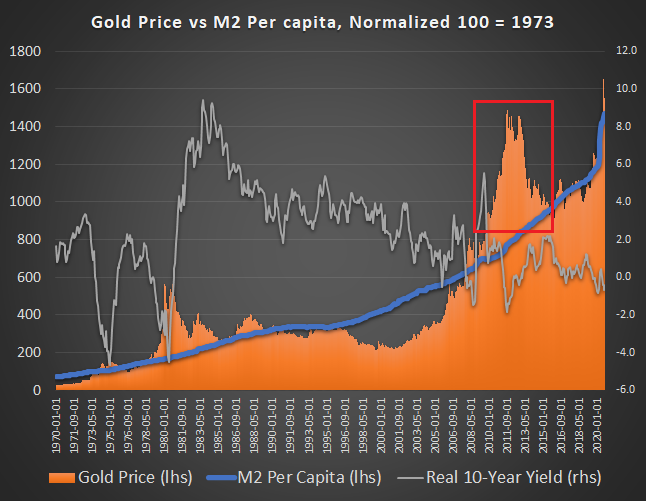
Data Source: St. Louis Fed
And here were stock valuations relative to fundamentals:
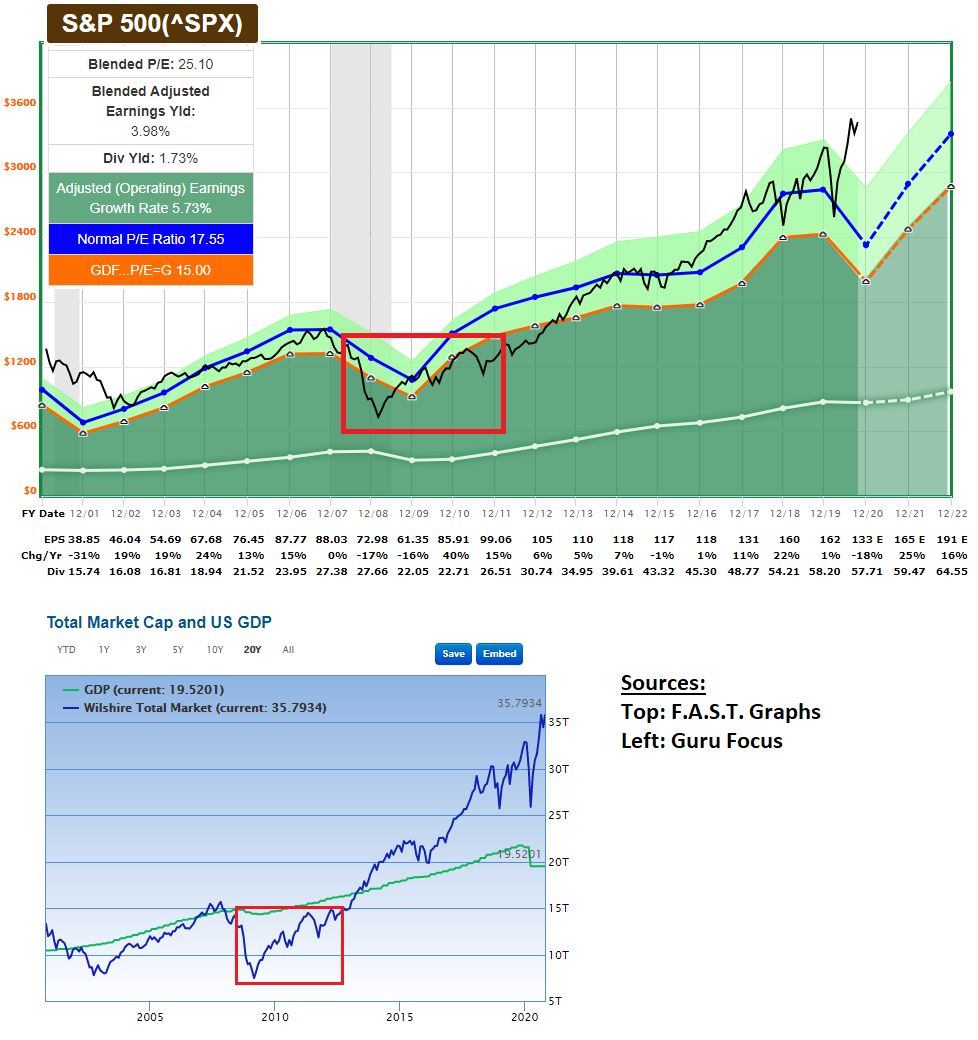
Of course, this QE ended up not being outright inflationary for consumer prices, for reasons described before. It was anti-deflationary, rather than outright inflationary. Along with low rates, it was somewhat inflationary for asset prices, but not most consumer prices. That’s how it worked in the 1930’s, too.
We can put some broad numbers on it. From 2007 to 2009, there was a $11 trillion decline in U.S. household net worth, as it fell from $71 trillion to $60 trillion, due to a decline in stock and house prices. It then took about five years for U.S. household net worth to recover to previous highs. This was $11 trillion in deflationary wealth destruction (plus technology improvements, and commodity oversupply, tightened credit for home equity loans, and other deflationary forces), up against the response of $3.5 trillion in Fed bank reserve creation or QE. Of course it wouldn’t be hyperinflationary.
Morally hazardous? Sure. Hyperinflationary? No.
Moreover, as previously-described, most of the $3.5 trillion never entered the broad money supply because there was no major fiscal transfer mechanism, so it mostly just stayed in bank reserves. It offset a deflationary shock and bank collapse by recapitalizing the banking system with higher levels of solvency and liquidity (and thus was anti-deflationary), but it was not outright inflationary.
Bank Reserve Example
Banks, in practice, are limited in how much leverage and risk they can take by their regulatory capital requirements. In this model, there are some very low-risk assets (like bank reserves, Treasury securities, and gold) that don’t count against the bank’s risk level, and there are higher-risk assets (like personal loans, or corporate bonds) that do count against a bank’s overall risk level. Banks need to maintain an appropriate balance of assets to avoid being considered too risk-heavy.
In some regulation regimes, banks can also be constrained by reserve requirements, meaning that banks are required to have a certain percentage of deposits stored as cash reserves.
Suppose that there is a regulatory rule which says that all banks must have an amount of cash equal to 5% of their customer bank deposits (which are liabilities for banks; owed to their customers) held in reserve at the Federal Reserve. So, if a bank has $100 billion in customer bank deposits held with them (which are liabilities for the bank), and $110 billion in assets (and so they have $10 billion more assets than liabilities), they can put up to $105 billion of their assets into various forms (making loans, buying securities, etc), but must hold at least $5 billion in cash reserves at their account with the Fed.
Here is a reserve-constrained bank example. A bank has $100 billion in deposits (liabilities), and $110 billion in assets. Of their assets, $5 billion is in cash reserves, $20 billion is in Treasuries, $10 billion is in mortgage-backed securities, and $75 billion is in other assets (personal loans, mortgage loans, corporate loans, and/or whatever else). This bank can’t lend anymore, until either it collects more deposits which would also boost reserves, or sells some existing assets. It is therefore reserve-constrained. It might want to lend, and has good client demand to lend money to, but it simply can’t leverage itself anymore. If the Fed were to create $5 billion in brand new reserves (aka QE) and buy $5 billion of their Treasuries or mortgage-backed securities, it would alleviate their reserve-constrained status, and the bank could use that $5 billion to lend more, or buy more securities. This would be economically stimulative if the bank wants to lend money, because now the bank can go ahead and lend that money, and thus create deposits somewhere in the system and increase the broad money supply.
Here is a non-reserve-constrained example. A bank has $100 billion in deposits (liabilities) and $110 billion in total assets. Of their assets, $15 billion is in cash reserves, $20 billion is in Treasuries, $10 billion is in mortgage-backed securities, and $65 billion is in other assets. This bank has $10 billion in excess reserves above the $5 billion requirement; extra money it can lend. Maybe it doesn’t want to lend right now; it doesn’t see any good risk-adjusted loans to make. Or maybe there isn’t a lot of demand from its clients to borrow money. So, it’s just holding that extra $10 billion as excess reserves, in addition to their $5 billion required reserves. If the Fed were to do QE and buy $5 billion of their Treasuries, and bring the bank up to $20 billion in reserves, it won’t affect how much they lend, because they weren’t reserve-constrained to begin with. This would not be stimulative and would not increase the broad money supply, since it doesn’t coerce the bank to make any more loans.
That is why QE alone isn’t inflationary. Increasing bank reserves does not necessarily increase the broad money supply. A rapidly increasing broad money supply along with constraints on the supply of goods and services, is what can lead to inflation.
There are two ways to increase broad money supply. Either banks need to lend, or the federal government can go around them and run big fiscal deficits. At the apex of a long-term debt cycle, the latter tends to happen.
QE + Fiscal Stimulus = Money Printing
Now in 2020, in the next recession twelve years after the 2008 banking crisis, we’re back at it and bigger than before, but with a twist.
This time, going into the crisis, the banking system was already well-capitalized. The percent of bank assets that consist of cash and Treasuries was already historically high. So, unlike 2008, banks weren’t over-leveraged. However, the broader economy was over-leveraged, and the pandemic hit the broader economy.
Millions of people became unemployed, and countless businesses faced insolvency risk as their cash flows collapsed. For the Fed to simply buy Treasuries and MBS from banks wouldn’t do almost anything for this, because it’s not a bank recapitalization issue, and there would be no transmission mechanism to the public. Banks were already well-capitalized, and so the banks weren’t reserve-constrained.
Instead, this time, fiscal authorities (Congress and the President) spent trillions of dollars into the real non-bank economy, sending folks stimulus checks, boosting unemployment benefits by an extra $600/week (which is $2,400/month for several months for folks who received it), financing banks to give small businesses PPP loans that mostly turn into grants, and partially bailing out some of the hardest-hit corporate industries with fresh capital injections. It was a much larger stimulus than anything from 2008/2009.
The way that the government’s accounting works in the current legal structure, is that they have to issue a lot of Treasury securities to fund that expenditure. However, the foreign sector was not really buying Treasuries, and in fact were selling some Treasuries early this year. So, who would be available to buy $3 trillion in extra Treasury securities this year?
Enter the Fed again. When the Treasury market became illiquid in March from foreigners and hedge funds selling Treasuries against a backdrop of insufficient buyers, the Fed stepped in, and created $1 trillion in brand new bank reserves out of thin air to buy $1 trillion in Treasuries over a 3-week period. This was the most rapid asset-purchase program the Fed has ever done. And then they tapered that rate but kept buying Treasuries for months to soak up the massive 2020 Treasury issuance that funded all the stimulus, and are still buying tens of billions of dollars of Treasuries monthly with newly-created bank reserves to this day.
So, the Fed once again increased its balance sheet (this time by nearly $3 trillion in just three months) to buy a large chunk of Treasuries, plus some other assets like mortgage-backed securities and a handful of corporate bonds. About $2 trillion, or 2/3rds of this 2020 balance sheet expansion so far, consisted of buying Treasuries. But what made this one different, was that it didn’t just stay in the banking system to recapitalize banks. It flowed through banks to the U.S. Treasury Department, which injected that money directly into the economy as authorized by Congress’ CARES Act.
This following chart shows the year-over-year change (in billions of dollars) of total U.S. commercial bank deposits in blue, government transfer payments in green, and the Fed’s balance sheet in red:
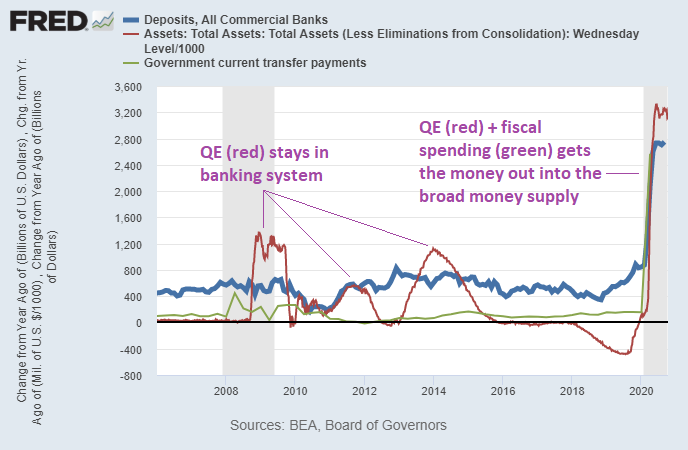
Chart Source: St. Louis Fed
That chart is critical to see why 2020 and 2008 were quite different, and why the policy response acted so much quicker and more powerfully on financial markets and personal income this time. Personal income and net worth on a nationwide scale went up, rather than down, in 2020 so far.
In 2008-2014, there was a lot of QE (red line going up), but those dollars didn’t get out into public bank deposits (which is what mostly makes up the broad money supply). This was because there was little or no fiscal transmission mechanism; the government wasn’t sending huge checks to people. So, the green line (year-over-year change in government transfer payments) and blue line (year-over-year change in bank deposits) remained low. The QE process in 2008 mostly just recapitalized banks.
However, 2020 was a very different story. The government sent out tons of money directly into the economy, and financed it by issuing Treasury bonds that the Federal Reserve created new bank reserves to buy. For legal reasons, the Fed buys those securities on the secondary market, but that doesn’t make much of a difference in practice; it’s where they end up and remain that matters. The banks that buy them from the Treasury and sell them to the Fed just act as pass-through entities in this case.
So, the blue, green, and red lines all went vertical in 2020, unlike the 2008-2014 period. The government sent money to people and businesses (green line), that money showed up in their bank deposits (blue line) and thus in the broad money supply, and the Fed created new bank reserves to buy a lot of the Treasury securities issued to fund that program (red line).
Or, put simply, the broad money supply went up a lot in 2020, but didn’t budge nearly as much in 2008/2009 (in either absolute or percent terms), because QE alone to recapitalize banks, and QE-financed fiscal stimulus into the real economy, are two very different situations:
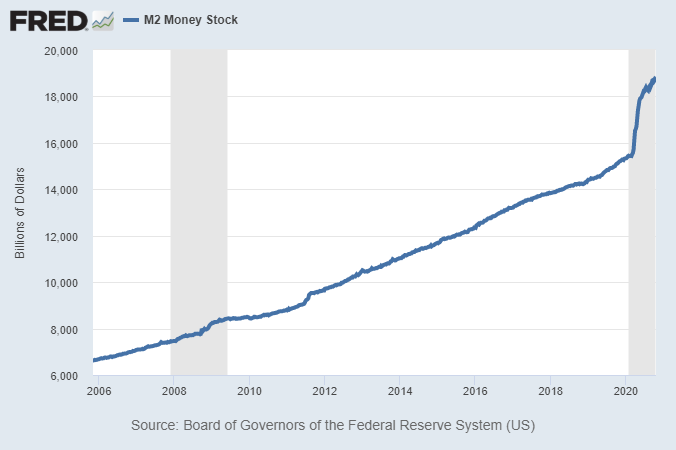
Chart Source: St. Louis Fed
Many people who saw the inflationary non-event from 2008-2014, are suggesting that QE is inherently deflationary, and that it won’t cause inflation this time either.
I’m glad many people feel that way, because I’m happy to buy their gold from them on dips. I bought plenty of precious metals back in 2018 and have cooled my purchases since then due to the notable uptick in price, but am still happy to dollar-cost average into them at these prices, or buy on dips. I also like cheap natural resources more broadly, as well as high-quality equities, real estate, Bitcoin, and other scarce assets for a diverse mix, with a long-term view.
In my view, the “QE is deflationary; it only increases bank reserves!” position is from not taking into account the fiscal element; the transmission mechanism that gets QE into the hands of the public rather than stuck in the banking system. QE alone is not inflationary and mostly stays in bank reserves, but QE combined with massive fiscal deficits, is inflationary, and gets the funds out into the broad money supply, out into commercial bank deposits of the public.
Basically, massive fiscal spending combined with the central bank buying lots of sovereign bonds to fund it, is a modern monetary theory “MMT” program in practice, for the first time since the 1940’s when the equivalent of “wartime MMT” was used.
Now, bear in mind that this is still up against large deflationary forces: technology, demographics, debt, and shifting consumer behavior around the pandemic. So, even a one-time pro-inflationary $3 trillion injection into the real economy is merely enough to cause a quick rebound in inflation and a sharp recovery in asset prices, as we saw in 2020 from the March lows. Combined with certain supply limitations, it also helped cause non-discretionary prices to rise: grocery price inflation in particular was rather significant this year.
However, a one-time $3 trillion injection is not enough to cause a persistent trend change in inflation. Those deflationary forces outweigh it. There is not yet a situation of too much money chasing too few goods and services, except in niche areas. The stimulus delayed an insolvency crisis for several months and got consumers through the worst 3-4 month period of the economic shutdowns.
If we look over the past century, we can see that the two inflationary decades (the 1940’s and 1970’s) occurred when broad money rose rapidly. This chart shows the 5-year rolling cumulative percent increase in the consumer price index and in broad money supply per capita:
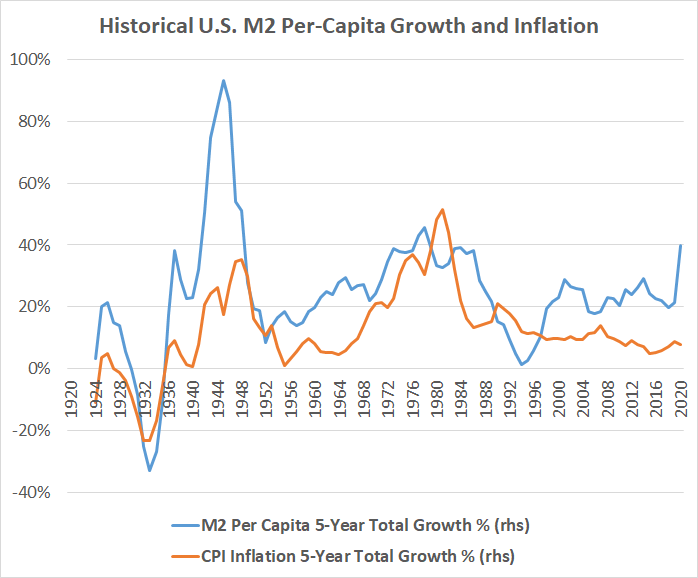
Data Source: U.S. Federal Reserve
Therefore, the big question for investors in multiple asset classes, is whether the fiscal authorities will keep repeating that on a notable scale, or whether they will cool off. Without the massive fiscal+QE “MMT” combo, the economy remains in the grip of structural disinflation, and a renewed cyclical disinflationary trend. However, with another round of massive fiscal+QE “MMT” combo, the outcome would likely be more of what we saw in spring/summer of 2020: rebounding inflation and asset prices, and likely eventually pushing too far.
Ultimately, with so much debt in the system and the weight of private debt, policymakers are likely to be forced to do more rounds of fiscal stimulus (either from civil unrest or political donors), but the timing for that is something that investors need to work around when it comes to assessing the inflationary or disinflationary outlook for the next couple quarters ahead.
Right now, with money velocity so low and the pandemic still raging, and plenty of commodity oversupply particularly in regards to oil, it may seem like there is a limitless sink for broad money creation without leading to sustained consumer price inflation. However, that can change a couple years down the line, as the world fully emerges from pandemic effects, after years of not putting much capital into resource development.
It’s also worth noting that “fiscal stimulus” in this sense refers to both spending and taxation. In other words, federal deficits. A fiscal stimulus could include giving everyone a $1,200 check, or could include giving everyone a $1,200 payroll tax cut, for example. The differences between those two mechanisms matter around the margins (particularly for the unemployed, who wouldn’t benefit from a payroll tax cut), but for large chunks of the 150 million working population, a stimulus check and a payroll tax cut are functionally similar throughout the course of a year, and result in more cash in the hands of most people. These policies increase the amount of broad money, not just bank reserves.
When it comes to fiscal stimulus, regardless of whether it takes the form of taxation or spending changes, its stimulatory impact and inflation outcomes are mostly a question of magnitude, as well as who it primarily targets (unemployed, working class, middle class, wealthy, or rich). It’s inflationary, against the deflationary backdrop, and so whether the outcome shifts to inflation or remains disinflationary becomes a question of scale and persistence, and whether it increases productive capacity or not.
Rules Are Meant to Be… Broken? Bent?
In my view, focusing on some of the mechanics of the Fed’s QE combined with fiscal injections is like focusing on the trees and missing the forest.
This is because at the end of a long-term debt cycle, policymakers do whatever they need to in order to avoid a deflationary collapse and get towards some degree of reflation and devalued debt levels.
The Federal Reserve Act doesn’t allow the Fed to buy corporate bonds. And yet, the Fed bought corporate bonds this year.
How did the Fed do that? They worked with the Treasury and Congress, set up a Special Purpose Vehicle, and bought corporate bonds through that vehicle, with any defaults on those bonds funded by the Treasury so the Fed doesn’t face the risk of nominal losses.
People saying this violates the Federal Reserve Act are, unfortunately, falling on deaf ears.
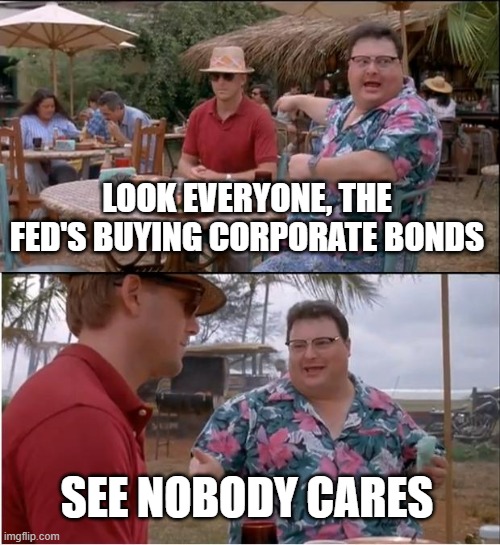
Policymakers went around the spirit of the Federal Reserve Act, but perhaps not the letter of the law due to the structure involved. It’s perhaps not surprising that the heads of the world’s two biggest central banks, the Fed and the ECB, are both lawyers rather than economists.
I personally think that the Fed buying corporate bonds was not a good part of the overall policy response, and sets a bad precedent and moral hazard. But, it happened nonetheless, and it is during the apexes of long-term debt cycles that these sorts of “exceptions” tend to happen.
The Fed has legal limitations on its own, which is good. However, when the Fed works closely with the Treasury Department and Congress to combine fiscal and monetary policy, all bets are off. They worked together closely in 1940’s decade to fund World War II in the second half of the previous long-term debt cycle apex, and they did so again here in the new 2020’s decade.
Love it or hate it, that Treasury+Fed combo is extremely powerful and bypasses just about any limitation that the Fed alone has. The Fed can lend but can’t spend. The Treasury can spend, but if it spends a ton and issues more sovereign debt than there is demand for, it needs the Fed to buy some of its sovereign debt issuance (using primary dealer banks as pass-through entities). The Fed can’t buy certain securities, particularly those that could lead to nominal losses, but with a special purpose vehicle and a financial backstop by the Treasury, they can. Together, they can create new money, and inject it to whoever they want.
Many people think that the broad money supply is only able to increase when banks lend money and create deposits. However, ironically, the biggest increases in the broad money supply historically happen when things are terrible and so banks *aren’t* lending much, and thus when the money multiplier (broad money divided by base money) is low.
At those times, the federal government runs massive fiscal deficits, and goes around the bank lending channel to either tax less from the economy or inject more money into the economy (historically they choose the latter), and finances its massive deficits by having the Federal Reserve create new bank reserves to buy a large chunk of its Treasury debt issuance.
This chart highlights that, by showing the money multiplier on the left axis, with federal deficits as a percent of GDP, and year-over-year percent increase in the broad money supply, on the right axis:
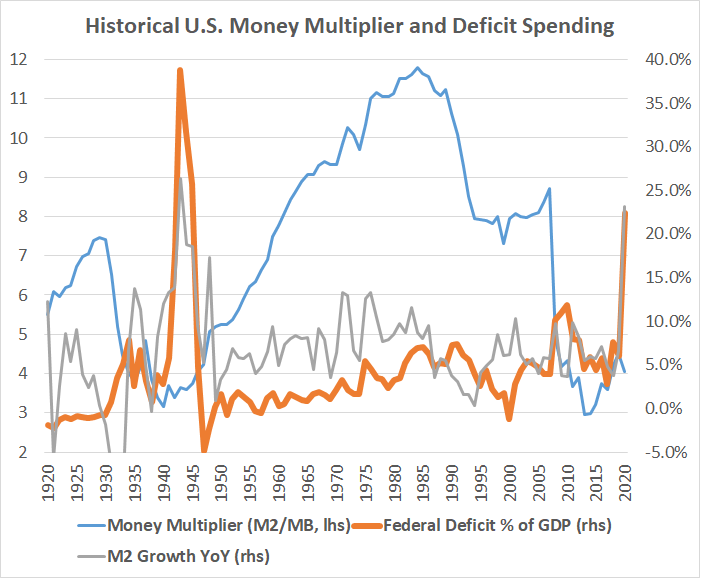
Data Sources: U.S. Treasury Department, U.S. Federal Reserve
However, when it comes to investment timing, sometimes focusing on the mechanics is helpful. So, let’s dive into some of those mechanics.
Bank Reserve Accounting
Bank reserves, referring to the accounts that commercial banks have with the Federal Reserve, are strange beasts because of how unintuitive they are.
In fact, even the very definition of “money” is subject to debate. There are multiple ways to define “money” in the modern banking system.
The monetary base, and the broad money supply, are the two most important definitions, so let’s quantify them for context.
Base Money
The monetary base is the foundation, and consists of physical currency in circulation (currently around $2 trillion) and cash reserve deposits that the commercial banking system has with the Fed (currently around $2.8 trillion).
Although not part of the original definition, because the Treasury’s general account “TGA” with the Fed has grown in size and importance in recent years (currently $1.7 trillion), we functionally should include that as well, since it’s another cash deposit with the Fed. Those three buckets combined are $6.5 trillion in “base money”.
All three of these buckets of base money (currency in circulation, bank reserves with the Fed, and the Treasury’s general account with the Fed) are the Fed’s biggest liabilities. On the other side of the Fed’s ledger, Treasuries and mortgage-backed securities represent most of the Fed’s assets.
If we look at these major Fed liabilities separately, with the TGA in blue, bank reserves in red, and currency in circulation in green, it looks pretty random:
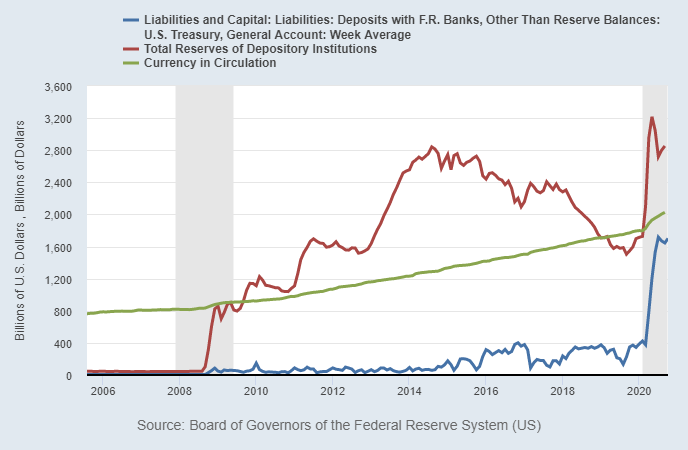
Chart Source: St. Louis Fed
However, there’s a method to the madness, and the Fed controls the total sum.
This next chart shows the sum of those three lines, meaning currency in circulation, commercial bank reserves with the Fed, and the Treasury’s general account with the Fed (which are collectively the main liabilities of the Fed) in blue, and shows the Fed’s total assets in red (which mostly consists of Treasuries and mortgage-backed securities):
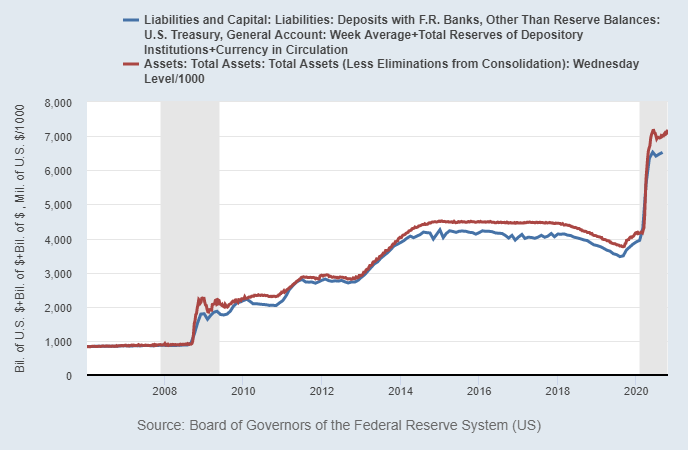
Chart Source: St. Louis Fed
Bank cash reserves at the Fed are fungible with each other. As folks like you and I use various payment systems to transact with each other, our banks use reserves to settle with each other behind the scenes.
Bank reserves are also fungible to some extent with currency in circulation. In fact, that’s one of the initial reasons for banks to have reserves in the first place: in case tons of people want to withdraw money at once. In theory, if we all wanted to go and take out some of our bank cash at once, it would come from bank reserves. However, in practice, the amount of minted physical currency is limited (mostly on purpose), so if there was a bank run, consumers would quickly find themselves limited in how much cash they would physically be allowed to withdraw, as the bank runs out of vault cash. But basically, physical currency and bank reserves are fungible.
Bank reserves are fungible with the Treasury general account as well. When the Treasury issues a lot of bonds and pulls capital into its account, it sucks it out of bank reserves. When it eventually spends down its account, those funds wind up back in bank reserves.
Broad money
The broad money supply, on the other hand, is currently $18.8 trillion, which is far larger than the base money amount. This broad money calculation consists of currency in circulation, but then also includes the massive amounts of checking deposits, savings deposits, and various functional cash-equivalents that consumers and businesses hold at commercial banks. This is the broader set of money that we consumers actually use to transact with each other and store our capital and define as our “money”.
The blue line below shows the broad money supply. The red line shows commercial bank deposits, and the green line shows physical currency in circulation. The red line and green line added together roughly equal the blue line.
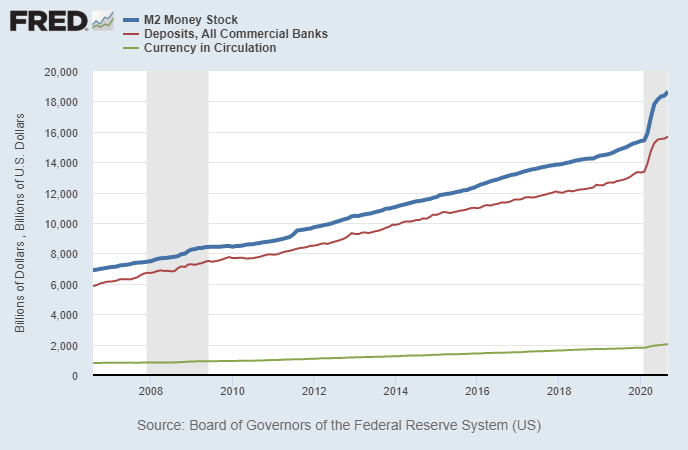
Chart Source: St. Louis Fed
When the Fed does QE alone, it increases bank reserves in the system, but doesn’t necessarily increase the broad money supply. The broad money supply only increases when either a) banks create more money by making loans or b) the federal government runs big fiscal deficits to inject money to people and businesses in the system. Many people miss that second one; they assume that money supply can only increase if banks lend, which isn’t correct.
Conservation of Reserves + Currency + TGA (Base Money)
For the most part, only the Fed can determine the sum of commercial bank reserves + currency in circulation + the Treasury’s general account, hereby referred to as “base money”.
Think of these three forms of base money as buckets of water. The total amount of water can move around between the three buckets if we pour one into another, but is conserved within the total three-bucket system. Only the Fed can increase or decrease the total amount of water in the total three-bucket system.
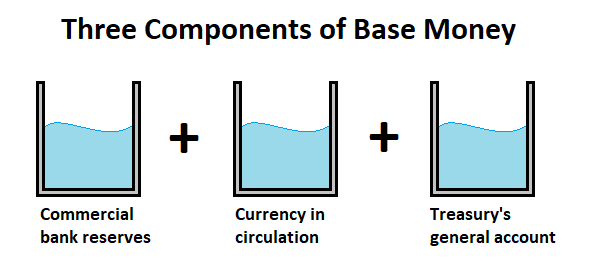
The purpose of modern banks is to “multiply” base money into broad money, and make a profit along the way. We can call this the “money multiplier”, defined as the broad money supply divided by the base money supply.
When a bank makes a loan to someone, it becomes another bank’s deposit, and the loaning bank sends the reserve amount to the depositing bank, and increases the total amount of commercial bank deposits and broad money in the system. So, when they “loan reserves”, banks collectively don’t actually reduce total bank reserves in the banking system; they just lever those reserves up with a higher money multiplier, and change the location/ownership of those reserves.
Any individual bank can leverage itself (up to a limiting point where it still meets capital and reserve requirements) by lending money or buying securities, and thus reducing its excess cash reserves at the Fed. However, when they make these loans or buy those assets, they create deposits somewhere else in the financial system, and those deposits become reserves of other banks. Similarly, a bank could sell assets and increases its cash reserves, but in doing so, some other bank deposits would be drained to buy those assets, which would reduce reserves somewhere else in the system.
Therefore, the banking system as a whole can’t decide to collectively increase or decrease the system-wide amount of bank reserves, even though any individual bank can alter its own level of reserves. They can collectively increase the money multiplier (the broad money supply divided by base money) by making more loans or buying more securities, but they can’t change the total system-wide bank reserves. They can just move them around, and leverage them up, or deleverage them.
Similarly, the U.S. Treasury can determine the size of its general account at the Fed. To increase it, they can issue Treasuries, bring in a lot of cash, and then hold the cash in that account at the Fed for a while before spending it. This sucks bank reserves out of the system, on a 1:1 basis with the general account increase. When they eventually reduce the general account by spending more than they take in, that money goes into peoples’ and companies’ bank accounts and thus winds up back in bank reserves.
The public can theoretically pull money out of excess bank reserves into physical currency, or deposit physical currency into banks which would wind up as more reserves, like water flowing back and forth between those two buckets of base money. In practice, however, physical currency is limited on purpose, so if the public collectively tries to pull bank reserves out into physical currency, they get told by the bank teller that they can’t, because there’s a nationwide shortage of physical currency.
The Fed, however, can create new base money, and thus add more total water to the three-bucket system analogy, by performing quantitative easing or “QE”. To do this, they create new bank reserves out of thin air, and then buy existing assets, like Treasuries or mortgage-backed securities with those new reserves. After this asset swap, the reserves become owned by a commercial bank (and thus become the Fed’s liabilities), and the securities become owned by the Fed (and thus become the Fed’s assets). In this process, the Fed increases their total assets (the securities they are buying) and increases their liabilities (the new reserves they are creating) by the same amount.
The Fed can also decrease base money, or destroy water in the three-bucket system analogy, by performing quantitative tightening “QT”. To do this, they sell or let some of their Treasuries or mortgage-backed securities mature and get their principle back. They then retire that cash. In this process, both the Fed’s assets and liabilities decrease.
In a vacuum, neither QE nor QT alone directly affects the broad money supply; it just affects the base money amount.
However, if the federal government is running very large fiscal deficits and the Fed is creating new bank reserves to buy the Treasury issuance to fund those deficits, it directly creates new broad money (and thus goes around the bank lending channel).
On the other hand, if the federal government were to run big fiscal surpluses on a sustained basis (i.e. tax more than they spend by a lot), at a time when banks aren’t lending much either, they can theoretically decrease the total amount of broad money. This would be very rare, if ever, to occur. Additionally, widespread bank collapses without any bailout or FDIC insurance can also theoretically reduce broad money, which happened in the early 1930’s.
Bank Reserve Accounting Examples
This section gets gritty. I’ll work through six examples of bank lending, QE, and fiscal deficits, to help show which types of actions by banks, the Fed, and the government, can influence the amount and location of bank reserves and broad money supply in the system.
| For each example, I have two people, Mary and Sara, the two banks they do business with, the Fed, and the U.S. Treasury. Each of these six entities has a column that represent each of their assets and liabilities “A | L”. |
Each example is a small closed-loop financial system. Each block in an entity’s asset or liability column represents $1,000 of value.
- “D” represents a $1,000 customer bank deposit.
- “R” represents a $1,000 cash reserve allocation that a bank has at the Fed.
- “T” represents a $1,000 U.S. Treasury note; U.S. federal government debt.
- Other assets, like a $1,000 used car “C” or a $1,000 car loan “L” are sometimes used as well.
A deposit block “D” is an asset for a consumer, and is simultaneously a liability for their commercial bank, since the bank holds it on behalf of the consumer and owes it to them on demand.
Similarly, a reserve block “R” is an asset for a commercial bank, and they keep it at the Fed. The Fed lists it as a liability, owed to the bank who deposited it with them.
Likewise, a Treasury note “T” is an asset for whoever holds it, whether a consumer, or a commercial bank, or the Fed, and is a liability of the U.S. Treasury.
A bank loan block “L” or mortgage block “M” is an asset for the bank that lent it, and is a liability for the consumer who borrowed it from their bank.
Example 1) A Bank Loans Money
This is the simplest example to show how banks create deposits and broad money without reducing the amount of reserves in the system. It involves Mary buying a used car from Sara.
Here is the visual, with a beginning, intermediate, and ending state, and a description afterward, so you can go back and forth between the visual and the description:
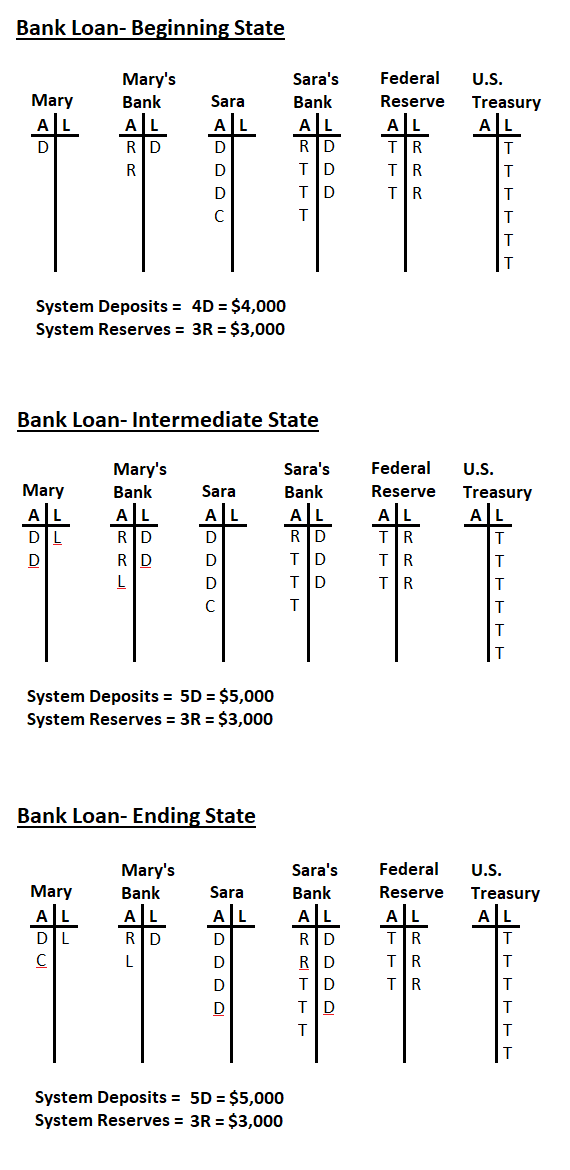
Beginning State
Mary begins with “D” in assets, meaning a $1,000 deposit in her bank, and no liabilities. Her bank (which is very unlevered) starts with her deposit “D” as a $1,000 liability, and then has two reserve block assets “R”, representing $2,000 held at the Fed.
Sara begins with “DDDC” in assets, meaning $3,000 in bank deposits at her bank “DDD”, and a $1,000 used car “C”, and no liabilities. Her bank starts with her deposit “DDD” as liabilities, and has its assets primarily invested in Treasuries “TTT” and one reserve block at the Fed “R”.
The Federal Reserve holds the three blocks of reserves from the two banks as its liabilities, and has three blocks of Treasuries as its assets. The banks use the Federal Reserve as their bank, in a similar way that Mary and Sara use their banks. In other words, the two banks store their extra cash reserve assets in their accounts at the Fed, which are the Fed’s liabilities.
The U.S. Treasury Department, representing the financial arm of the overall U.S. Federal Government, has 6 blocks of Treasuries outstanding as its liabilities. For the sake of simplicity it doesn’t have any assets listed, but in reality, its assets would consist of working capital, various federal buildings and lands and military assets, and its ability to tax citizens. Its 6 Treasury liabilities are owned by the Fed and Sara’s bank.
Between Mary and Sara’s cash, there are 4 deposit “D” blocks in the total system, which are assets for them and liabilities for their banks. Likewise, there are 3 reserve “R” blocks in the system, which are assets for their banks and liabilities for the Fed.
Intermediate State
Now, for the intermediate state, Mary and Sara enter into negotiations, and Sara agrees to sell her car to Mary for $1,000. Mary, however, only has $1,000 in deposits, and although she needs the car, she doesn’t want to be completely cash-less. So, she goes to her bank, and takes out a $1,000 car loan “L”. Mary’s bank creates a $1,000 deposit “D” for Mary, and creates a $1,000 loan liability “L” for her as well. For the bank itself, Mary’s new deposit asset is its new liability, and Mary’s new loan liability is its new asset. No reserves moved, but a new deposit was created.
Mary’s net worth is unchanged at $1,000 in total, but she now has $2,000 in deposits and $1,000 in loan liabilities ,and thus is a bit more leveraged. Mary’s bank’s net worth is unchanged as well, but it also leveraged itself up a bit, by creating a new asset and a new liability, since it expects that Mary will be able to pay the loan back with interest.
Neither the Fed nor the U.S. Treasury are involved yet.
There are now 5 deposit “D” blocks in the system rather than 4, because Mary’s bank is more levered with an additional asset and liability. It created new broad money by loaning a new deposit into existence. However, there are still 3 reserve “R” blocks in the system.
Ending State
For the ending state, Mary writes Sara a $1,000 check for the car, and therefore gives her the new deposit “D” that she just received from her bank loan. Sara receives the check and deposits it in her bank account, and her bank credits this by giving her an extra $1,000 deposit asset “D”, which becomes a new liability for her bank. Behind the scenes, Mary’s bank sends a $1,000 reserve block “R” to Sara’s bank to honor the check. So, Sara’s bank now has a new liability “D” in the form of Sara’s new deposit, but also has a new reserve block “R” as its new asset. Sara’s bank doesn’t have any creditworthy clients asking for loans at the moment, so it keeps its new reserve block at its Fed account for now.
The Fed’s ending state is unchanged on net, except that it updated its book-keeping for its two client banks when Mary’s bank sent Sara’s bank a $1,000 reserve block “R”. The Fed used to attribute “RR” to Mary’s bank and “R” to Sara’s bank, but now it attributes “R” to Mary’s bank and “RR” to Sara’s bank. These reserve blocks are liabilities for the Fed, but assets for its client banks.
The U.S. Treasury’s ending state is also unchanged, and unlike the Fed, it wasn’t even aware of the transaction at all.
In the final ending state, just like the intermediate state, there are still three reserve blocks “R” in the system, and there are 5 deposit blocks “D”, which is one extra deposit block compared to the beginning state, created by Mary’s bank loan.
The point of this example is to show how, when a bank uses its reserves to lend money, the reserves aren’t destroyed. The money shows up in another bank, and the reserve amount is sent there. The overall amount of reserves or base money in the system is unchanged, but the system becomes slightly more levered, and has more consumer deposits and therefore more broad money. In other words, the money multiplier ratio (D-to-R, broad money to base money) increased from 4-to-3 to 5-to-3.
Any bank can increase or decrease its own amount of reserves by buying or selling assets, or making loans. However, those reserves get moved around to or from other banks rather than created or destroyed. Banks can, however, create or reduce the amount of deposits leveraged on those reserves, depending on how much risk it wants to take on and how many creditworthy opportunities it has to lend money for.
Example 2) The Fed Performs QE from Banks
This next example is a bit more realistic, with a more levered banking system. It involves the Fed performing quantitative easing on the banking system, meaning it creates new reserves to buy existing assets from the banks.
I’ll just show the beginning and end state here, and skip over the intermediate state:
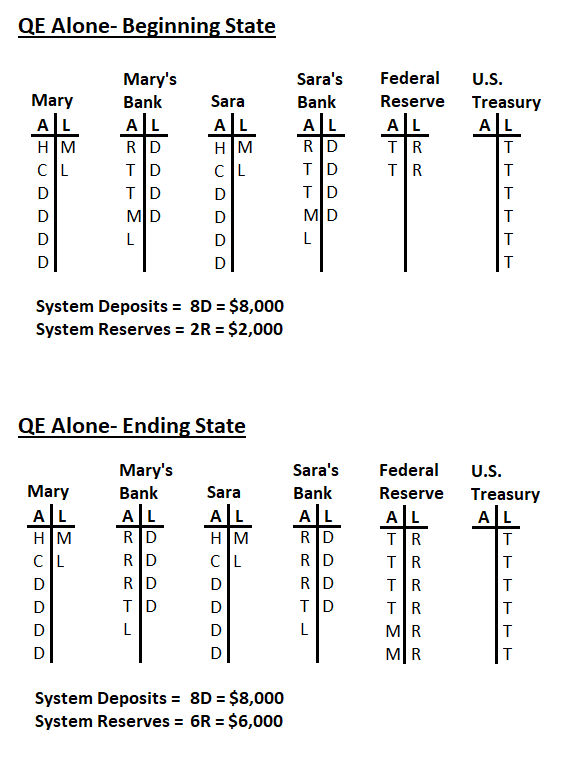
Beginning State
Sara and Mary are identical to each other in this example. For assets, they each have a House “H”, a car “C”, and $4,000 in cash deposits “DDDD” at their banks. For liabilities, they also have a car loan “L” and a mortgage loan “M” owed to their respective banks.
The banks are also identical to each other in this example. They each have their $4,000 customer deposits “DDDD” as liabilities owed to Mary and Sara respectively. For assets, they each have “RTTML”, meaning one reserve block, two Treasury blocks, one mortgage loan block, and one car loan block. The banks are rather highly levered, with lots of assets and liabilities relative to their sole reserve block.
The Fed is small, with just “RR” in liabilities for their member bank reserve accounts, one for each, and “TT” in assets.
The U.S. Treasury has “TTTTTT” in liabilities, which are owned by the banks and the Fed.
There are 8 deposit blocks “D” in the system, and 2 reserve blocks “R”. So, the system money multiplier is levered 8-to-2, aka 4-to-1.
Ending State
In this example, the Federal Reserve realizes that both Mary’s bank and Sara’s bank have just one reserve block each. Assuming the banks are each required by regulations to have at least one reserve block, this means they can’t really lend any more, and can’t create more broad money. The Fed wants banks to be able to lend. So, the Fed decides to recapitalize the banking system by giving them plenty of excess reserve blocks. It can’t, however, legally just give free money to banks; it has to take something in return.
The Fed creates four new reserve blocks out of thin air, and gives two to Mary’s bank and two to Sara’s bank. These new reserve blocks become liabilities of the Fed, and become assets for the banks. In return, the Fed takes one mortgage block and one Treasury block from each bank. The Fed therefore adds “TTMM” to its assets and “RRRR” to its liabilities.
The banks are now much-better capitalized, with plenty of excess reserves as assets, and fewer Treasuries and mortgages. If they want to loan money or buy more securities, they now have plenty of excess reserves to do so with. However, they haven’t lent any more money yet, so the amount of deposits or broad money in the system remains unchanged. Underneath the surface, the banks are just less-leveraged, with plenty of reserves relative to deposit liabilities and overall assets.
Mary and Sara didn’t notice anything from beginning to end in this example. They have the same assets and liabilities that they started with. They weren’t even aware this happened.
The Fed is more leveraged now, with more assets and liabilities than it started with.
The U.S. Treasury didn’t change on net, except that it now attributes ownership of 2 of its Treasury note liabilities to the Fed instead of to the private banks, since the banks each sold a Treasury note “T” to the Fed.
There are still 8 deposit blocks “D” in the system, but the number of reserve blocks “R” increased from 2 to 6. So, the money multiplier in the system is now 8-to-6, aka 1.33-to-1. The amount of broad money hasn’t changed, but the amount of base money grew, due to the Fed’s decision to buy bank assets with new reserves. The banking system has been recapitalized, and has a lot more lending power now.
This is why, although many people think QE by itself is inflationary on consumer prices, it generally isn’t. The money isn’t getting out to consumers like Mary and Sara yet; it’s just internal to the banking system. This QE process sets the long-term stage for inflation as an early foundation, by recapitalizing banks and therefore being “anti-deflationary” by preventing a bank collapse and ensuring they have plenty of lending capacity, but it’s not inflationary yet.
Inflation would come if Mary and Sara have a lot more deposit money chasing the same amount of goods and services, but neither Mary nor Sara have more deposit money than they started with, and there’s no reason for anything to be inflationary. The amount of consumer deposits in the system hasn’t changed.
Example 3) The Fed Performs QE from Non-Banks
This third example starts with a simpler system again, very similar to Example 1. However, instead of having a car as an extra asset that she had in the first example, Sara has a Treasury note.
Sara decides to sell her Treasury note, but there aren’t many buyers for it at the moment. So, the Federal Reserve steps in and performs QE to buy it from her. The result ends up slightly differently compared to the Fed buying a Treasury note from the banking system.
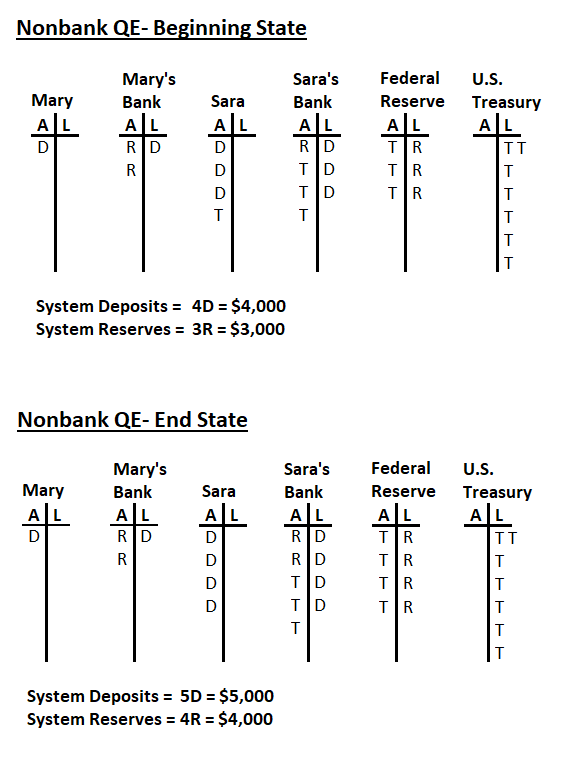
Beginning State
Everything begins similarly to Example 1, except Sara has a Treasury note instead of a car. There are 4 “D” deposits in the total system, and 3 “R” reserves to start.
Sara decides to sell her Treasury note, but neither Mary nor either bank particularly want to buy it.
So, the Fed decides to buy it. The Fed creates a new bank reserve “R” out of thin air and gives it to Sara’s bank, and tells the bank to buy Sara’s Treasury note with a new deposit, and then to give the Fed the Treasury “T”.
The Fed, therefore, bought Sara’s Treasury note with a brand new reserve block, using the bank as the intermediary (so Sara and the Fed never talked to each other; Sara sold the Treasury note to her bank for a deposit block “D”, and her bank sold that Treasury note to the Fed, who bought it with a new reserve block “R”).
Ending State
After the bank completes this task, Sara has the same net worth as she started the example with, but replaced her Treasury “T” with an extra deposit “D”. Her bank also has the same net worth as it started the example with, but grew a bit bigger, with an extra reserve block asset “R” and an extra deposit block liability to Sara “D”.
The Fed grew a bit more leveraged as well, with an additional Treasury asset “T” and an additional reserve liability “R”, which it lists as an asset of Sara’s bank.
The U.S. Treasury didn’t change on net, except that it now recognizes Sara’s initial Treasury “T” as owned by the Fed instead of Sara now, since the Fed bought it.
Whether this is stimulatory for the economy or not depends on what Sara wants to do with her extra cash. She had “DDDT” and now she has “DDDD” as her assets. It’s still $4,000 but it’s a bit more liquid now. If the reason for her selling the Treasury was to raise more cash to do something big, like start a business or lend money to her friend to start a business, then it might be simulative. However, if she merely holds the money in an extra “D” deposit rather than the Treasury “T”, then she’s not using the money any differently. It then becomes a question of what her bank does.
Sara’s bank now has an extra reserve asset block and an extra deposit block liability compared to the beginning state, meaning it’s a bit bigger and has more lending power. It could finance a corporate loan, or a consumer loan, which would be stimulative. Or, if it thinks the economy is too risky, or if none of its creditworthy corporate or consumer clients are asking for a loan, it might just sit on its safe “RRTTT” assets and do nothing. In that case, this example wouldn’t be stimulative.
There are now 5 “D” deposits in the system compared to the beginning state that only had 4. In addition, there are 4 “R” reserve blocks in the system compared to the beginning state that only had 3.
So, there’s more liquidity in the system, with an increase in both base money and broad money. However, none of that broad money moved yet, and is just sitting there with Sara and her bank. Broad money velocity is low, in other words. There is more inflationary potential in the system, due to there being more broad money and reserves, but no consumer price inflation yet. Sara isn’t any richer; just slightly more liquid.
In this example, the Fed directly increased the amount of broad money in the system without banks doing any private lending, and without the federal government doing any spending, but it remains unclear if it will be impactful or not (subject to what Sara and/or her bank do with their extra liquidity). And even if it was impactful, the Fed wouldn’t be able to repeat it a second time, because neither Mary nor Sara (the two private non-bank entities) have any more Treasury notes to sell to the Fed.
If anything, it’s likely to be somewhat inflationary on asset prices, because Sara is flush with cash, and perhaps more willing to buy stocks, or buy more Treasuries, etc. She’s a saver and this might not make her spend more, but it might shift how she invests, with her extra liquidity.
Example 4) Nonbank-Financed Helicopter Money
The first three example were separate cases, each meant to illustrate a different scenario.
These final three examples, Example 4, Example 5, and Example 6, however, build on top of it each other to show what happens when the U.S. Treasury gets involved with deficit spending, with differences depending on who finances that spending by buying the Treasury debt.
Example 4 begins with a relatively unlevered system. However, the economy is in a recession, and Mary just lost her job and only has a little bit of money in her bank account and is making her frustration known, so Congress authorizes the U.S. Treasury to send everyone $1,000 in stimulus checks, right to their bank accounts. This is known in economics as “helicopter money”, referring to a thought experiment of dropping money out of helicopters on consumers. The Treasury finances this by issuing Treasury bonds, which Sara, who has plenty of money and hasn’t lost her job, buys.
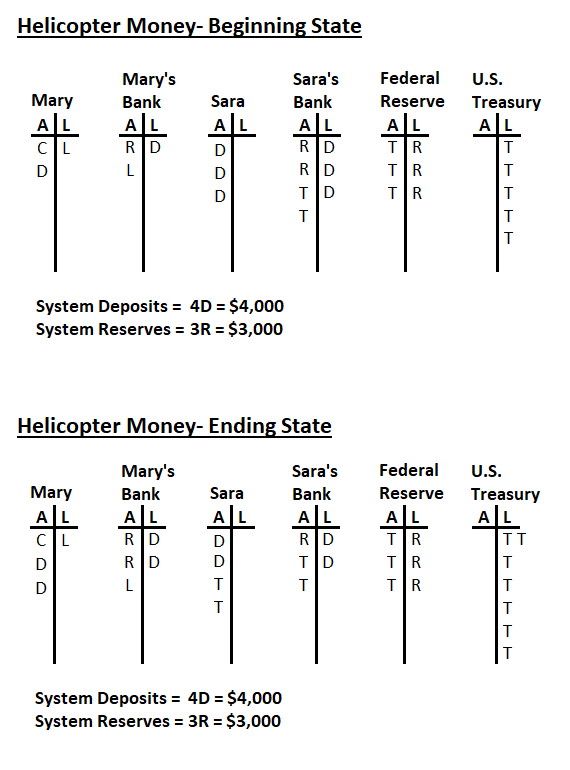
Beginning State
Mary has a car “C” and a deposit “D” as assets, and a car loan “L” as a liability. Mary’s bank has a reserve block “R” and Mary’s car loan “L” as assets, and has Mary’s deposit “D” as its liability.
Sara has three blocks of deposits “DDD” as her assets, and no liabilities. Sara’s bank has a blend of excess reserves and some Treasuries as assets “RRTT”, and has Sara’s three deposit blocks “DDD” as its liabilities.
The Fed holds the banks’ 3 total system reserve blocks as its liabilities, and holds 3 Treasuries as its assets.
The U.S. Treasury has 5 Treasury notes outstanding as liabilities, which are owned by the Fed and Sara’s bank.
Total system deposits are 4D = $4,000, and total system reserves are 3R = $3,000.
Intermediate State (not shown)
Although it is the originator of currency, the U.S. Federal Government legally has to finance its spending by receiving taxes or issuing Treasury debt to settle its account.
So, the U.S. Treasury sends a $1,000 deposit “D” block each to both Mary and Sara, deposited in their bank accounts. Both Mary and Sara are happy, because their net worth goes up by $1,000 each. Their banks get money deposited into them, and haven’t loaned any out yet, so they just keep this new cash at their Fed account as new reserves.
However, this is just a brief intermediate state. The Treasury now issues new Treasury note liabilities “TT” to pay for the expenditures it just made. Sara then decides to use two of her deposit blocks “DD” to buy those two Treasury securities “TT”, since they are yielding slightly higher rates than her bank deposit account yields.
If we imagine it happening simultaneously, what happened is that the U.S. Treasury extracted two deposit blocks from Sara (and therefore extracted two reserve blocks from Sara’s bank, as Sara’s bank settled the transfer with the U.S. Treasury), and the U.S. Treasury gave Sara two Treasury note blocks as assets in return. At the same time, the U.S. Treasury gave both Mary and Sara one deposit block each, and therefore gives one reserve block to Mary’s bank, and one reserve block to Sara’s bank, to settle the transfers.
Ending State
By the end of the transfers, both Mary and Sara are $1,000 richer than they started. Mary’s assets simply went from “CD” to “CDD” as she gained a deposit block. Sara’s assets went from “DDD” to “DDTT”, because she gained a deposit block but used two deposit blocks to buy two Treasury notes.
Mary’s bank is slightly bigger than it began, because Mary received a deposit block “D” and her bank was credited with a reserve block “R” to settle it (but also owes an extra liability “D” owed to Mary), and Mary hasn’t spent it yet. So, Mary’s bank has the same net worth (both its assets and liabilities increased by the same amount), but it’s overall combined assets and liabilities are bigger, and it has more lending power now because of that.
Sara’s bank is slightly smaller than it began, because although Sara and her bank received a deposit and reserve block respectively, Sara sent two deposit blocks to the Treasury to receive the Treasury notes, and therefore Sara’s bank sent two reserve blocks to the Treasury, which were then given back out, one to Mary’s bank and one back to Sara’s bank. Sara’s bank has the same net worth, but is simply smaller, as both assets and liabilities decreased, and its lending power is decreased.
The Fed is unchanged, except that it updated its book-keeping to attribute one of the reserve blocks “R” originally attributed to Sara’s bank, to being attributed to Mary’s bank instead. Its overall amount of Treasury note assets and reserve liabilities remains unchanged.
The U.S. Treasury is more leveraged, with an extra “TT” in debt liabilities outstanding, owed to Sara.
Total system deposits are 4D = $4,000, and total system reserves are 3R = $3,000, meaning that neither the total amount of deposits or reserves changed in the system from the beginning state to the end state. Deposits and reserves were just moved around a bit within the system.
Example 5) Fed-Financed Helicopter Money
Example 5 starts exactly where Example 4 left off, and builds from there.
Both Mary and Sara are happy because they got some extra money in the previous example. However, Sara is just prudently saving her money due to uncertainty about the economy, and Mary still doesn’t have a job so she is also just saving her money, and their favorite restaurants and vacation spots are closed due a virus pandemic anyway.
Some politicians want to give $1,000 to everyone every month for the next year, due to so many displaced workers like Mary having so little money and with no jobs. Other politicians say, “no, that’s too much federal debt, let the economy try to heal itself.” The politicians argue for a couple months and then eventually compromise and decide to send everyone $1,000 one more time, to see if that helps. So, Congress authorizes the U.S. Treasury to send out another $1,000 to everyone.
This time, instead of Sara buying the new Treasury liabilities with her existing deposits, the Fed buys the new Treasury liabilities with new reserves.
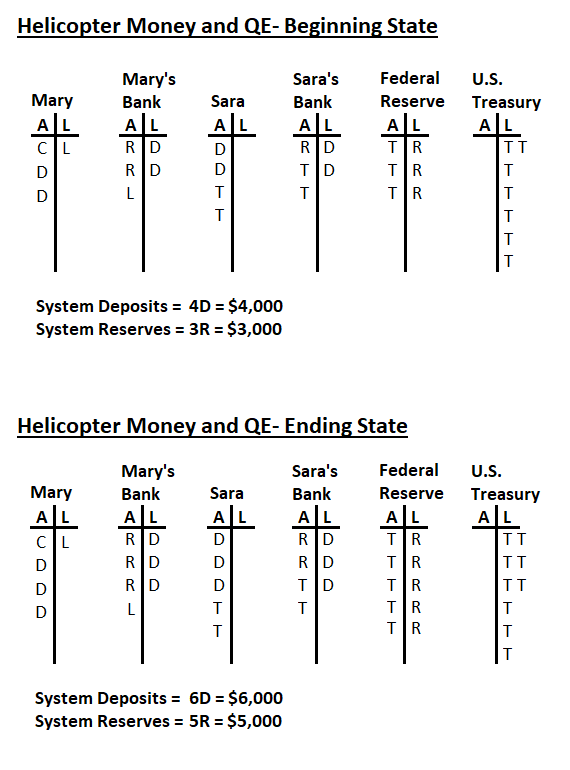
Beginning State
Sara already owns a lot of Treasury notes and sees that the U.S. Treasury will become even more indebted after it sends out all this money without raising taxes, so she doesn’t want to buy any more Treasury notes. So, how will the U.S. Treasury finance this second round of helicopter money?
Well, because there is a lot of new Treasury note issuance but nobody desiring to buy it at current prices, the Treasury note market suddenly becomes illiquid, and prices start to fall (meaning yields start to rise). Sara and her bank both get nervous, because they own a lot of Treasury notes.
The Treasury note market briefly looks like it did in March 2020: totally illiquid, with yields extremely volatile.
However, this problem doesn’t last long, because the Fed says, “It’s fine everyone! We’ll buy the extra Treasury note issuance. Relax.”
So, the Fed creates two new bank reserve blocks “RR”, and gives them to the Treasury in exchange for the new Treasury debt liabilities, “TT”, which become the Fed’s assets. Technically, the Fed can’t legally buy directly from the Treasury, so they agree to transfer the securities through one of the banks as a brief pass-through entity.
The U.S. Treasury then sends a $1,000 deposit “D” each to Mary and Sara, and settles this by sending a reserve block “R” to each of Mary’s and Sara’s banks.
Ending State
Mary and Sara are both $1,000 richer, again. They each have a new $1,000 deposit “D”.
Mary and Sara’s banks are both bigger, although their net worth didn’t change. They each have an extra $1,000 reserve block “R”, but also each have a new $1,000 liability block to their customer deposits “D”.
The Fed is bigger and more levered, with $2,000 more assets in the form of Treasuries “TT”, and $2,000 more liabilities in the form of reserves “RR” that they hold for the banks.
The U.S. Treasury is bigger and more levered, with $2,000 “TT” in more debt liabilities outstanding.
System-wide deposits (broad money) increased over the beginning state, from 4D = $4,000 to 6D = $6,000. System-wide reserves (base money) also increased over the beginning state, from 3R = $3,000 to 5R = $5,000.
This was outright money-printing. The amount of broad money and base money in the system went up by a lot. Mary and Sara are richer, and their banks are bigger. Money was injected into the system, without being extracted anywhere from the system, because the deficit spending was financed by the Fed creating new bank reserves to buy the Treasury notes.
The Treasury and Fed can perform this repeatedly if they want, any number of times, although they both know that if they do it too much, it could cause consumer price inflation.
Whether it is inflationary for consumer prices or not, however, depends on whether Mary and Sara still have confidence in the value of their deposits, and whether they go and spend them or not. It’s also potentially inflationary for asset prices; Sara in particular is flush with assets and more likely to put some money to work in stocks other gold or other assets than she was before.
Example 6) Bank-Financed Helicopter Money
Example 6 starts exactly where Example 5 left off. Both Mary and Sara are happy because they got some extra money in the previous example, again.
The pandemic eased a bit, and Mary got a new job, but realizes she needs to keep more cash on hand in case she loses her job again in the future. She learned a lesson about saving, in other words.
Sara was already a saver, and hasn’t been spending extra money yet either. Sara, however, is considering going on a vacation or buying a car, now that she’s feeling a bit more confident with so much cash. She’s also not sure about the value of her money, as she watches the broad money supply expanding so rapidly due to these helicopter checks that everyone is receiving. Car prices are starting to go up, probably due to so many people receiving stimulus checks, so there seems little reason to wait.
However, because the economy is still sluggish, with many people saving more than they used to, Congress decides to do yet another round of $1,000 helicopter checks to everyone, and issue $2,000 in new Treasury note liabilities “TT” to pay for it. This is it, the final stimulus round!
Fortunately for the U.S. Treasury, the banking system has tons of excess reserves due to their previous round of helicopter spending that the Fed bought with new reserves, and so this time, the banks each agree to buy one Treasury note “T” with one of their excess reserve blocks. (In fact, the banks don’t have much of a choice, because as primary dealers they “have” to buy Treasury notes at auction if they have enough liquidity to do so, and if neither Mary nor Sara nor the Fed agree to buy the Treasury notes from them, they get stuck holding the Treasury notes.)
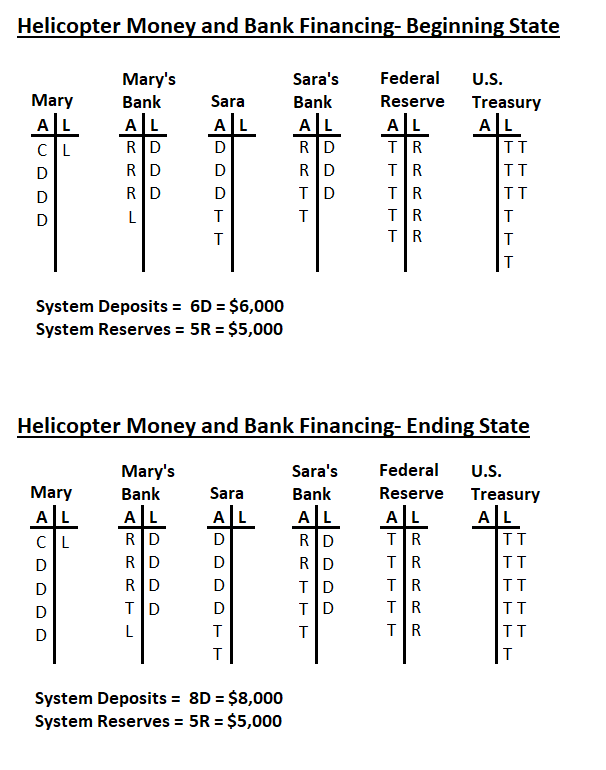
Beginning State
System-wide deposits are 6D = $6,000. System-wide reserves are 5R = $5,000.
Here’s what happens if we imagine the process happening simultaneously. The U.S. Treasury sends Mary and Sara each a $1,000 deposit “D” block, and sends their banks each a $1,000 reserve “R” block to settle it. The U.S. Treasury then issues two new Treasury note liabilities “TT” to pay for it. The banks each send a reserve block “R” to the U.S. Treasury in exchange for one of those Treasury notes “T”.
Ending State
Mary and Sara are, yet again, $1,000 richer. They each have yet another deposit block “D” added to their assets.
Their banks have the same amount of reserves they started with, because they each received a reserve block “R” from the U.S. Treasury’s helicopter deposits to their customers, but since each bank also sent a reserve block “R” back to the U.S. Treasury to pay for the stimulus, they each ultimately received a Treasury note “T” as an asset instead. They still have the same amount of reserve blocks that they started with, but they each have an extra asset “T”, and they each have an extra deposit liability “D” for their customers. So, they are a bit more levered overall.
The Fed didn’t change at all from the beginning of this example, although it did some book-keeping for the reserves moving around and ending back in the same place.
The U.S. Treasury is $2,000 or “TT” more in debt than it started the example with.
System-wide deposits increased by $2,000 or “DD” from 6D = $6,000 to 8D = $8,000. System-wide reserves are still 5R = $5,000. So, the money multiplier increased a bit, from 6-to-5 to 8-to-5. Broad money increased, but base money remained the same.
Will it be inflationary? It depends on what Mary and Sara do from here, but most likely at this point, yes. Sara now has tons of cash and is concerned about the value of that cash, so she decides to spend money on a vacation and buy that new car, or buy stocks or gold or real estate, or something. Even Mary decides to eat out at restaurants more, now that she has more cash than usual. Other people seem to be doing the same; prices of things are inching up each month.
There is now $8,000 in total deposits (broad money) in the system, compared to the start of Example 4 where there was only $4,000 in deposits. However, the amount of goods and service in the economy have not doubled. So, if Mary and Sara and others decide to start spending their money, it could indeed result in a lot of money chasing a limited supply of goods and services, and therefore could push up consumer prices and be inflationary.
In response to high inflation, the Fed’s normal tool would be to raise interest rates. However, with U.S. Treasury debt so high at that point, the Fed’s ability to raise interest rates would be limited, since it would result in an acute fiscal crisis as rising Treasury debt interest eats up a large part of the fiscal budget. So, either the Fed would have to let inflation run hot and inflate away part of the debt and keep creating Reserve blocks to buy new Treasury notes as needed to keep Treasury security yields low (which they did back in the 1940’s), or the U.S. Treasury would have to restructure/default on the central bank portion of U.S. Treasury debt.
So, the Treasury+Fed combo has all the power to boost the broad money supply enough to cause a rising trend shift in inflation, but when they do with such a highly-leveraged U.S. Treasury, they face some consequences in their ability to constrain it.
Example Summaries and Findings
If we analyze all of the examples, we see a few observations:
-Banks can create new deposits and increase the the amount of deposits (broad money) in the system by lending. Lending creates deposits. This lending doesn’t change the amount of base money (reserves) in the system, but it moves those reserves around from one bank to another, and levers those reserves up. This is the money multiplier ratio, the ratio of broad money to reserves in these simplified examples. Although the banks can create new deposits and increase broad money by lending, it is not “money printing” because the banks are simply making decisions regarding how much to lever themselves up relative to their cash reserve assets, and they are constrained by various regulatory standards for how much leverage they can have.
-The Fed alone has the power to create new bank reserves, and to therefore increase the amount of bank reserves in the system (base money) or more broadly, the total amount of water in the three-bucket system analogy. However, if it buys assets from banks, it doesn’t directly lead to more deposits (broad money) being in the system. It de-levers banks and gives them more capacity to lend and create new deposits (broad money), but whether they will or not is up to them. On the other hand, if it buys assets from non-bank entities like Sara (using the banking system as its intermediary), it can slightly increase deposits (broad money) in the system, but only to a limited extent, based on limited amounts of non-bank entities holdings’ of Treasuries that they can sell. It is, in this sense, very limited “money printing”.
-On behalf of Congress, the U.S. Treasury can give more deposits to somewhere in the system, but deposits also get extracted back out of the system when non-bank entities like Sara buy the Treasuries that are used to fund this expenditure. So, it doesn’t necessarily create new deposits or new reserves. This is what deflationists often refer to as the “crowding out effect”, meaning that the U.S. Treasury can extract capital from somewhere in the economy and inject it somewhere else in the economy, if it runs large deficits and builds up federal debt, and it displaces nonbank capital that could have been used for something else. This is not “money printing” since it just moves things around and levers up the Treasury.
-However, if the Treasury and Fed work together, they can rapidly increase both the deposits (broad money), and bank reserves in the system (base money), without extracting deposits from anywhere in the system. In this process, the Treasury injects money into the economy by spending, which creates new deposits, but instead of that money being extracted from deposits somewhere else in the economy, the Fed finances those new Treasuries with newly-created bank reserves out of thin air, and thus levers itself with additional assets (the new Treasuries) and additional liabilities (the new reserves attributed to the banking system). It doesn’t matter if banks lend or not; the Treasury+Fed combo goes around the bank lending channel by just giving people and businesses more deposits (broad money). This outright increases the net worth of Mary and Sara in the examples, and increases the size of their banks including broad money supply and bank reserves (but the banks’ net worth remains unchanged), and levers up both the Fed and the U.S. Treasury. There is no limit to the amount they can do this, other than the fact that it would eventually be inflationary if done too much and too rapidly relative to the amount of goods and services and productive capacity in the economy. This is outright “money printing”, although there are some checks and balances since fiscal changes have to be passed by Congress and signed into law, rather than done unilaterally by the Fed.
-Additionally, if the U.S. Treasury injects money into the economy with large deficits and the Treasuries to finance it are bought by a well-capitalized banking system (usually as a result of the Fed already having capitalized banks by creating excess reserves in the recent past), it also increases the deposits (broad money) and levers up the money multiplier. This can be done quite a bit if banks start with excess reserves, because every time the federal government injects more money into the system, it creates more bank deposits, which replenishes the reserves that the bank spent buying Treasuries, and thus gives the banks more ability to buy additional Treasuries. This is mostly “money printing”, although to maintain leverage ratios, the banks need to start with plenty of excess reserves.
-If there is a lot of broad money added to the system, with both Mary and Sara confident to spend, it could very well be inflationary. Plus, now that Mary and Sara are richer than they started, they might feel more confident to take out a mortgage loan or business loan from their bank to buy a house or start a business, and their banks are more willing to lend it now because Mary and Sara both have plenty of net worth and creditworthiness. This could very well be inflationary.
-There are proposals for central bank digital currencies, which if enacted may allow the Fed to inject money to consumer deposits without going through Congress. This would likely require an overhaul of the Federal Reserve Act, and would substantially change the nature of the system. Some folks argue that this would be necessary for inflation to happen, but inflation can already happen within the existing framework through the combination of fiscal deficits and QE monetization of those deficits. The current framework requires Congress to go along with it rather than performed unilaterally by the Fed, and thus has checks and balances in the system.
Implications: Focus on Broad Money
It’s fashionable to debate lately whether QE is inflationary or not, and whether central banks have run amok.
However, for more fruitful results as it relates to analyzing inflation vs deflation and the associated impacts on various asset classes, investors should focus on fiscal spending, especially when it is combined with monetary financing to pay for it. Are major fiscal deficits happening or no? How big are the deficits, relative to the deflationary backdrop? Who are the deficits targeting? Who is financing the deficits by accumulating the Treasury securities?
And then specifically, look at what the broad money supply is doing. Is it going up, or no? At what rate?
Banks are already well-capitalized. The big non-fiscal QE for bank recapitalization was done back in 2008-2014. Now, with massive Treasury debt in the system and interest rates at zero, fiscal authorities find themselves spending more, and running larger deficits, with the Fed and banking system buying the majority of their Treasury note issuance.
We have division of fiscal and monetary powers, and only when the powers combine (like in the 1940’s and again in 2020, where the Treasury runs massive deficits and those Treasury notes are accumulated by the Fed and banking system), does it become outright money-printing. It doesn’t require any change to existing laws for them to do that; they use banks as pass-through entities and other structures as needed to do what they do.
QE alone, where the Fed buys existing assets mostly from banks, is simply anti-deflationary, to recapitalize a banking system and fill it up with excess reserves. It’s not outright inflationary because it doesn’t directly increase the broad money supply. If the Fed buys existing assets from non-banks, it only increases broad money a bit, around the margins.
Meanwhile, large fiscal deficits funded by QE (the central banks monetizing deficit spending by buying any of the excess Treasuries over the real demand for them), actually is pro-inflationary, because it gets money directly into the economy, into the broad money supply, and can be done with no limit except for inflation that it would eventually cause when done to excess.
Whether it takes the role of unfunded tax cuts or unfunded fiscal spending, if fiscal spending combined with monetary financing results in higher personal income for consumers like Mary and Sara, and more broad money in the system, it’s an inflationary force. It then becomes a question of how big it is, how persistent it is, and what portion of the income spectrum it is targeting.
Given how highly-leveraged the system still is, and how reluctant banks are to lend, for the next several years as we head deeper into the 2020’s and eventually move past the pandemic, navigating the “inflation vs deflation” debate is going to mostly be a matter of watching how large or small the federal deficits are, and observing who funds those deficits (i.e. the Fed and banking system), and to see if the broad money supply goes up more quickly than the deflationary forces that exist.
The Intelligent Bitcoin Miner, Part I.
By Leo Zhang, Jack Koehler, and David Cai - general mining Research
Posted November 22, 2020
This article is a collaboration with General Mining Research, a Singapore based hashpower-focused company, who invests and trades hashpower of cryptocurrency networks, as well as derivatives. GMR supports our work by providing proprietary machine market data, as well as hashrate growth predictions over the next few months based on sales projections aggregated from manufacturers.
“You will be much more in control, if you realize how much you are not in control.”
― Benjamin Graham,The Intelligent Investor
The valuation of hashpower is one of the oldest and most arcane topics in the mining world. Several prior academic papers and industry research have explored the economic and game theoretic aspects of proof-of-work, but most of them oversimplify or make unrealistic assumptions about how the hashpower market works in practice.
In this paper, we illustrate that operating hashpower is akin to managing a portfolio, and the difficulties of reflecting the aspects of portfolio in the pricing of hashpower. We walk through how the popular pricing mechanism works, and the flaws of the current valuation heuristics. We parametrize a hashpower portfolio, and show how the outcome changes as we test a broad range of assumptions. As a coda, we argue that the importance of valuation framework is more than just a theoretical exercise, but a foundational step in developing a proper risk management practice for the hashpower industry.
The Fair Value of Hashpower
Why run a mining operation when you can purchase coins on the open market?
This is the most common reaction when someone first hears about mining. It’s no secret that it was the outsize financial return that spurred the initial interest in mining and accelerated its growth into a billion-dollar behemoth. A successful miner is able to produce Bitcoin at a cost lower than the spot price, and can accordingly build a position at a steep discount compared to purchasing on the open market.
However, the low cost-of-production is by no means permanent. Over the years, competition has been heating up, and the market cycle is becoming too obscure to predict. The “discount” that the miners have gotten so spoiled with can deteriorate into painful loss any moment. In today’s market, is mining still more profitable than purchasing on the open market? Given the number of variables involved, it’s futile to attempt at a timeless generalization. However, we can break down the market cycle into several archetypal phases, and observe how the profitability of common mining and trading strategies evolve in each phase.
We’ll begin with 2018, a miserable year for most miners. In the previous article, we describe the first three quarters as the Inventory Flush phase of a mining cycle, where coin price drops while network hashpower continues to increase.
Hypothetically, a miner that purchased 10 Ph/s of Antminer S9 at the beginning of the year would have spent a total of $1.85MM spent on 690 units given the unit price at the time of $2,675 per machine. Assuming the machines linearly depreciated over 24 months, and the miner’s all-in electricity cost was $0.0507 per KwH (industry-wide average rate in China, courtesy of GMR) , we can backtest the performances of three common strategies:
- Moderate: the miner sells enough coins to cover the daily power bill ($941.38) as well as the daily depreciation ($2,563.54). If the mining revenue of the day is less than the total expense ($3,709.01), then only sell enough to cover the power bill. Everything else remains in BTC position.
- Long BTC: the miner sells just enough to cover the daily power bill ($941.38), leaving all remaining coins in a long position.
- Sell Daily: the miner immediately sells all coins into USD. The only goal is to arbitrage the difference between spot price and cost-of-production. Worth noting that this strategy is not tax efficient and incurs constant market slippage. For modeling simplicity we do not take these factors into consideration.
Next, we compare the performances of the mining strategies against open market purchases. We consider two simple strategies:
- Upfront Purchase: On the same day as the mining valuation period starts (1/1/2018), buy coins whose notional is equivalent to the total capex + yearly opex ($1,845,750 + $941.38*365) at the spot of that day ($13,465), and hodl till the end of the valuation period. For the sake of simplicity, we will not factor in the significant amount of slippage incurred by purchasing this quantity of bitcoin.
- Dollar Cost Averaging: Spend the same notional as mining capex + yearly opex, but purchase a uniform notional ($2.26MM / 365) of coins everyday throughout the valuation period.
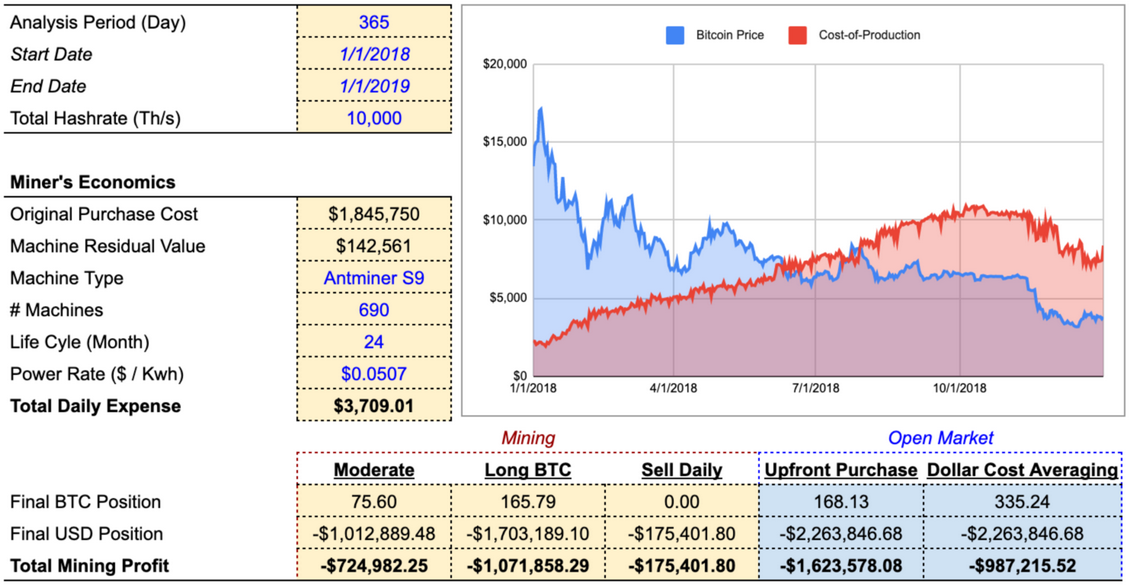
Over the course of the year, daily cost-of-production per coin ($3,709.01 expense divided by the number of coins mined on that day) surpassed market price around July, and kept climbing in the second half of the year, rendering the miner unprofitable for an extended period of time. As we can see from the result, after a year of bear market, the Sell Daily strategy lost the least amount, and the Long BTC strategy took the biggest hit.
This is because Sell Daily is the only strategy that has no unrealized PnL. Every other strategy has long positions to various extent. During the Inventory Flushphase where mining revenue continuously decreases, the unrealized position is very likely to result in a loss at the end of the valuation period.
In practice, sensible miners would have turned off the machines after mining at loss for such a long period of time. If the miner had shut down the operation at the end of June, their loss would have been a lot smaller. If the miner were using the Sell Daily strategy, the miner would even have made a profit:
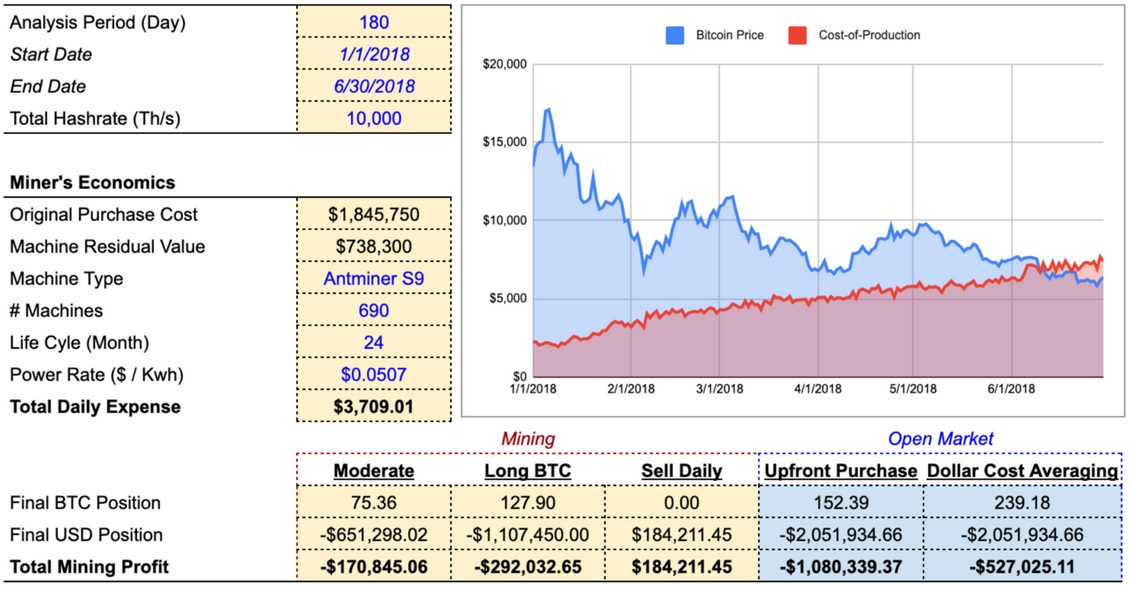
The Moderate and Long BTC strategies would have remained unprofitable, albeit to a lesser extent than open market purchases. The loss primarily stems from capital expenditure of the machines. The miner bought them at $1.84MM, but could only resell them for $738K (not including transaction slippage, transportation, and tax). The gains from the Bitcoin mined did not make up for the hardware depreciation.
In both examples, Sell Daily appears to be the safest strategy. What happens in an opposite phase in the market cycle, where mining revenue continuously increases?
After the Shakeout phase at the end of 2018, the first half of 2019 turned out to be quite festive for miners. Performing the same analysis but from 1/1/19 to 6/30/19, we can see that Sell Daily would have been the least profitable, whereas the aggressive strategies, Long BTC and Upfront Purchase, would have done more than 50% better than the defensive strategy.
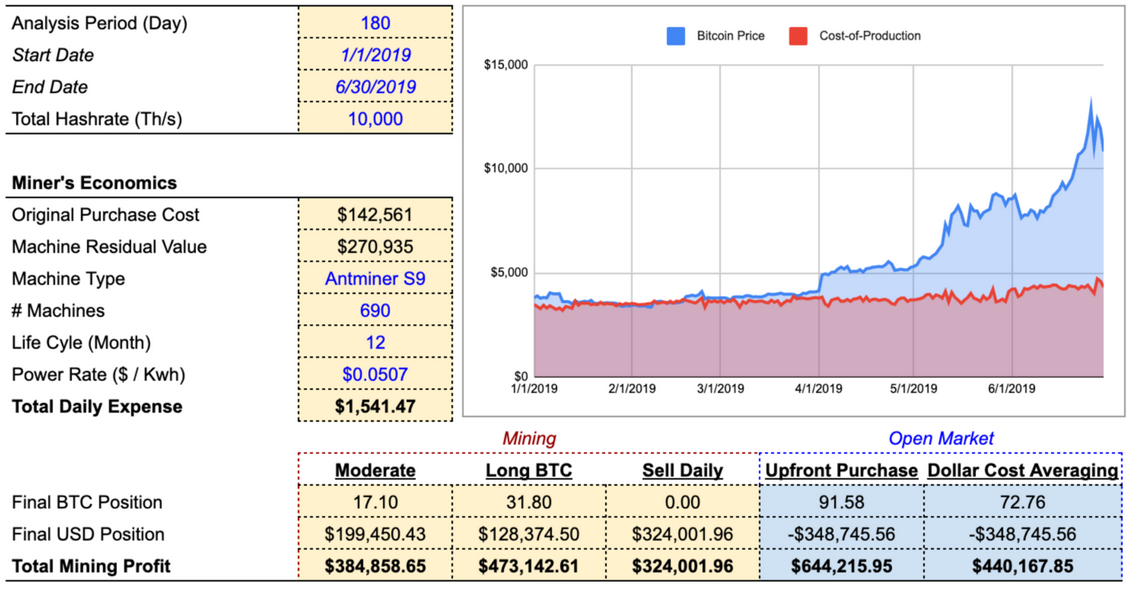
*Life Cycle adjusted to 12 months at the beginning of 2019.
It’s easy to identify the winning strategy with the benefit of hindsight. It takes conviction and deep understanding of the macro conditions to adopt the aggressive strategies when the overall market has been depressed for a while. This especially the case for Upfront Purchase, which requires deploying all the capital on day one.
Mid-2019 was also a transition period where new generation machines became available. It’s common for miners to sell old machines to rotate into more efficient models. In this example, the miners could actually sell the machines at prices higher than their purchase price thanks to the raging price rally.
Hypothetically, if the miner sold all 690 units of Antminer and used the $271k proceeds to purchase new Whatsminer M20 for the second half of the year:
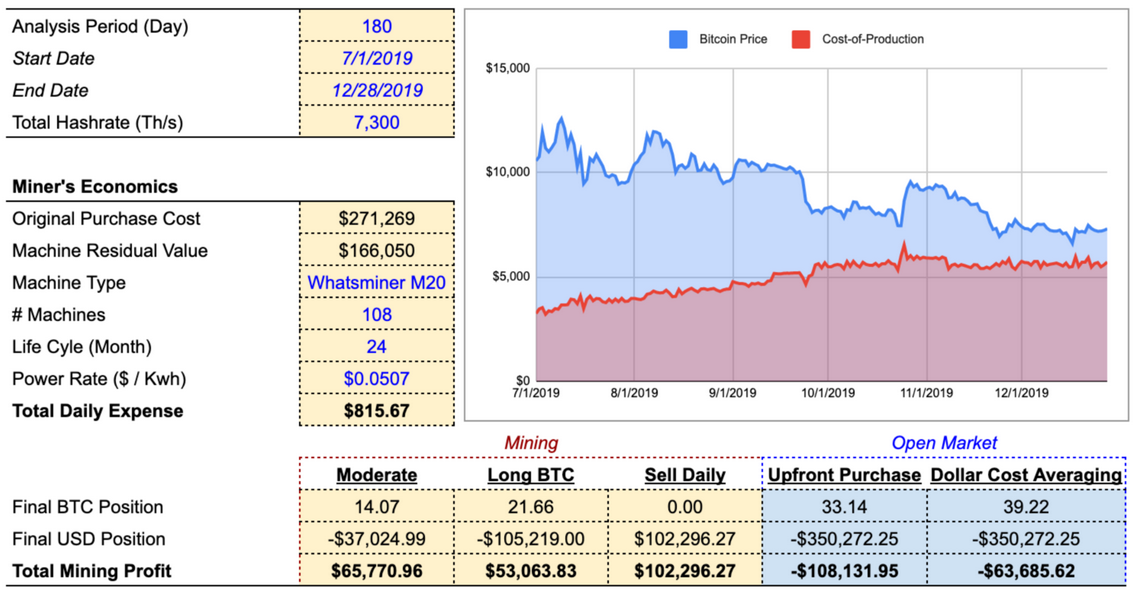
For the entire year of 2019, the miner would’ve made:

Whereas if the miner hadn’t rotated machines, and continued to mine with Antminer S9 for the entire year, they would have left a lot of money on the table:
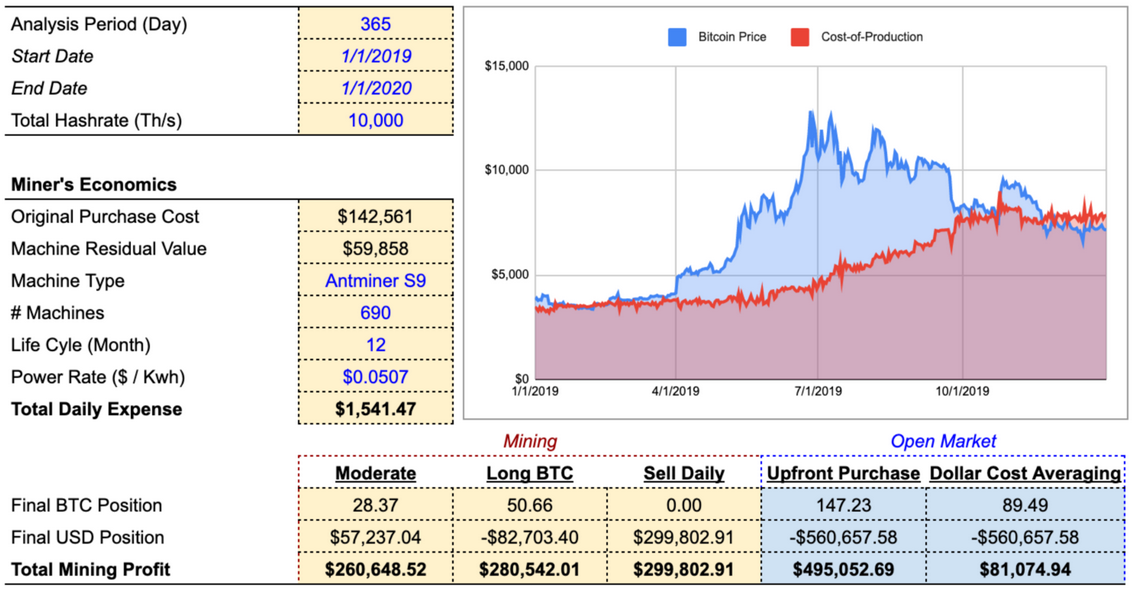
In practice, miners are not tied to a specific modus operandi for the entire mining period. They have the flexibility to change the strategy whenever they think the market trend is shifting. In addition, they can complement mining with trading strategies, or lend out the coins to enhance the yields on the inventory, for instance, the miner can sell and capture profits on days mining profit exceeds cost-of-production, and buy coins on open market on days mining profit is lower than cost-of-production. Using the right combination of strategies during different stages of the mining cycle has a significant impact on the outcome. The purpose of this exercise is not to come up with a generalized winning strategy, or to prove mining is strictly better than purchasing coins, but to illustrate that managing a mining operation is essentially managing a portfolio.
These represent the simplest and most common mining strategies. A lazy miner who only uses one simple strategy throughout all market cycles will extract a different amount of value from hashpower compared to a miner who actively employs multiple strategies. There is an infinite amount of hashpower management strategies, but the manufacturer is going to charge the same price for the machine regardless of the buyer’s strategy. Though price is a realized data point, value depends on the user. Ideally, the price of the machines should represent an average of the distribution of the values of all available strategies, but that is not possible. So how does the hashpower industry price machines? What does the price of hashpower represent exactly? More importantly, how should miners value hashpower in a way that fits their own circumstances best?
Hashpower Pricing Heuristics
In today’s market, the pricing of hashpower is dominated by hardware manufacturers such as Bitmain, MicroBT, and Canaan. They are the only supplier of new hardware, they have full control over the initial issuance of machines that produce hashpower. The manufacturers’ first priority is to cover their expenses, which has less to do with the cryptocurrency market and more with supply chain management. The sale price of their product can be adjusted according to market demand, provided it guarantees a certain margin over its cost of production. Sometimes manufacturers artificially suppress the pricing to outsell their competitors. In short, manufacturers’ pricing does not represent the theoretical fair value of hashpower. It is mixed with business decisions that reflect the state of their own companies.
In part 1 of Alchemy of Hashpower, we discussed that the most popular metric for hashpower pricing is static-days-to-breakeven (DBE). It measures how many days it takes to break even on the machine purchase given the current snapshot price, difficulty, fee, and all-in opex. Every miner has a different DBE on the same machine because every miner runs operations differently. Miners calculate their DBE based on their own all-in cost per KwH and capacity. Manufacturers cannot take all miners’ costs into consideration, so the starting point of their DBE is always a market-wide average all-in cost. This figure is a very rough estimate, since the necessary data is extremely challenging to collect and underlying conditions are constantly changing. Miners with different capacity and cost structure come and go. Manufacturers do this exercise with their best guess on all-in cost, and set the price of the machines based on a reasonable range of the DBE.
But what is the industry-wide all-in cost that they use as the input? We can reverse engineer it with historical machine price data.
Using the Discounted Cash Flow method, we can backtest historical machine prices to find the underlying assumptions when the manufacturers priced the machines. For example, the retail price for an Antminer S9 in January 2018 was $2,675.
Assuming an Antminer S9 life cycle of 24 months, we can map out the historical revenue of a single machine:

Next, we reverse-engineer an all-in cost such that the sum of all the present values of each day’s free cash flow equals the purchase price. Assuming an annualized weighted average cost-of-capital (WACC) of 12.5%, we have:

In order to achieve $1.57 daily expense, the all-in electricity cost for an S9 needs to be $1.57 / 24 / 1.365 = $0.048 per KwH. This means that unless the miner had access to $0.048 per KwH all-in cost or lower, the miner would’ve purchased the machine at a premium. The result above is calculated using Strategy 3, Sell Daily. Replicating the analysis with other strategies, Strategy 1 Moderate requires $0.017 per KwH all-in cost, and Strategy 2 Long BTC requires a $0.01 per KwH all-in cost. This means that in practice the actual “breakeven” all-in rate was within the range of $0.01-$0.048 per KwH.
This is drastically lower than the rate available to most miners at the beginning of 2018. Intuitively that makes sense. At that time the Bitcoin price had just reached all-time-high, the network difficulty was just beginning to catch-up, and S9 was the best machine on the market at that time. The ultimate determinant of price is still the supply and demand.
Applying the same method to machine prices at other points in time, the table below would be the “breakeven” all-in cost for miners. Here the all-in cost is the mean of all three strategies:

From a different perspective, if the industry-wide all-in cost was $0.0507 per KwH, what would be the fair value of the machines at the time? Again, the Fair Price here is the mean of all three strategies:

*Premium/ Discount is Machine Price over Fair Value__(Data source: hashrateindex.com)
Note that this analysis does not take the changes in industry-wide average rate or WACC into calculation, since the precise industry-wide rate and WACC are difficult to estimate.
The point of this analysis is not to find the absolute fair value. As discussed, the fair value is not the same for every miner due to the different operating expenses as well as different strategies. However, even with an assumed industry-wide average rate, we can show how wildly inefficient the machine pricing is. During the bull market the manufacturers significantly overpriced the machines, and during the down markets the manufacturers were forced to liquidate the machines at a discount. This is aligned with empirical evidence we see in the mining market. When price rallies fast, the machine prices sometimes go up faster than the coin price. This behavior diverges from fundamentals, which indicate that machine prices should rise more slowly given the expectation of a future increase in network difficulty. At the end of the day the pricing of the machines is driven by supply and demand, and the hashpower market is highly illiquid.
By backtesting the historical machine prices we can see that pricing heuristics based on Static Days-to-Breakeven are insufficient in capturing the volatility of mining profitability. In order to assess the fair value of the machines today, we need to model mining profitability on a forward-looking basis, with tools or frameworks that can capture the wild fluctuations of the outcomes.
A more advanced approach is to treat hashpower as a form of call option. The principle of this approach starts with treating the mining revenue of a machine as the underlying asset. There are three constituents for mining revenue: price, difficulty, and fees. A call option on Bitcoin price is arcane enough, but a derivative instrument that encapsulates these three elements is far more complex. Describing the Black-Scholes theory for options on multiple underlying assets is straightforward: the additional considerations are the correlated random walks and the corresponding multi-factor version of Ito’s Lemma. However, establishing the correlation matrix between the three variables is a daunting task.
As discussed in the Alchemy of Hashpower series, price and hashpower have a cross-correlation with a varying lag. Due to the reaction delay, when examining the relation between hashpower and price in a short time window, the correlation is de minimis. Hence, it’s tempting to simply model hashrate paths as a process completely independent of price. However, financially hashpower is a derivative of Bitcoin, and on a long enough time scale, the two time-series are positively correlated. On the other hand, transaction fees dynamics is even harder to model. While intuitively on some level transaction fees are connected to price and (inversely) to network hashrate, it is predominantly driven by on-chain activities, which is an exogenous factor. This is why the correlation matrix is not going to have meaningful results.
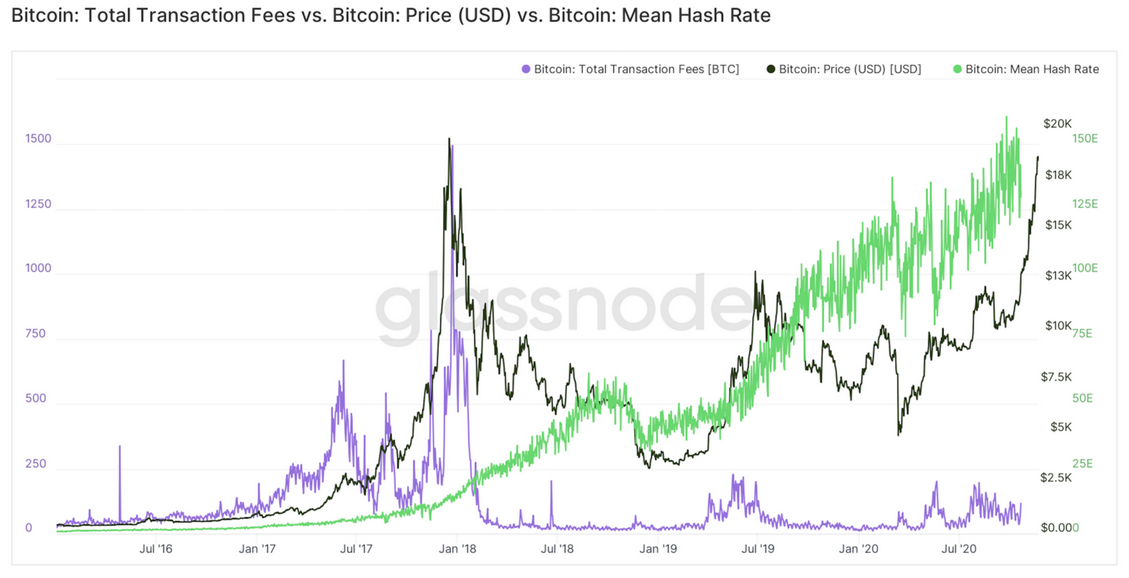
(Source: Glassnode)
But once the assumptions on the distribution of the underlyings have been made, pricing hashpower in a period N is equivalent to pricing a series of zero-strike European call options with daily expiry. In other words, as long as the machine is on, the hashpower is a contract that exercises everyday, and converts into the underlying asset, which is the mining revenue. The cost of the contract is the depreciation of the hardware, plus the operating expenses. The option premium of the entire bundle should in theory be the price of the machine plus the present value of all the operating expenses incurred during period N.

Where:
- V is the fair value of the machine.
- Ci is the call option value with mining revenue as underlying, with expiration on day i.
- T is the daily operating expense.
There is a critical flaw with this approach. Using this formula, the contract on day i and on day i-1 are valued independently. In reality, the payoff on day i-1 should set the initial condition for the contract expiring on the next day. Any hashpower valuation approach based on options pricing and simply sums up all trials in the period will face this path-dependence issue. Every trial will be a disjoint assessment.
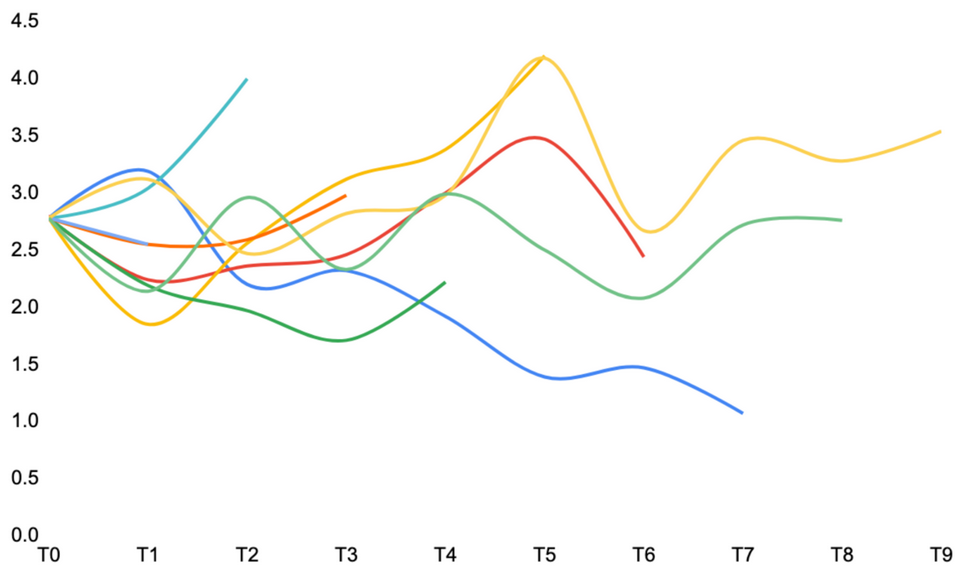
Valuation with Numerical Methods
Path-dependence is not an issue with numerical methods. Rather than valuing each day with 10,000 trials we are using the same 10,000 trials across all of them. Monte Carlo simulation is useful in modeling complex dynamics by generating random numbers. The expected payoff in a risk-neutral world is calculated using a sampling procedure. It is then discounted at the risk-free interest rate. With Monte Carlo methods, we are able to simulate the mining profitability of the latest-generation machines in the next two years, and compare their fair value against their prices on the market today.
As a first step we need to make some assumptions on the trajectory of price. A numerous studies argue that jump-diffusion is the most suitable in describing Bitcoin price distribution. We use a jump-diffusion model to simulate 10,000 possible price runs over the next two years. In a stochastic simulation, every run takes a different path.
A jump-diffusion model has two basic parts: the diffusion (geometric Brownian motion) and the jumps (usually Poisson distribution). For modeling simplicity, we assume that there is a threshold probability for the jumps. When jumps are triggered, the magnitude follows a normal distribution.
Calibrating based on historical price data, we use the following as the parameters for the model:
- Constant drift: 0.10%
- Standard deviation of drift: 2.50%
- Jump probability: 5.00%
- Jump mean: 0.10%
- Jump standard deviation: 5.00%
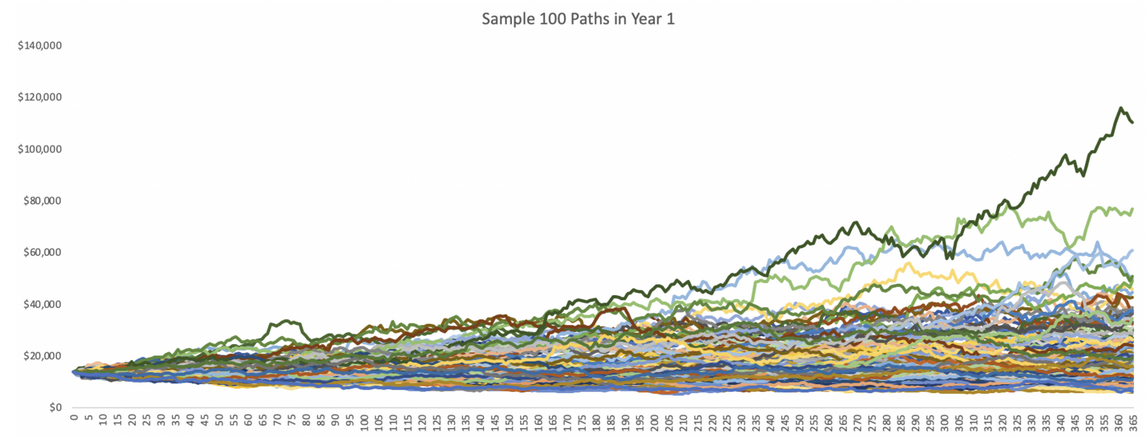
In addition to coin price, we need to project the network hashpower as well to calculate mining revenue. Modeling hashpower is more complicated than price trajectory because not every unit of hashpower is the same. While every miner on the network is computing hashes for the same algorithm, the amount of power consumed varies by machine. The simplified model of the current network hashrate abstracts away the presence of several hardware efficiency classes, each of which behaves differently as the market evolves. Stratifying our model by efficiency class shows us the composition of machines on the market, and therefore allows us to roughly predict how they would evolve over time.
Unlike price data, mining information is extremely challenging to collect. The only way to approach this is to interview as many miners, distributors, and manufacturers as possible. David from General Mining Research surveyed the major manufacturers and distributors in China, and came up with the following estimate of the market composition as of 11/1/2020:
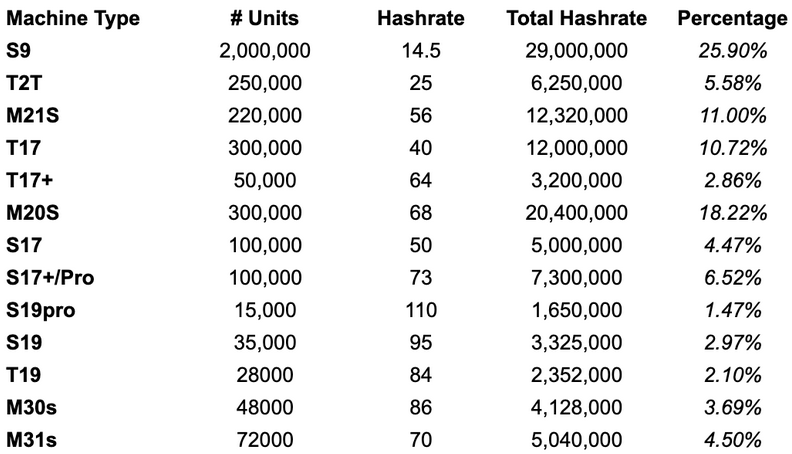
(Source: Proprietary data provided by GMR)
The snapshot serves as the basis for the initial condition of the projection model. Using an estimated industry-wide average all-in electricity rate, we can calculate the breakeven threshold for each layer, and understand roughly how many machines will likely drop should the price fall below the breakeven. Using $0.0507 per KwH as the estimated all-in rate, we can map out four possible scenarios based on different price levels:
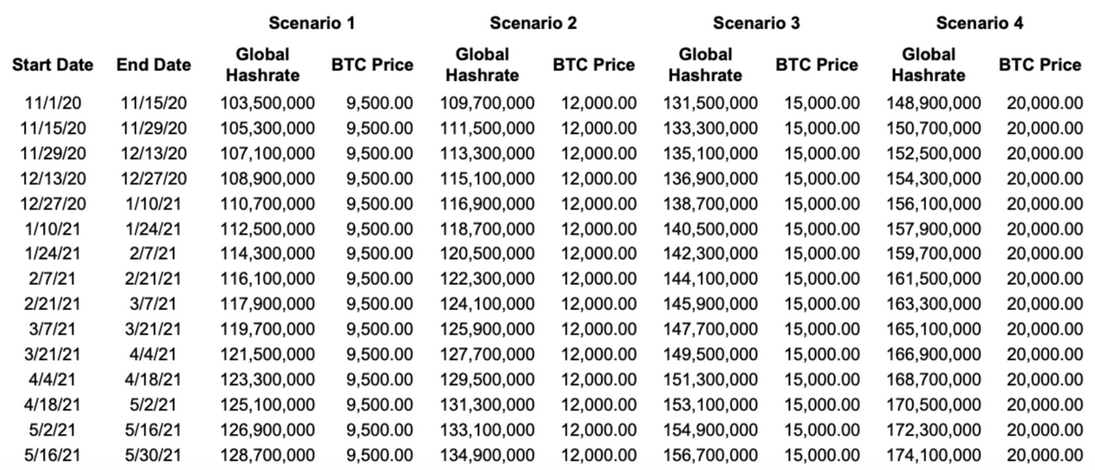
(Source: Proprietary data provided by GMR)
Note that this only provides a baseline view of the hashrate projection. Old, marginally-economical machines sourced via secondary markets may come online and manufacturers may accelerate new production if there is a drastic rally in price.
Based on the scenarios above, we can find a linear function y=4,544x + 6e07 to describe the relation between price and the network hashpower. For simplicity, we assume that for the next six months, hashrate growth follows the function of a 14-day average Bitcoin price with a drift term dW. We set 2.5% mean, and 5% standard deviation as the parameters of the drift term. In addition, based on our estimate of machine sales from manufacturers, we assume hashrate grows by 200 Ph/s a day for the next six months. We mimic the hardware reaction delay by incorporating a constant 20-day reaction delay. This means that hashrate only reacts to price action that at least happened 20 days ago. The full function:

Sample trajectories look like the following:
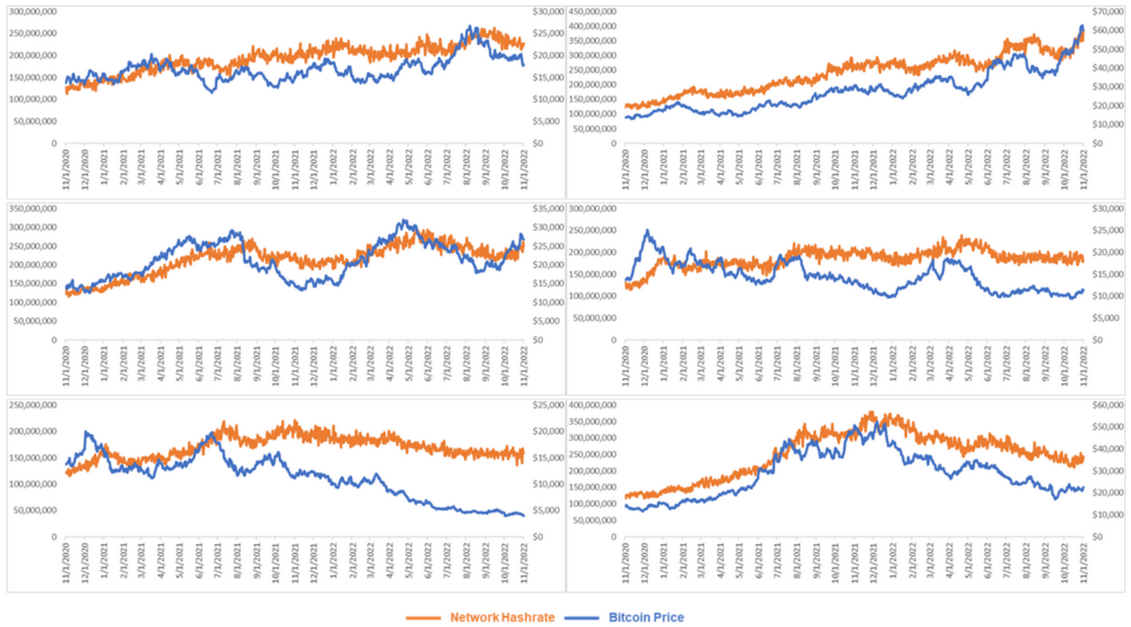
In reality, the relationship between hashpower and price is a messy and complex entanglement. Using a linear function to describe it is like projecting a chaotic system onto a low-dimensional subspace. There are many ways that the function can break. This is the same problem that we describe about the correlation matrix in the option pricing methods. However, this construction allows us to easily incorporate the lag time, and therefore is a significant improvement over assuming hashpower and price as two completely independent distribution. This makes the projection easier to manage.
To further improve our estimates, we can use a Markov Chain Monte Carlo model. Unlike Monte Carlo draws independent samples from the distribution, Markov Chain Monte Carlo draws samples where the next sample is dependent on the existing sample. This addresses multi-dimensional problems better than a generic Monte Carlo simulation. The exact construction of the algorithm is beyond the scope of this article.
Once we have the projections for price and hashrate in the next two years, we can calculate the mining profitability the same way we ran the backtests on the historical hashpower prices. Compared to two years ago, where crypto-backed lending activities were sparse, the lending market today has grown into a massive industry. Collateralize lending is one of the most common services that miners frequently rely on. Evaluating the WACC today, the rate should improve noticeably. We can lower it to 10% instead of the 12.5% in the 2018 analysis.
Using a $0.0507 / KwH all-in cost, and a 10% discount rate, we can generate a distribution of the fair values. The final result is the average of all 10,000 trials. Additionally, we assume that after two years, Antminer S19 Pro and Whatsminer M30s still retain 20% of residual value.
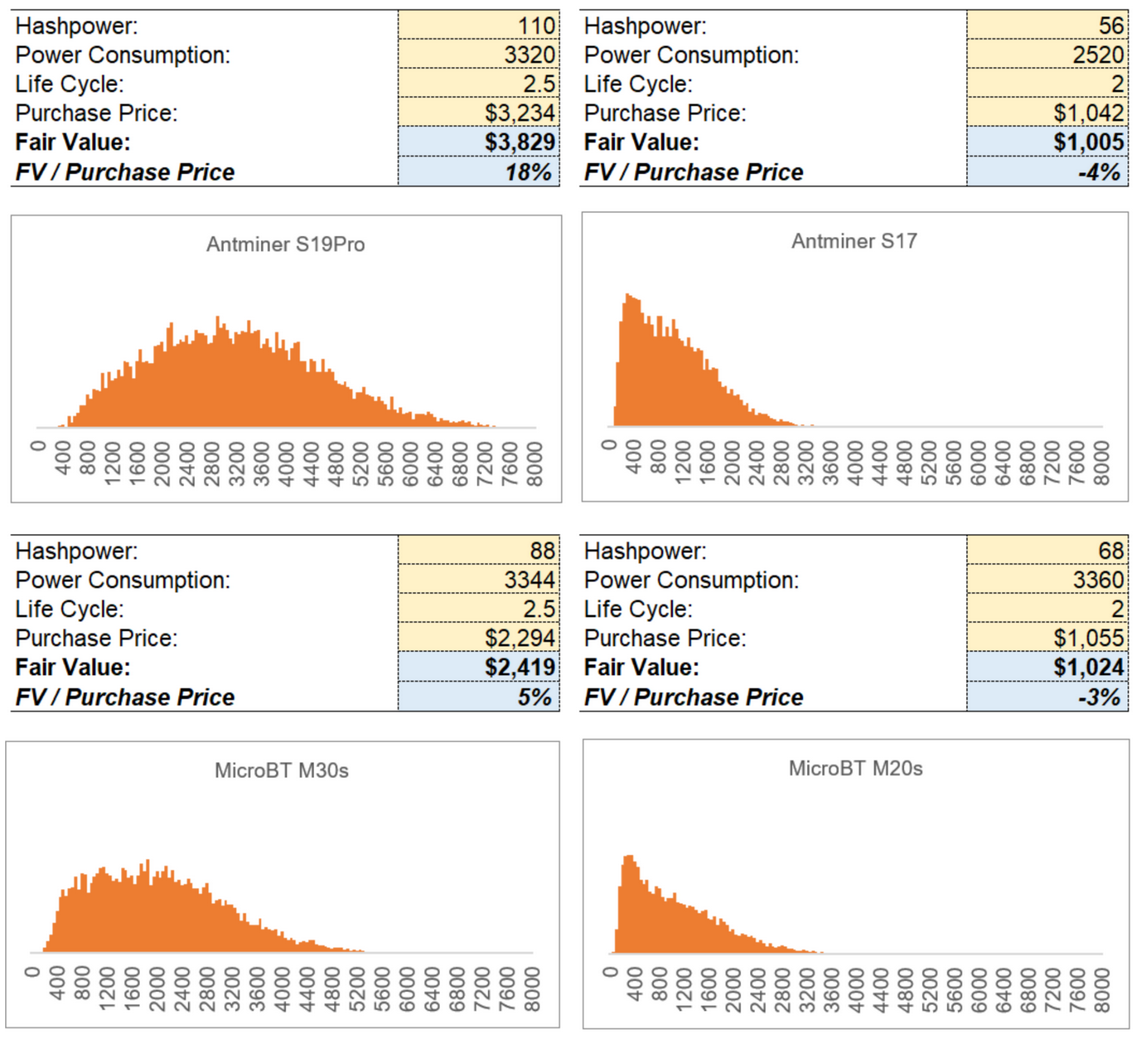
Needless to say, this should not be a final verdict on whether the machines are overpriced or underpriced. The mean and standard deviations in the price distribution, the function between hashpower and price, lag time, all-in cost, discount rate, and residual value are all factors that can drastically affect the outcome of this evaluation. For instance, running the simulation with $0.07 per KwH and with $0.03 per KwH all-in cost:
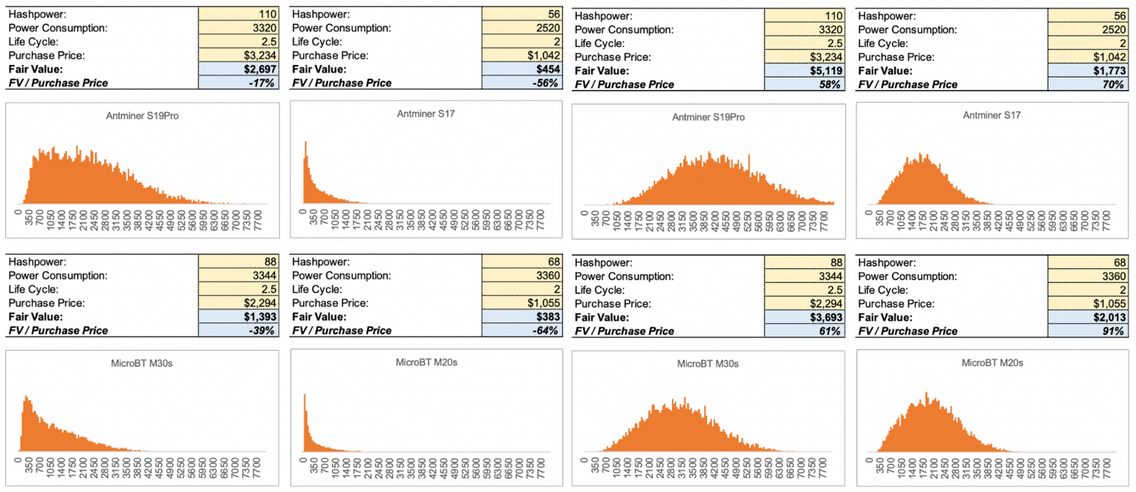
We can see that when the all-in cost is high (left), the prices of the more efficient machines (Antminer S19 and Whatsminer M30s) are closer to their fair value than the lower tier machines. When the all-in cost is low (right), the pricings of the less efficient machines (Antminer S17 and Whatsminer M20s) are more favorable. This shows that if the all-in expense is competitive enough, the miner can benefit from operating less efficient machines.
In our model we built a switch that turns off the machines if the mining revenue is consistently below expenses for 14 days. In the real world, miners don’t frequently turn machines on and off based on short-term profitability. Most of the time miners have agreements with the datacenter host that they need to consume a minimal amount of power every month. Even after profitability drops below zero, most miners tend to wait for a downward trend to confirm before taking actions. Due to the labor-intensive nature of datacenter operations, and the illiquidity of machine market, miners are forced to observe longer term trends instead of short term price actions. In recent years, the rise in the volume of lending service providers also strengthened miners’ ability to endure through winters. Miners can collateralize their coins or machines to borrow fiat to pay for expenses, rather than selling a great quantity of coins. Nonetheless, this is a theoretical lower bound on mining loss. Miners cannot lose more than the capital expenditure plus the cumulative operating expense.
Like call options, the more volatile the underlying index is, the higher the theoretical value of the instrument. We can see how the results change as the parameters of the jump-diffusion model changes. When volatility is suppressed, the theoretical value of the machines drastically decreases. When volatility is high, the theoretical value rapidly increases:
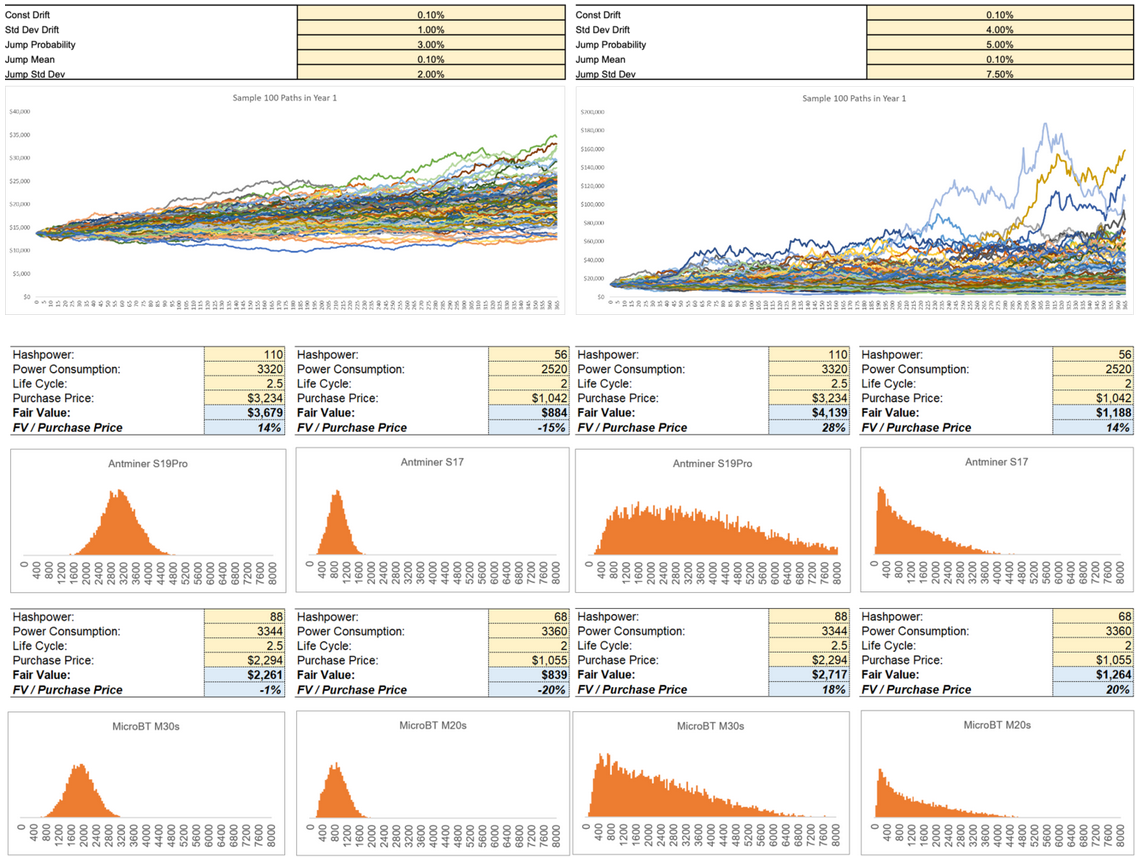
*Based on $0.0507 per KwH all-in cost
This analysis is based on Strategy 3 Sell Daily. Same as the backtesting analysis, the fair value that can be “unlocked” by running hashpower is within the range of FV(Strategy 1, Strategy 2, Strategy 3). Given that the Monte Carlo simulates 10,000 paths, each with a very different path, running one strategy alone should be sufficient to cover every type of market phase.
A Future without Block Rewards
Another variable that has a significant impact on mining revenue is the fees. Assume fees grows linearly by 5% and 10% a year, fair value of the machines would noticeably increase:
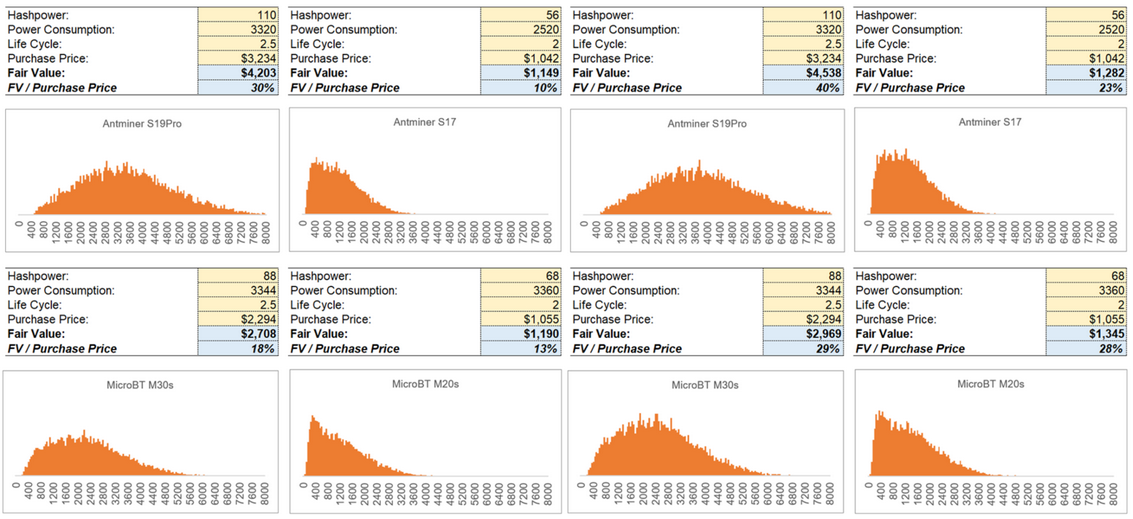
*Based on $0.0507 per KwH all-in cost
In reality the fee trend is much more sporadic, and its connection to other endogenous variables is less obvious. Modeling fee trends requires an entirely separate distribution. In addition, there are many ways to improve the accuracy:
- As discussed, use Markov Chain Monte Carlo to alleviate the curse of dimensionality,
- Introduce dynamic lag based on the four archetypal market cycles, use a poisson process to model the jumps.
- Use a hashrate-weighted average all-in cost instead of industry-wide median cost.
- Use statistical methods to calibrate the parameters
- Use machine learning tools to describe the relationship between hashpower and price.
- Incorporate fee projection in mining revenue calculation.
- Adopt agent-based simulation for miner behaviors. Agent-based modeling is a technique for modeling complex systems to gain a deeper understanding of system behavior. It is widely used in high-frequency trading, or smart contract risk analysis. Under this framework, every miner is a “user” with different strategies and different cost basis. We can then define some simple reaction types (buy more machines, sell machines, buy more machines but wait for 30 days etc.) and build a library of “user behaviors”. This would allow us to simulate much more complex interactions in the hashpower market. For more background, read about Conway’s Game of Life.
Myron Scholes said, “all models have faults - that doesn’t mean you can’t use them as tools for making decisions.”
Like the Black-Scholes model, the simulation model is a mechanism that, in trying to reflect the actual world in a short description, simplifies its intricacies. This reduction makes the model usable but simultaneously limits its usefulness. It’s important to understand where its limitations are, and that the simulations only represent possibility not certainty.
Nevertheless, the model is a baseline for users who have already formed a view on the market. Like any forecasting model, the simulation will only be as good as the assumptions the user makes. One uses modeling tools to turn those opinions about the future into an appropriate price today for something that will be exposed to that version of the future.
Why is this important? What’s the point of developing asset pricing theory in a market that is clearly driven by supply and demand?
Valuation is more than just a theoretical exercise. For Bitcoin, once mining becomes completely reliant on fees, competition yields razor-thin margins, and there is not a single element in mining revenue calculation that is predictable, how do we make sure miners keep producing hashpower? The answer is to maintain stability of continuous investments into mining hardware to augment the security budget of the network. This is critical because without enough hashpower, the whole system is susceptible to attacks, rendering Bitcoin’s settlement assurance worthless. A rigorous valuation framework is the first step in testing a broad range of assumptions and market behavior and planning accordingly. Valuation is the foundation of proper risk management for mining institutions that are becoming too-big-to-fail. The purpose of this exercise is to start a dialogue that focuses on this general direction. We will continue working to further our framework for years to come.
Tweet Storm - About Schnorr Sigs
By Ben Carman
Posted November 22, 2020
0/ For #TaprootWeek today we are going to talk about adding Schnorr signatures to #Bitcoin, why they are great, what optimizations we can get with them, and we’ll tease the cool applications they can enable.
👇👇👇
1/ First let’s start out with hopefully what you ask yourself first about a new digital signature schema: are Schnorr signatures actually secure?
In short, Yes.
Today Bitcoin uses ECDSA for signatures which we must obviously consider secure.
2/ It turns out Schnorr signatures can be considered slightly more secure as their security proof has less assumptions than ECDSA and no new ones! So if we consider ECDSA secure, then Schnorr must be secure as well!
3/ If you want to get in deep with the actual security proof I recommend checking out waxwing’s blog on the subject
4/ So, Schnorr is secure, but why do we want them?
Switching to Schnorr signatures can actually gives a lot of efficiency gains, both in block space as well as in actual computation time.
Let’s talk about block space first 5/ Digital signatures generally consist of two 32 byte numbers, so naturally you’d think a signature is 64 bytes. Well sadly today in Bitcoin that is not the case, they are actually around ~72 bytes. This is because bitcoin currently uses something called DER encoding.
6/ DER encoding requires we add a few extra bytes around our two 32 byte numbers which in general isn’t necessary for Bitcoin because we don’t need to support multiple types of signature encoding for each signature schema.
7/ DER encoding isn’t anything fancy or necessary it is just a result of the design decisions Satoshi made when initially creating bitcoin likely because of the use of the OpenSSL library.
If you want to know more I recommend reading BIP 66:
8/ Getting back to Schnorr, since we are adding a new signature schema to the protocol we can also define a new way to encode these signatures. So, what we are doing is just putting the two 32 byte numbers next to each other resulting in a smaller 64 byte signature.
9/ Another way we can save block space by using Schnorr signatures is something called key aggregation, better known as MuSig. With key aggregation we can have one public key represent an arbitrary number of signers.
10/ Key aggregation is a HUGE win because today any multisig contract today requires a key and signature (in total ~100 bytes) for every signer which can get very expensive. Reducing this to a single key and signature will save users on lots of block space and thus on fees!
11/ The last and smallest gain we get is from switching to 33 byte public keys to 32 byte public keys. This isn’t a huge gain, but with us switching to a whole new signature schema we can now store the public keys in the most compact way being 32 byte keys!
12/ That entails the primary ways that we save on block space by using Schnorr: smaller public keys, smaller signatures, and key aggregation.
Now, let’s move on to the computation efficiency gains.
13/ With Schnorr Signatures we can batch verify signatures.
Today with ECDSA we need to take each signature and verifying them individually that they are correct. This is generally fine for something like checking a new transaction in your mempool but not ideal for an IBD.
14/ Today Bitcoin has had ~589 million transactions all with at least one signature. This is a lot to verifying and optimizing this verification can help a lot with bootstrapping new nodes doing an initial block download.
15/ With Schnorr we can take batches of signatures and verifying them together saving a lot on computation time. In BIP 340 @pwuille has a graph showing the actual improvements.
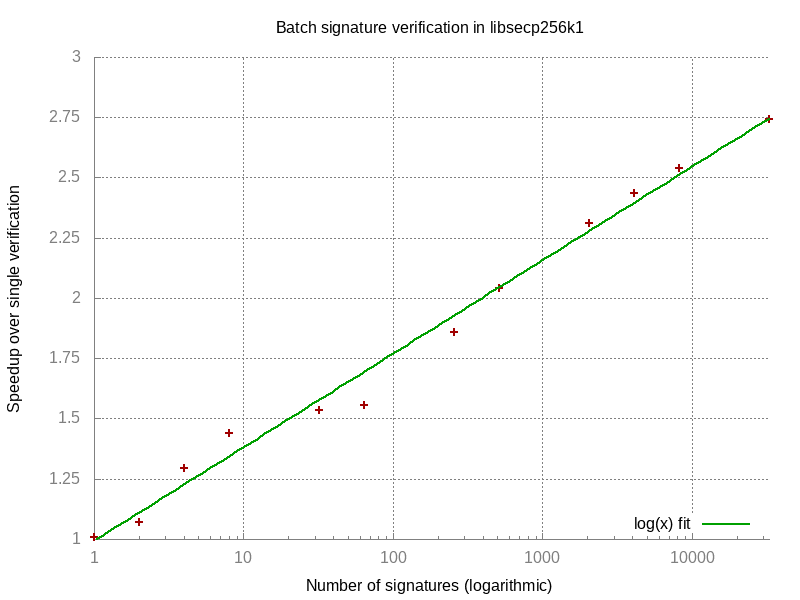
16/ To further quantify this improvement, let’s say it takes 1 unit of time to verifying a signature.
Today without batch verification it takes n units of time to verifying n signatures.
With Schnorr and batch verification, to verifying n signatures will instead be n/log n
17/ Those are the majority of the base improvements of adding Schnorr signatures to Bitcoin. There are a lot of cool things we’ll talk about tomorrow on different applications they enable and you’ll see later how Taproot itself benefits from using Schnorr as well!
An Open Letter to Friends and Family
By James O’Beirne
Posted November 29, 2020
Friends and family,
Dispensation of unsolicited financial advice is a tricky thing. It’s not something I’m prone to naturally, and it’s a good way to look foolish.
That said, here I am.
I’ve weighed the risk of seeming uncouth against a desire to see the people I care about share in a major success. The prospect of a great return on an investment is a nice thing, but to see such a return along with many of the people you care about is wholly better.
I’ve personally benefited from keeping an eye on Bitcoin since 2014. I wrote some of you a similar letter in 2017, back when a coin cost $3,582 (as I write now it’s $17,810). The depth of my belief led me to make Bitcoin my full-time job in 2018.
But what’s more important – and the cause for this email – is that I have good reason to think that a big price movement is coming in the next year.
From Nasdaq. I don’t think this is a hyperbole.
I have two takeaways:
- There is a high likelihood that the Bitcoin price will approach or surpass $100,000 per coin within the next year.
- You should own some Bitcoin not just for the mid-term price appreciation, but to safeguard against the enormous economic changes that are set to unfold over the next five years.
In brief, Bitcoin is poised to rise in value because we are in uncharted territory. A countermeasure against currency devaluation is becoming more important than ever as the Fed (and every other central bank around the world) creates record amounts of new money to keep the economy on life support. Historically gold has been the go-to defense for this scenario, but Bitcoin is quickly replacing it as a much more practical alternative.
Hedge funds and money managers are quickly realizing this.
It should go without saying that my conviction carries through to my portfolio. I am over 90% in Bitcoin and continue to buy regularly.
In this mail I’ll briefly talk about the backdrop for Bitcoin’s rise, and why we’re at a critical inflection point in our money system. I’ll talk about how I value Bitcoin, and the reason next year is going to be so crazy.
As you may know, our country’s federal debt has been steadily accumulating over the past few decades to levels that will make repayment impossible. COVID-19 has kicked this expansion of debt into hyperdrive.
The nation’s debt has exploded to 140% of GDP as the government has been faced with the impossible dilemma of both fighting the virus and preventing the country from suffering permanent economic harm. The government’s answer so far, in brief, has been to turn on the printing presses while keeping everyone at home. I’m not here to make moral assessments of this solution, it is what it is.
Since untethering the US dollar from gold in 1971 (yep, production of dollars used to be limited by a physical commodity) the government has been able to produce currency at unlimited rates. Most people don’t realize that this is a 50 year old experiment involving money whose supply is not limited by anything.
There’s much more to say on the macroeconomic backdrop of Bitcoin’s rise, but it’s too in-the-weeds for many and so I won’t include it here. If you want more information, you can read my article Bitcoin for Safety.
Nearly all of Wall St. realizes that the government has no option but to print big and keep at it indefinitely. Most have decided to shove capital into the stock market to protect their money, which explains the bizarre rise of stocks in light of the country being in a dystopic pandemic-driven lockdown.
Large businesses are increasingly coming to a similar conclusion. You may have heard recently about a tech company that invested the majority of its cash treasury ($500 million) into Bitcoin.
Michael Saylor, MIT grad and founder/CEO of MicroStrategy, realized that the purchasing power of his company’s cash reserves was eroding at a rapid clip. In recent weeks he has spoken at length about the importance of Bitcoin and its uniqueness over any existing asset class.
Payments processing company Square has also adopted this rationale and has started to put some of their cash into Bitcoin.
This will become increasingly common among businesses concerned about the effect of rapid inflation on their cash balances. Because Bitcoin’s supply is limited and discovery of new Bitcoins is becoming less and less frequent over time, this heightened demand will do things to the price of Bitcoin that seem unthinkable now.
Bitcoin is the only asset ever to have a truly fixed supply. Even great works of art can be fabricated. It’s difficult to think through the implications of a truly fixed supply since we’re used to companies issuing more shares or governments printing more dollars. This can’t happen with Bitcoin, which is what causes the price to do outrageous things.
Money managers are beginning to realize this. Some of the biggest names in finance have come out in the past weeks expressing support or positive curiosity over Bitcoin.
Raoul Pal, noted investor and founder of Real Vision (“the Netflix of finance”), calls Bitcoin “the only trade” right now. He is “irresponsibly long.”
I’ve linked to a video Raoul did about his thoughts on Bitcoin at the end of the email.
Paul Tudor Jones, one of the most successful hedge fund managers alive, has recently come out in strong support of Bitcoin. He has 2% of his assets invested.
Paul said
“Back in March and April, it became really apparent, given the monetary policy that was being pursued by the Fed, the incredible quantitative easing they were doing and other central banks were doing, that we were in an unprecedented time,” he explained. Noting additional problems brought about by the Covid-19 pandemic, he said, “one had to begin to think about how you defend yourself against inflation.”
“I came to the conclusion that bitcoin was going to be the best of inflation trades, the defensive trades that you would take.”
Examining the overall market caps and characteristics of all inflation trades, he said that bitcoin has “a very small coterie of people investing in it, it was portable, it was liquid, had a variety of characteristics that made it a great inflation hedge.” While Jones pointed out that “The one thing it [bitcoin] didn’t have is it didn’t have integrity and long-term staying power,” he emphasized that “every day that goes by, of course, it gains on that. It gains on credibility and integrity.”
Stan Druckenmiller, another Wall St. luminary, has revealed he’s buying Bitcoin recently. Stan’s fund, per wikipedia has “post[ed] an average annual return of 30 percent without any money-losing year” for 30 years.
Raoul Pal remarked that “the significance of the world’s greatest and most respected money manager - Stan Druckenmiller - saying just now that he is long bitcoin can not be overstated. That has removed every obstacle for any hedge fund or endowment to invest.”
The point is, this narrative is spreading quickly through the finance community. Bitcoin is in the early days of being accepted as the successor to gold at a time when the role of gold is increasingly critical for protecting wealth.
If you take gold’s (conservative) market cap of $7 trillion and divide that over Bitcoin’s 21 million fixed supply, you get a price of $333,333 per coin. Even assuming Bitcoin takes just 10% of gold’s market cap, that’s $33,333 per coin.
Gold is venerable but outdated - I’ve bought and sold a lot of it in the past year, and obtaining physical gold and then selling it was an absolute pain. Bitcoin is way more practical.
And replacing gold is just the start. Bitcoin isn’t just a better gold; because of its programmability, it’s a platform that will host the future of money. It will disintermediate many core functions in finance.
You might have questions like “if Bitcoin is digital, how can there only ever be 21 million? Can’t anyone just copy the source code and make their own Bitcoin?”
I’m happy to do a follow-up on why Bitcoin is scarce, but I don’t want to belabor details here that most might be uninterested in. As a relative expert in computers, I can say that Bitcoin is a genuine technological breakthrough and it is indeed scarce. There will only ever be 21 million.
So why is Bitcoin on the rise in the next year? Why are you sending me this email now?
The “new” narrative about Bitcoin circulating among finance professionals isn’t the only thing at work here. There is an inherent property of Bitcoin that creates a recurring cycle of demand called the “halving.”
Every four years, the rate at which new Bitcoin is discovered halves. Since 2009, this has created a roughly four year cycle that results in a wild price run-up about a year after the halving (which most recently happened a few months ago).
The effect of the halving is that there is less Bitcoin to be sold as demand is held constant or increases. That causes the price to shoot up. Which causes demand to shoot up. Which causes price to shoot up. Which …
We are on the orange line right now. Note that this is a log-scale chart and if Bitcoin follows previous trends, we’re looking at a coin price in the $200k-$300k range.
We are on course for some wild price appreciation in the next year, and I wanted to make sure to send out this warning before the fireworks start in earnest. Bitcoin might reach upwards of $120k per coin during this cycle. Some speculate that because of acceptance from the traditional finance crowd, this may be the last such cycle and the price just won’t come back, as it has in previous seasons.
Bitcoin as diversification
It took me a while to understand that this moon math is credible, so I get it if you don’t take it seriously. (You’ll see over the next year.) If not, you can simply think of Bitcoin as an excellent portfolio diversifier.
Bitcoin is one of the few financial assets you can buy that has been shown to be uncorrelated to other asset classes.
Easy for you to say all this - you bought Bitcoin when it was $200.
When I first bought Bitcoin, I bought the top. The year was 2014 and I bought Bitcoin for around $1,000 a coin. Then it “crashed” to $200 and stayed in that range for years. I looked like an idiot. But I kept buying, because I understood many of the mechanics I outlined above.
In 2016 and 2017, I piled into Bitcoin as the price broke all-time highs of $1,200 and shot up to $20,000 over the course of the year. It crashed down to $3,000 and while I did some ill-advised trading and lost some Bitcoin, I kept buying.
When the price was at $19,000 last week, I was buying. I’ve sold other assets to pile into Bitcoin at these prices. They may seem high, but in a year they’ll look like a bargain. People will be talking about how you could once buy $20,000 Bitcoin in the same way that I just mentioned that there was a day when I was buying $200 Bitcoin.
I regret every sale of Bitcoin I’ve made so far.
What are some other good resources?
- (3 minutes) Finance bro Anthony Pompliano explaining new demand for Bitcoin on CNBC https://www.youtube.com/watch?v=i5wv6i71Its
- (8 minutes) Michael Saylor of MicroStrategy on CNBC on why the company put $500M in Bitcoin https://www.youtube.com/watch?v=CxnNoqbSLGo
- (30 minutes) Raoul Pal on “The Bitcoin Life Raft” https://www.youtube.com/watch?v=qL2LfVRl3J0
- (1 hour) a longer discussion with Michael Saylor: https://www.youtube.com/watch?v=t_nVYtoiShg
- “Misconceptions about Bitcoin” by investment advisor Lyn Alden, published a few days ago https://www.lynalden.com/misconceptions-about-bitcoin/
- My article, Bitcoin for Safety: https://jameso.be/2019/08/24/bitcoin-is-for-this.html
Okay, how can I buy a little?
I recommend allocating anywhere from 1-5% of your portfolio to Bitcoin. This is low enough that you can ride out any price swings and hang on for the long-term, but high enough that you’ll be exposed to any massive upside.
I personally recommend River.com. If they aren’t available in your state, Coinbase.com is a fine choice. Or you can use Square’s Cash app for small-ish purchases. I haven’t tried SwanBitcoin.com yet but it seems good.
If you are going to be buying and holding a sizable chunk of Bitcoin (say over $10,000) you should really consider custodying it yourself with what’s called a “hardware wallet.” I’m happy to help any of you with this, just send me an email.
My advice is not to wait. There were many people who thought the price was just a little too high at $200, $1,200, or $12,000 and decided to wait for a pullback that never came.
In closing
I’m relieved to be finishing and finally distributing this email. I don’t particularly like giving sales pitches, but it has weighed on me that I haven’t sent out an email like this earlier. I want to encourage participation in what is not only the emergence of a new financial asset class that I think will perform tremendously, but a defense against some very strange times to come.
If I can answer any questions, let me know.
James
Tweetstorm - Bitcoin and the power of incentives
By Brandon Quittem
Posted November 14, 2020
1/ A quick thread about #Bitcoin and the power of incentives.
For Bitcoin to reach global dominance, it must inspire a vibrant ecosystem of allies.
“Show me the incentives, and I’ll show you the outcome.”
Let’s go 👇
2/ Bitcoin attracts new users for many reasons
- Get wealthy
- Stay Wealthy
- Preserve Freedom
- Minimize violence
- Empower the poor
- Increase prosperity in the world
Users are incentivized to defend the network, improve the network, and onboard new users to the network
3/ Investors buy Bitcoin to generate wealth.
“Bitcoin was designed to pump forever” - @matt_odell
Bitcoin is the best trade of the century. Will be obvious in hindsight. Massive wealth transfer coming.
4/ Billionaires need Bitcoin to protect their wealth.
They have a lot to lose & they’re vulnerable to confiscation. Bitcoin is insurance against collapse, confiscation, or a greedy state.
Billionaires make powerful allies in the battles that come.
5/ Bitcoiners adopt Bitcoin because it’s the right thing to do Current system is broken. Bitcoin shifts power from incumbents Rightwards arrow an intolerant minority of cypherpunks, polymaths, freedom maximalists, and first principle thinkers. Bitcoiners will build a better world.
6/ Corporations need Bitcoin to protect their balance sheets.
While governments compete to devalue their currency, many corporations cannot generate a positive return on capital. Bitcoin protects the treasury.
7/ Freedom lovers adopt Bitcoin to protect liberty.
Bitcoin is a 10x improvement over existing property rights. Shifts power away from the state and towards the individual. Enables the rise of the Sovereign individual.
cc: @hasufl
8/ Pensions need Bitcoin to generate a positive yield.
With mounting unfunded liabilities, $17t in negative-yielding bonds, and few options for positive yield…
Money managers will be forced to buy Bitcoin. It’s their only hope.
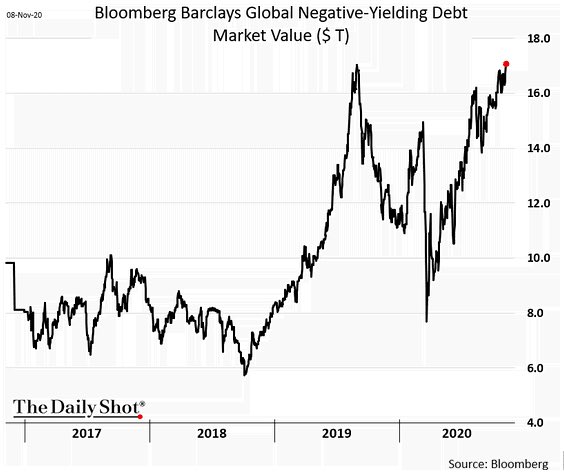
9/ Millenials need Bitcoin or they’ll “have fun staying poor”
Millennials have been dealt a bad hand by older generations. The 2020s will make things worse. Bitcoin is their best chance to generate wealth
Bitcoin will eat the SoV premium on real estate, enabling home ownership.
10/ Tech companies leverage Bitcoin to defend their moat
Money is being reinvented. Companies are scrambling to acquire territory on the new frontier. Square has an early lead (@CashApp), PayPal has entered the game.
When Apple, Google, Microsoft, and Facebook?
11/ Normal people use Bitcoin as a savings technology
Rather than staying wave-slaves, normal people can store the fruits of their labor in an asset that preserves their time & energy.
12/ Ostrisziced nations need Bitcoin to trade
The dollar hegemony excludes enemies from participating in the global financial system. Bitcoin is an open financial system, accessible to all.
Example: Iran is paying for imports by monetizing energy assets through Bitcoin mining.
13/ Banks adopt Bitcoin to stay relevant
Old banking is dead, digital mobile banking (Cash app, etc) is the future. CBDC’s are coming. Low-interest rate environments squeeze commercial bank margins.
Jamie Dimon should have stayed humble and stacked some sats.
14/ Humanitarians adopt Bitcoin to empower the disenfranchised
Billions of individuals don’t have access to basic financial services (or are opressed by their gov)
Entrepreneurs like @raypaxful leverage Bitcoin (and other tools) to “bank the unbanked” in developing countries.
15/ Politicians support Bitcoin because their constituents demand it
As more citizens own Bitcoin, they’ll elect more representatives who support Bitcoin.
When powerful people own Bitcoin, they ensure favorable laws.
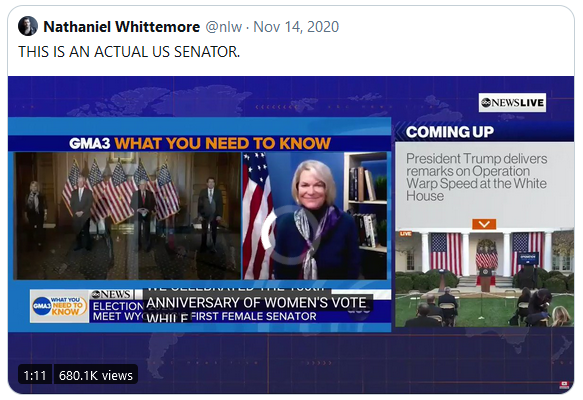
16/ Boomers need Bitcoin to protect their net egg
Pensions and Social Security are underfunded. Boomers need Bitcoin to retire with peace of mind.
17/ Governments will adopt Bitcoin as a hedge against currency failure
Just as governments and central banks hold Gold today, Bitcoin will serve as a hedge against state failure.
Small nations will adopt Bitcoin to leapfrog ahead of nocoiner nations.
18/ Environmentalist will adopt Bitcoin to preserve the planet
The fiat system produces massive negative externalities on the environment.
Bitcoin reduces flared methane, reduces waste, incentives R&D for low-cost energy production, and minimizes fiat externalities.
19/ Americans adopt Bitcoin because it preserves “American Values”
Bitcoin is a tool that empowers an individuals’ life, liberty, and the pursuit of happiness.
What’s more American than that?
20/ Cyber Hornets protect Bitcoin because it enables a better world.
Driven by curiosity, seeking truth, and fighting for freedom, the cyber hornets defend the network at all costs.

21/ What else (besides Bitcoin) aligns humanitarians, billionaires, governments, environmentalists, and cyber hornets?
Each group offers unique advantages that strengthen the network.
Each marginal users improves the chance of success.
22/ “Show me the incentives and I’ll show you the outcome.”
Bitcoin is a force of nature that systematically aligns the incentives of the human race.
Bitcoin’s global dominance is all be guaranteed.
END/ Thanks for the inspiration.
@Breedlove22 @michael_saylor @matt_odell @hasufl @nlw @raypaxful @JeffBooth @chamath @MartyBent and many more.

